__________
• DON THOMAS CONFIRMS REDWOOD'S ABILITY TO ACHIEVE A TREE-FORM:
Don Thomas is a Torreya Guardian (in Los Gatos, California) who particpated in 2022 in the first intentional "assisted migration" of the California Torreya tree (Torreya californica) into the Pacific Northwest (Vancouver, BC). In 2023 he told Connie Barlow:
"Regarding cutting propagation of coast redwoods, my very first job after college in the mid-1970s was at a non-profit nursery called the Saratoga Horticultural Foundation.... This institution was set up to introduce into horticulture new varieties of plants better adapted to California. I remember that among the trees we grew were cutting-grown cultivars of Sequoia sempervirens, including Sequioa 'Santa Cruz', Sequoia 'Los Altos' and Sequoia 'Aptos Blue'. The different varieties had different colors of foliage and different growth forms and allowed uniform-looking plantings of redwoods. As I recall, it was possible to train all of these clonal cutivars into upright symmetrical trees. But I think they were slower growing than seedling trees and did not grow as tall. I discovered that these varieties are still being propagated and sold by a nursery in North Carolina.
"I could not contact the Saratoga Horticultural Research Foundation because it disbanded in 2006 and donated all of its assets to UC Davis. But I was able to locate a planting of one of the selected varieties, Filoli Blue, on the Stanford campus. I've also attached a photo I took recently of one of the trees." SEE PHOTOS BELOW:
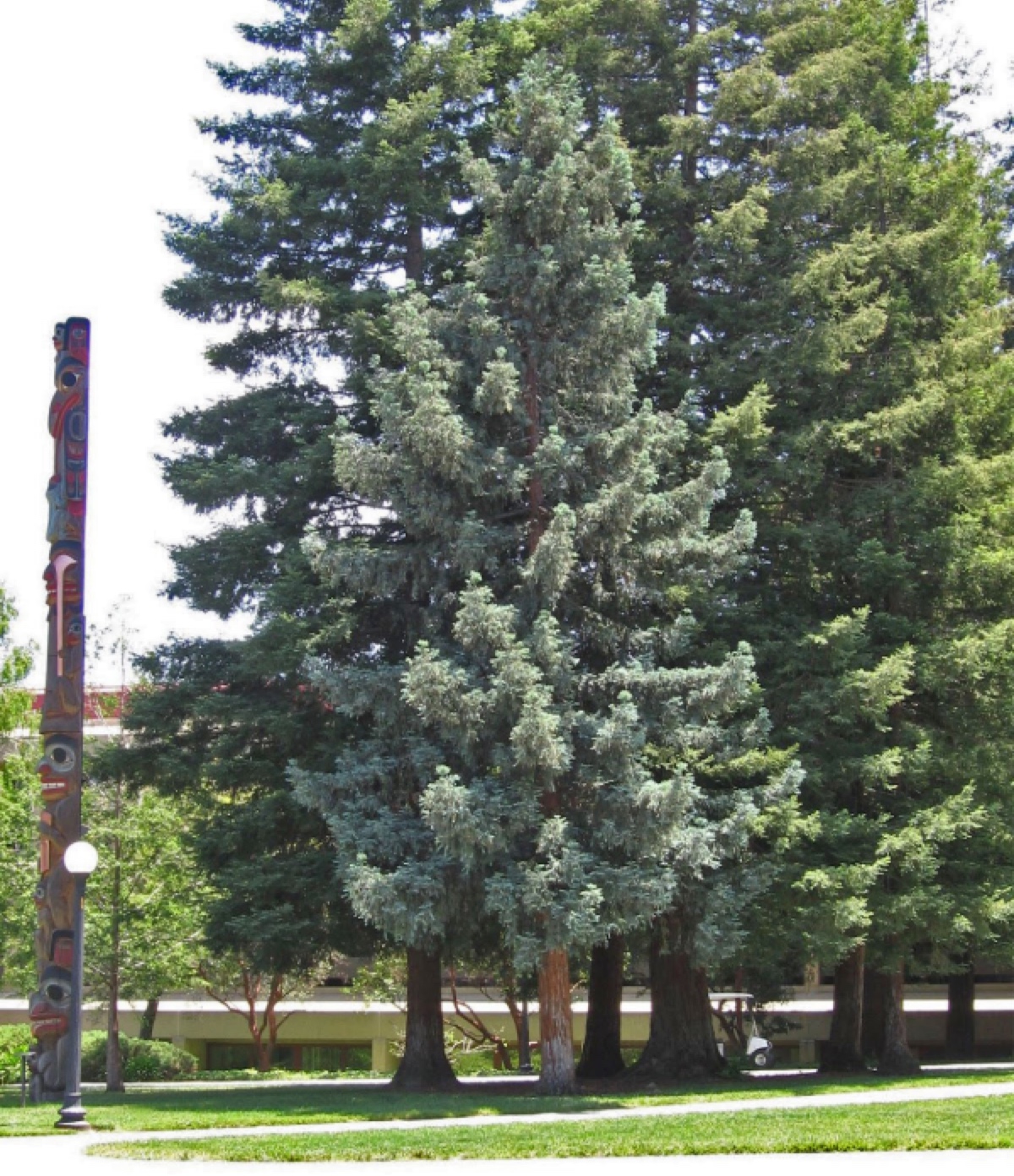
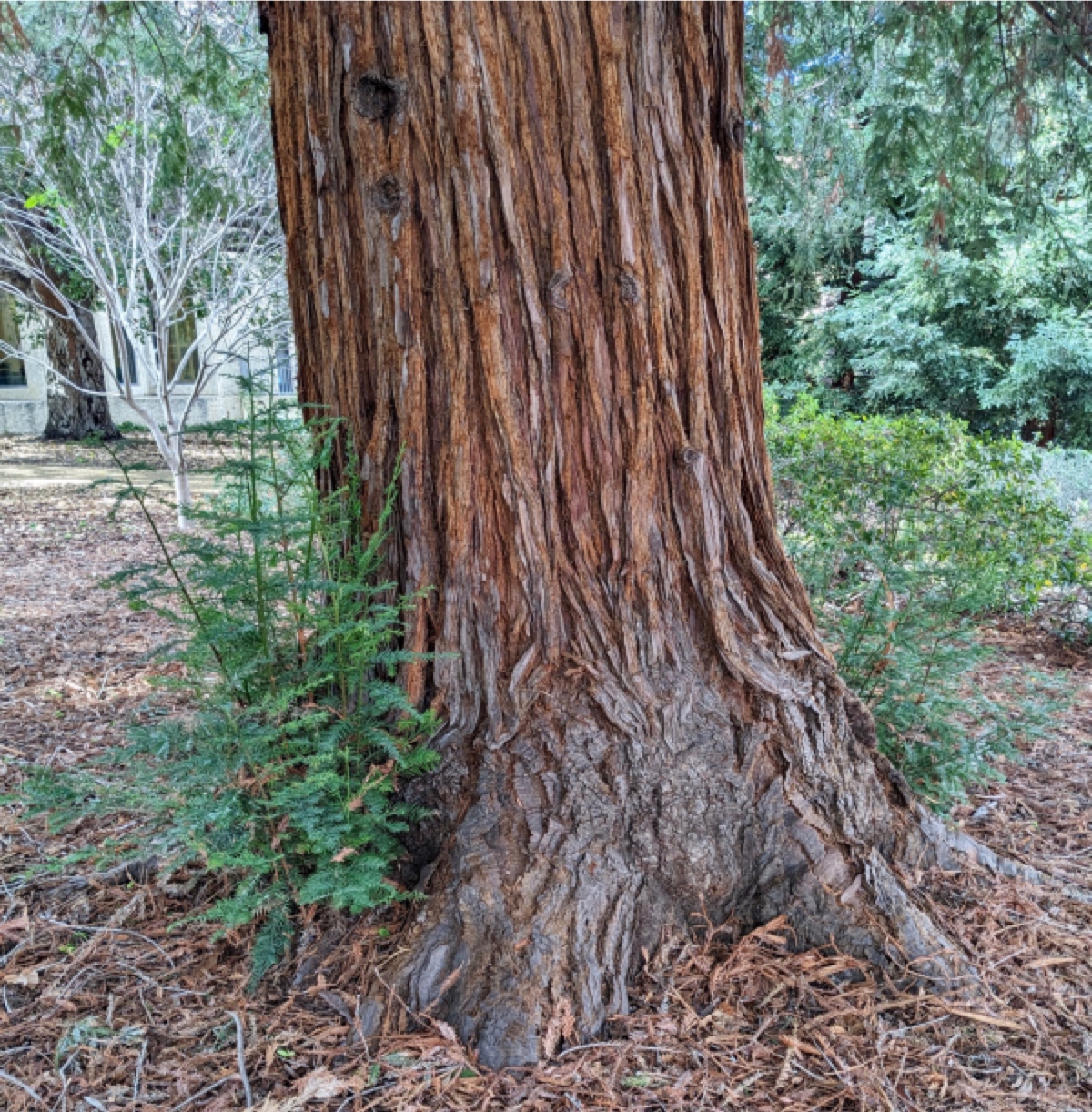
ABOVE LEFT: 2007 photo of the Filoli Blue cultivar of Coast Redwood on the Stanford campus. Source: Trees of Stanford (photo by John Rawlings).
ABOVE RIGHT: 2023 photo by Don Thomas of a Filoli Blue cultivar of Coast Redwood on Stanford campus. If this tree actually began as a rooted branchlet, then the basal sprouts are welcome evidence that branchlet cuttings carry the redwood's evolved capacity to maintain a root system and thereby regrow a new stem when the original stem is injured beyond repair.
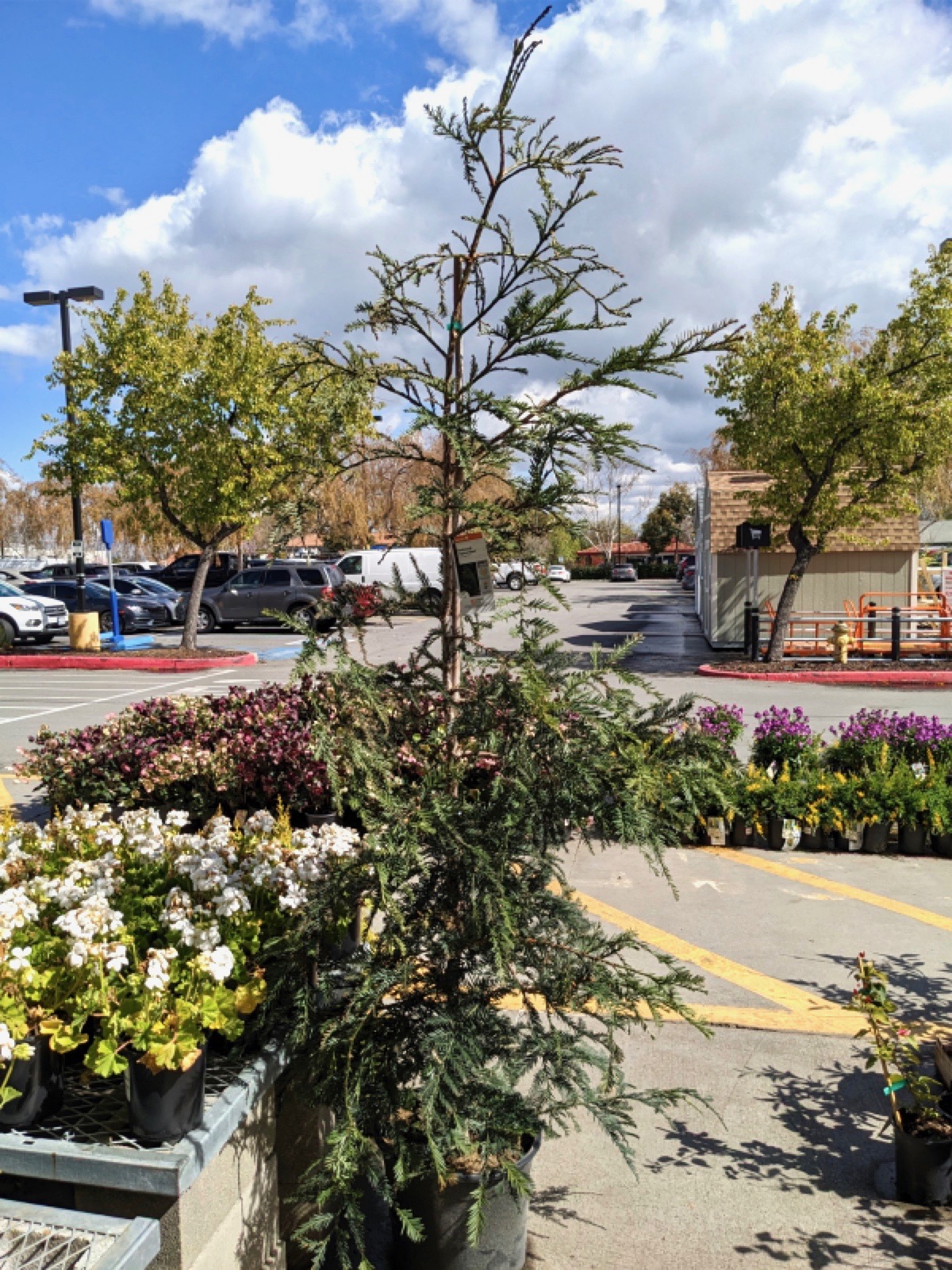
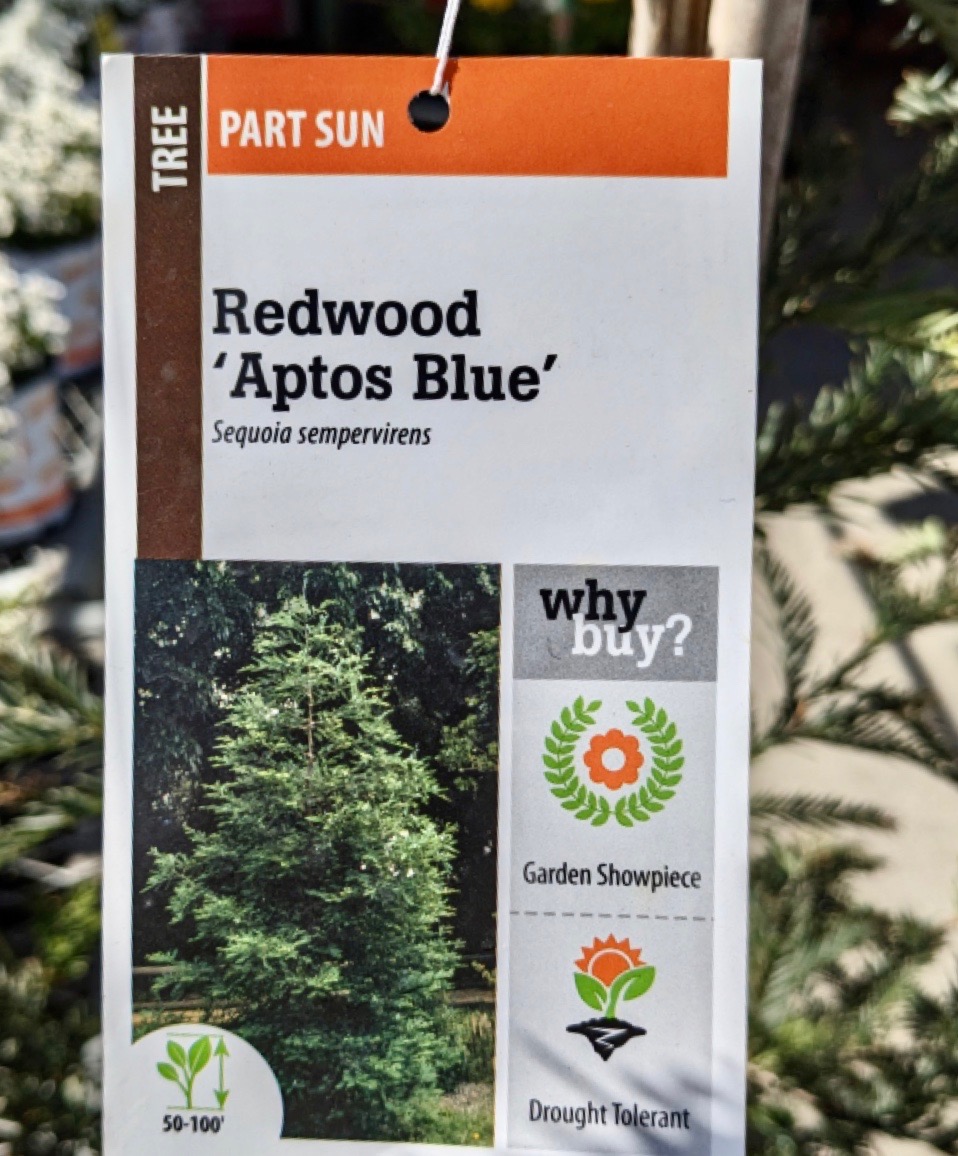
ABOVE: March 2023 DON THOMAS wrote, "For further evidence that upright, tree-form redwood trees can be grown from cuttings, at Home Depot (Cupertino, California) this week I discovered that they are selling a cutting-grown redwood cutivar, 'Aptos Blue', in 15 gallon containers for $59.98. I've attached a couple of photos."
__________
| |
CONCLUSION 7:
There is strong evidence that this canopy giant is not willing to just turn into a shrub. Eventually, a rooted redwood branch cutting will assume single-stem vertical growth. The only remaining question is when the standard radial pattern of branch growth will develop at the top and thereby produce horizontal branches with flat-lying leafy branchlets. |
|
Thus, the existing PLAGIOTROPIC (shrub-like) plantings of redwood clones in Seattle will almost surely manifest the tree-form (although perhaps requiring a decade or two). Staking the little plants may be helpful, but Coast Redwood seems to be capable of manifesting vertical growth entirely on its own, later followed by radial branching symmetry along a leader stem of its choice.
RETURN to TOP
5B. Papers on Nurturing Tree Forms from Cuttings
February 2023
Conclusions and Excerpts
by Connie Barlow
BACKGROUND ON CUTTINGS TYPES:
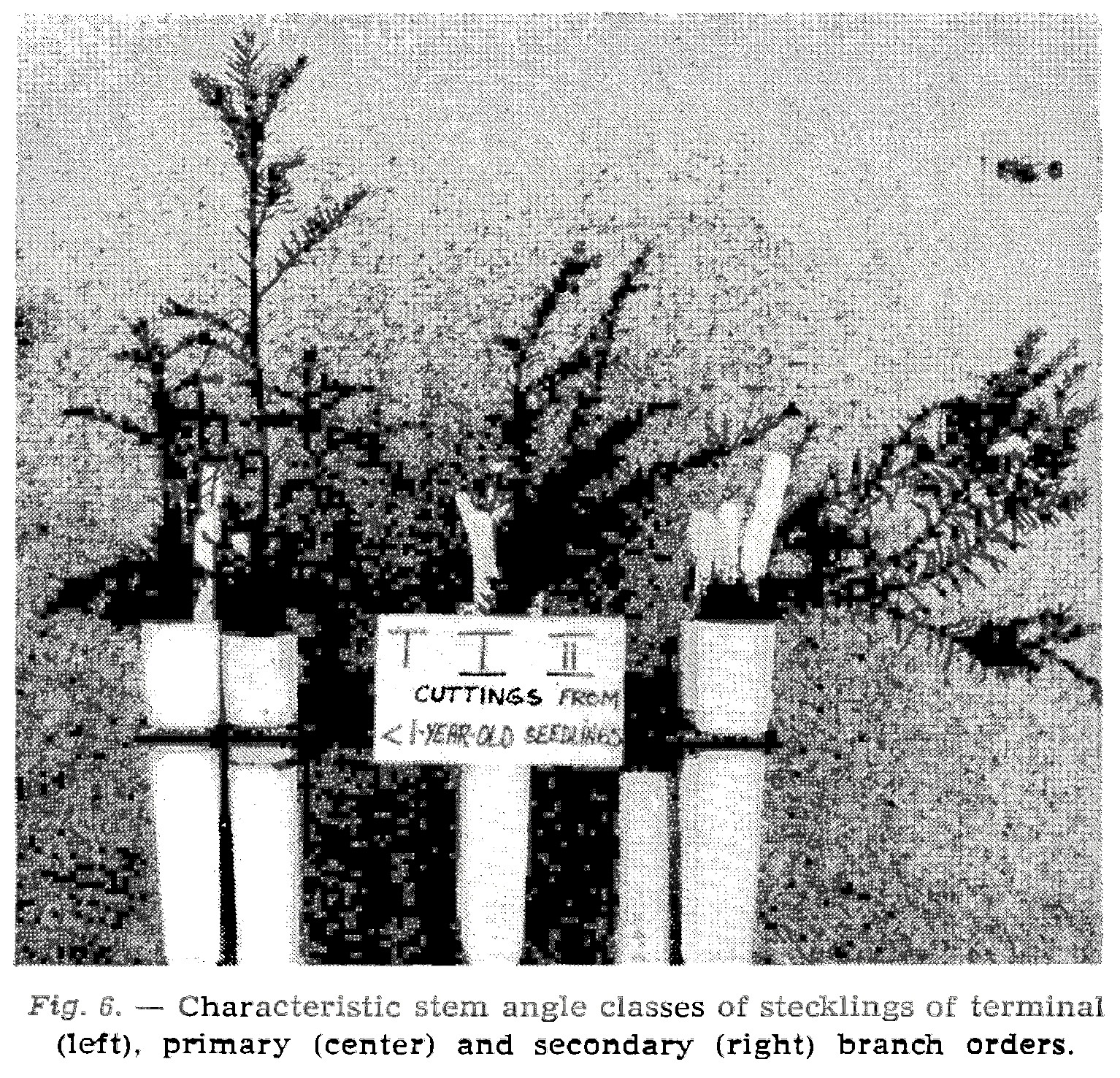
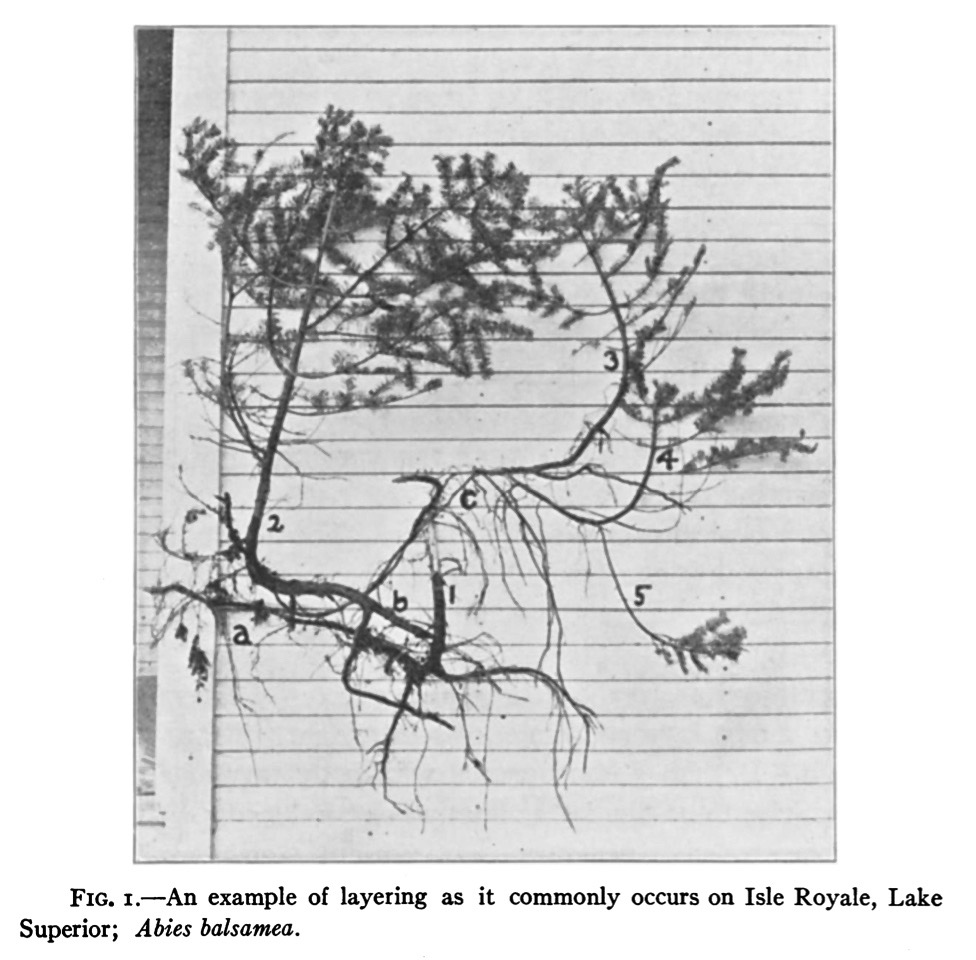
ABOVE LEFT: Natural growth forms of rooted REDWOOD cuttings from different locations (L to R): tip of apical sprout, tip of horizontal branch, and tip of branchlet of a branch. Source: "Cyclophysis and Topophysis in Coast Redwood Stecklings", 1988, by A.B. Power, R.S. Dodd, and W.J. Libby, Silvae Genetica.
ABOVE RIGHT: Extracted rootings of the natural layering process in Balsam Fir. Source: "Reproduction by Layering Among Conifers", 1911, by William S. Cooper, Botanical Gazette.
BELOW: "Influence of shoot origin and certain pre- and post- severance treatments on the rooting and growth characteristics of Douglas-fir (Pseudotsuga menziesii) stem cuttings" (PhD thesis), 1973, by Darvil Kim Black, Oregon State University.
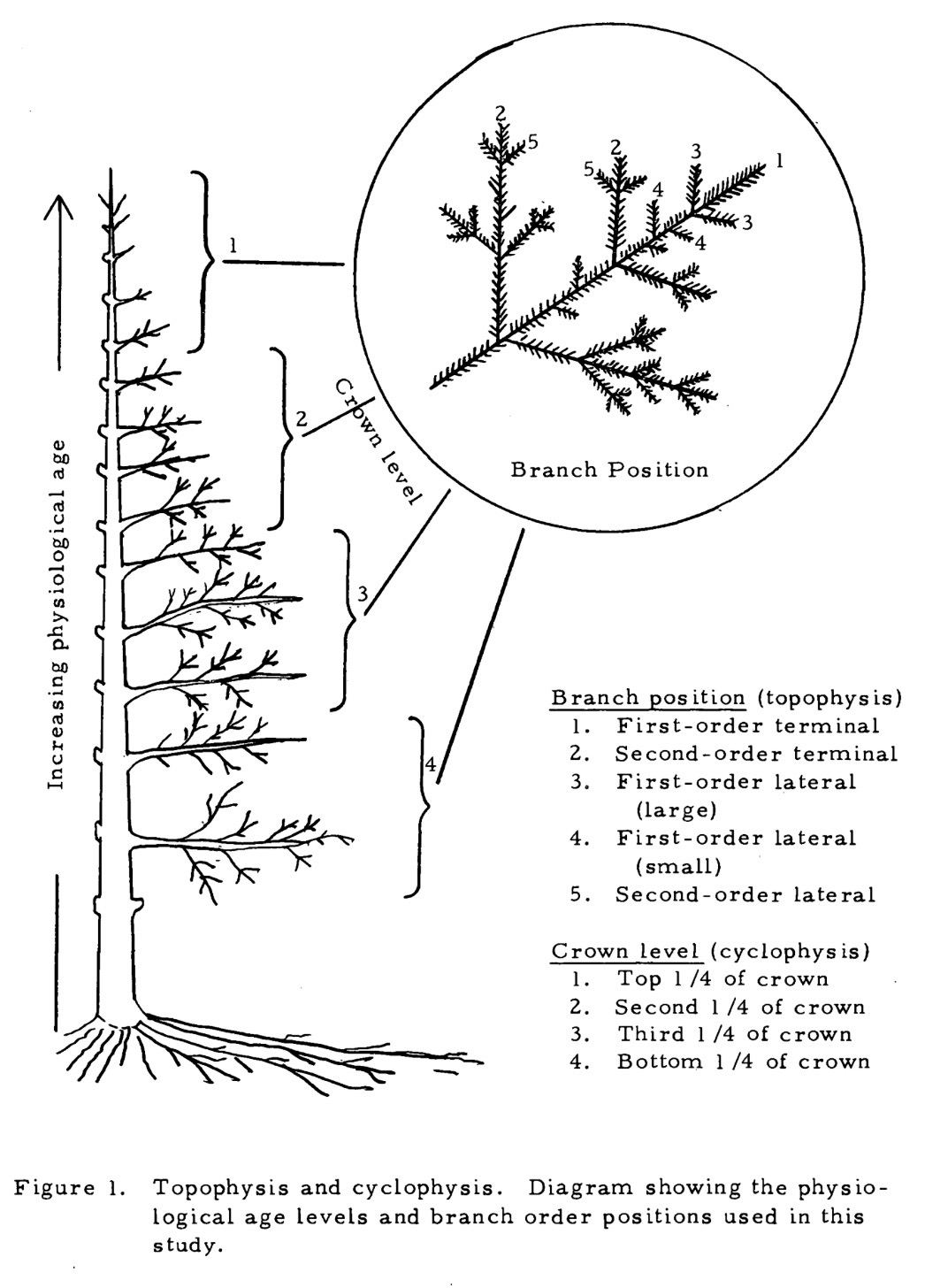 |
|
EXCERPT:
"... Wareing (152) cites the classical set of experiments conducted by Vochting in 1904 with Araucaria excelsa. These show the importance of shoot position when selecting cuttings.
When apical shoots or an axillary bud from the main stem are selected for vegetative propagation, normal radially symmetrical plants were obtained. Rooted cuttings from FIRST ORDER side shoots grew horizontally as they would on the intact plant. Cuttings from SECOND ORDER shoots grew horizontally also, but only as string-like structures, without branching." (pp. 17-18)
__________
|
| |
CONCLUSION 8: Rooting potential is always best when cuttings are taken from the tip of a vertically growing stem. For REDWOODS, this means harvesting cuttings from the tips of basal sprouts. Next best for rooting is the tip of a branch (labeled 1), with diminishing capacities in branchlet tips labeled 2 through 5.
The same sequence likely applies to branch cuttings shifting from their initial plagiotropic to the desired orthotropic (tree-like) orientation. Thus, branch cuttings from the same tree that were rooted and then planted out in Seattle might range widely in when (and whether) the tree form is fully recovered. As shown in the above figure, "First-order branch terminal" cuttings offer the best prospects. "Second order lateral" cuttings would be the worst.
|
|
__________
| |
WHY PUBLISHED PAPERS ARE INCONCLUSIVE:
The images and cuttings preferences above apply generally to conifers. Plagiotropic growth is thus the expected initial outcome when rooting a cutting from anywhere other than the apical tip of a main stem or basal sprout (and not all conifers have basal sprouts).
I have not, however, encountered any papers that offer practical advice for nurturing a planting that exhibits "plagiotropic growth" into a fully "orthotropic" orientation.
It seems that very early on, propagators learned not to take cuttings from branches. And soon after that, they began to explore "micro-propagation" techniques whereby the tiny, undifferentiated "axillary meristems" could be extracted and then reliably prompted into "orthotropic growth". This, of course, is not possible outside of a lab — and it has no practical application for nurturing the plagiotropic clones that have already been planted in the Seattle area.
The papers most useful toward the task of nurturing large, outplanted redwood clones that still exhibit "plagiotropic" growth use the keyword REJUVENATION. But even these apply mostly to micro-propagation techniques applied to lateral cuttings.
|
|
• 1993, "Micropropagation and Rejuvenation
of Sequoia sempervirens: A Review, Y. Arnaud, A. Franclet, H. Tranvan, and M. Jacques, Ann Sci For.
"... Attempts at vegetative propagation by cuttings in California (Becking and Belleto, 1968; Libby and Mc Cutchan, 1978; Libby, 1982) as well as in France (Franclet, 1981), have shown that for cuttings of old sequoias, rooting is difficult, later growth is slow and plagiotropic. For the propagation of such trees, sprouts or suckers must be used (Lindquist, 1974; Franclet, 1981; Poissonnier et al, 1981). Such shoots are rarely available in great numbers under natural conditions, but certain techniques, such as cutting back of the main trunk or root-heating via industrial water (Cormary et al, 1980) can increase their production. These difficulties have stimulated further research work (Festa and Gambi, 1978; de la Goublaye, 1981; Vershoore-Martouzet, 1985), encouraged by the demonstration that the species can be cultured in vitro (Ball, 1950; Restool, 1956). In reviewing the in vitro micropropagation of Sequoia sempervirens, it is necessary to separate micropropagation from other regeneration strategies.
"... The ability of the explants to develop axillary buds depends on the chrono- logical age of the mother plant and the original shoot, and on the original position of the material on both the ortet and ramet (Boulay, 1978; de la Goublaye, 1981; Verschoore-Martouzet, 1985). Thus, explants originating from a sucker are more reactive than explants derived from the crown, and for the same sucker the most apical regions (most recently formed) show the best response.
"... Fouret (1987) reported that, at the end of the elongation phase, when the initial material was young, the leaves were long, soft and light in color. Furthermore, the phyllotaxy was of axial type in a clone from a 1-yr-old tree, whereas it was either of axial or crosswise-opposite type in a clone from a 50-yr-old tree, and of crosswise-opposite type or more often distichous type in a clone from a 500-yr-old tree.
"... REJUVENATION is a necessary prerequisite for mass propagation, and can be defined as the recovery by old plant material of at least some of the properties of younger material (see Pierik, 1990). Walker (1985) preferred the expression 'rejuvenilization, reserving the expression 'rejuvenation' for the rapid and total recovery of juvenile character, for example in apomictic or zygotic em- bryo formation (Franclet and Boulay, 1989). In situ pruning, cutting back or grafting can induce a rejuvenating process (Vershoore-Martouzet, 1985), improving in vitro performance (Franclet, 1981; Franclet et al, 1987). The effect of these techniques is to bring the root system closer to the above ground shoot system (Doorenbos, 1965; Chaperon, 1979; Franclet et al, 1980; Favre, 1980).
"... With repeated subcultures of meristems issued from a very old tree (ARC 154: 500 yr), the shoots progressively recovered a young physiological state, evaluated by a better rooting ability (realized ex vitro), by the acquisition of the ability for adventitious budding on isolated leaves and by a better reactivity of the isolated apical meristems (Walker, 1986). But the plants still maintained plagiotropic growth in the greenhouse. Total (according to the praticians) or ontogenetic (see Schaffalitzky de Muckadell, 1959) rejuvenation of material from a very old tree has thus achieved."
Editor's note: The above paper limited its observations to micro-propagation results in the lab. A previous Sequoia publication (below) likewise did not present long-term data on whether out-plantings could naturally self-correct to a fully tree-form — perhaps over the course of decades. But as you will see, it is suggestive.
• 1988, "Cyclophysis and Topophysis in Coast Redwood Stecklings", by A.B Power, R.S. Dodd, and W.J. Libby, Silvae Genetica.
"Two studies were conducted with vegetative propagules of Sequoia sempervirens to improve our understanding of the effects of branch order (topophysis) on the rooting of cuttings and growth performance of the resulting stecklings.... The results indicate that both maturation stage and branch order have significant effects on the rooting of cuttings and on the growth characteristics of the resulting stecklings.
"... During a decade's observations with various kinds of coast redwood propagules, we have noted that recently rooted young stecklings exhibit a wide spectrum of stem angles; some vertical, but most non-vertical to varying degrees. It was clear that the persistence of plagiotropic growth of stecklings was longer for cuttings taken from older plants, or for cuttings from higher in the crown of a tree.
"... Stecklings from the terminals and two branch orders developed marked differences in growth form by eight weeks after rooting. Stecklings from terminals generally maintained an orthotropic growth habit. The degree of plagiotropic growth was more marked for stecklings from secondary branch order than for stecklings from primaries.
"... Stecklings that commenced plagiotropically began to recover from this in three ways:
1. The apex of plagiotropic shoots gradually turned upwards. Later, the stem moved towards the vertical presumably as a result of compression wood formation.
2. Buds from the lower third of the shoot flushed and grew orthotropically.
3. Orthotropic shoots arose de novo from the basal callus.
There were no consistent differences between stecklings of primary and secondary branch orders as to the mode of recovery from plagiotropic growth.
"... The change from plagiotropic to orthotropic growth was associated with a change from bilateral to radial symmetry. ... In contrast to stecklings of hedge origin, primary and secondary branch positions of seedling origin did not produce any orthotropic shoots from the stem but only from the callus...."
| |
CONCLUSION 9: Redwood's ability to be nudged into a "phase change" so that plagiotropic rooted cuttings from lateral branch materials might shift into tree-form have been explored from the standpoint of commercial forestry interests. Accordingly, quick solutions are what matter. The above 1988 paper nonetheless is suggestive that COAST REDWOOD can self-correct on its own, but over a time-scale that precludes commercial interest. (The next paper seems to concur.)
|
|
• 1973, "Influence of shoot origin and certain pre- and post- severance treatments on the rooting and growth characteristics of Douglas-fir (Pseudotsuga menziesii) stem cuttings" (PhD thesis), by
Darvil Kim Black, Oregon State University. Editor's note: Even though this is a PhD thesis, it was often cited in later papers. Because of its 1973 publication date, this was before "micro-propagation" techniques fundamentally changed how cloning was practiced.
... In general, the results reported here for Douglas-fir resemble
those for other conifers. The rooting potential remains high in young trees up to nine years of age, and then drops off rapidly, reaching a very low level between 14 and 25 years.... Root quality, as well as rootability, declines with increasing age of the parent tree.... Rooting potential decreased with increasing age of the seedling trees. This response to aging is common to most, if not all, trees and shrubs.
... The natural transition of cutting ramets from the plagiotropic to the orthotropic growth habit was slow and was not hastened by staking, pruning, repotting, or unidirectional lighting. This transition occurs in some juvenile clones in three years, while others take seven or eight years or even longer for old clones. Preliminary observations of cutting ramets from different origins suggest that cuttings from young clones, terminal branch positions, top crown sections, and orthotropic shoots in sheared trees [trees pruned back under a power line] produce orthotropic trees more rapidly than cuttings from other sources.
... Another horticultural example of topophysis is Taxus cuspidata. In order to obtain the desired upright habit, cuttings must be taken only from erect terminals or upright-growing laterals rather than horizontal side shoots (55). This phenomena is also seen in Taxus
baccata (100) and Coffea arabica cuttings (55).
... Frohlich (44) showed that the time required for orthotropic growth habit to develop in Picea cuttings was related to their original branch order position on the tree, taking longer with higher order branches. Within each branch order, material from younger trees made the transition faster than materials from older trees.
... To summarize, there appears no serious problem with plagiotropism in cuttings of the genera Pinus, Taxus and Larix, although there are differences in cutting survival and vigor of growth. In contrast, there are marked differences reported for cuttings of various species of the genera Picea, Pseudotsuga, Abies, Araucaria and Cunninghamia, which all have similar formal growth habits. A partial solution to the problem of plagiotropic growth appears to be the proper selection of cutting material.
... Several characteristics distinguish the plagiotropic from the orthotropic plant. Obvious morphological differences include needle orientation and bud and branch arrangement, which are bilateral in plagiotropic shoots, but radially symmetrical in orthotropic ones. The most noticeable and easily measured difference, however, is the growth angle of the main stem.
... Staking was difficult to maintain since the reaction wood formed in the old portions of the stem created considerable pressure on the stakes. The bamboo stakes were bent with such force that some were broken. When bending was prevented, the extension growth was at the same angle as before staking (Figure 2). These and other observations indicate that pruning and staking treatments used were not effective in hastening the transition of Douglas-fir from the plagiotropic to orthotropic growth habit.
... The transition occurs gradually and at a somewhat predictable rate over several years. During the transition, the stem becomes more upright and the arrangement of the needles, buds, and branches becomes more radially symmetrical. This study, and observations on another 20 clones, indicated that orthotropic plants from cuttings can be expected after three years
with some clones, but requires longer, even up to six to ten years with others.
... McCullock (95) reported that cutting ramet plants were still plagiotropic after three years in the field. Thirty years later the trees that McCullock reported as plagiotropic are now symmetrical, orthotropic, uniform trees, which would compare favorably with seedling trees of the same age. The ortet from which these ramets were propagated was an old tree. It thus appears that given enough time, cutting ramets from even old clones will become orthotropic. ... It seems that the ramets in this species will eventually become orthotropic regardless of their source.
| |
CONCLUSION 10: Even though the above 1973 paper is about Douglas-fir, it very much elevates confidence in the ability of Coast Redwood to gradually reorient from plagiotropic plantings to a fully orthotropic tree form. This is terrific news for the recipients of plagiotropic redwood plants in the Seattle area.
|
|
| |
CONCLUSION 11: The above 1973 paper concluded that "pruning and staking treatments used were not effective in hastening the transition of Douglas-fir from the plagiotropic to orthotropic growth habit." This is actually good news for recipients of plagiotropic potted redwoods because it means that even with no further attention and assistance, these plantings will indeed adopt the tree form, albeit at their own slow pace.
|
|
RETURN to TOP
5C. Learning about genus Sequoia from genus Torreya
February 2023
photo-essay by Connie Barlow
(founder of Torreya Guardians in 2005)
____________________________________
BACKGROUND: While I have no personal experience with propagating cuttings of any conifer, as webmaster of Torreya Guardians, I document online the photos and experiences of volunteers who do engage in collecting cuttings and/or attempting to root and ultimately establish this critically endangered species.
Therefore, this subsection will feature photos and reports that highlight similarities and differences between genus Sequoia and genus Torreya. Included will be information on and our experience of propagating FLORIDA TORREYA, Torreya taxifolia from cuttings.
As well, a new branch of Torreya Guardians formed in 2022 based on the West Coast. Volunteers in California photo-document the largest wild specimens of CALIFORNIA TORREYA, Torreya californica. They also access seeds and assist their migration northward. Thus far, there has been one long-distance transfer: from the Santa Cruz Mountains to Vancouver, British Columbia.
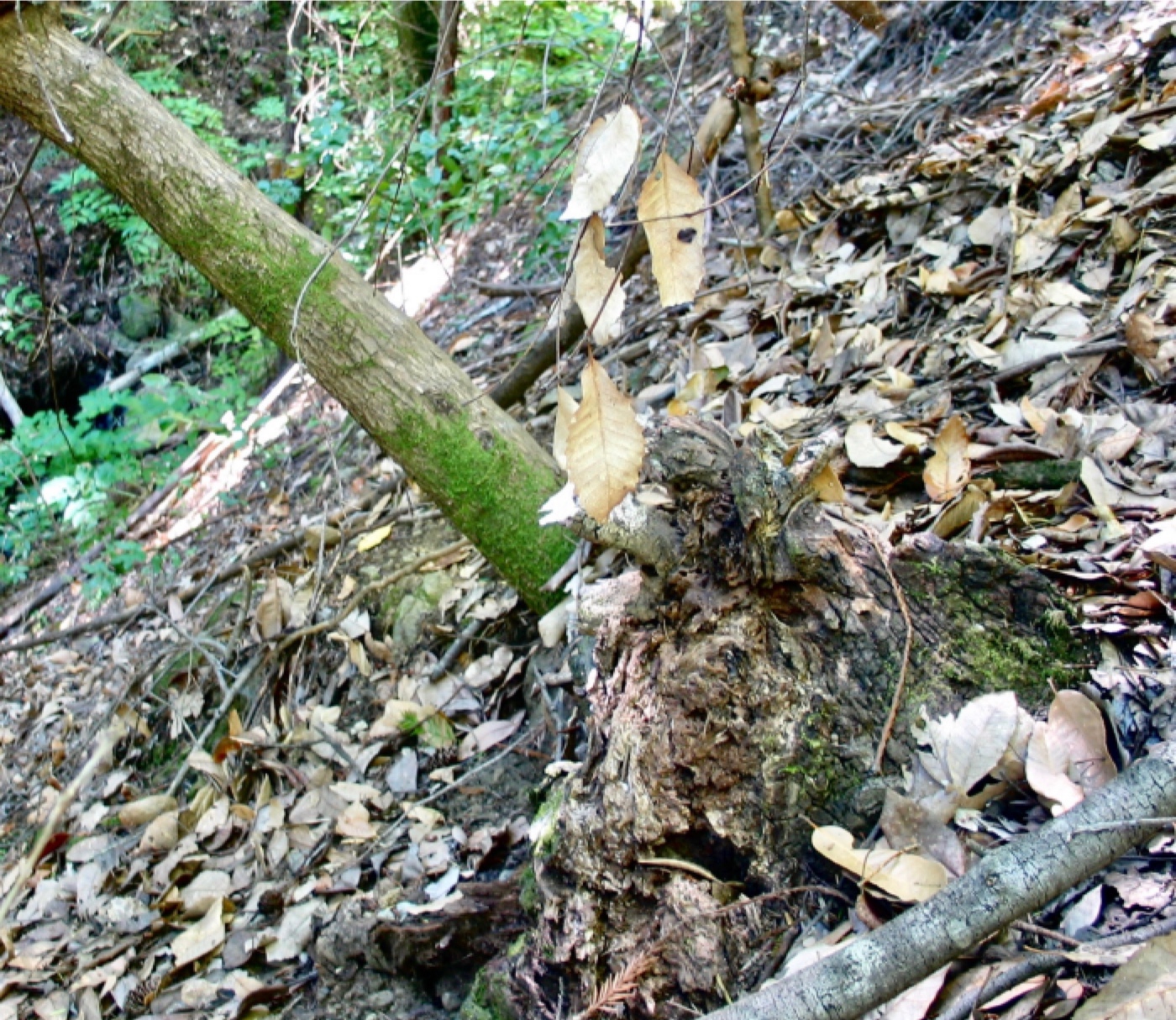 |
|
Growth similarities between
Genus Torreya and Genus Sequoia
One way in which Torreya species are similar to the Coast Redwood is that both develop a lignotuber.
Both therefore also have tremendous capabilities to send forth basal sprouts for replacing an injured main stem or simply for increasing photosynthesis whenever light becomes available near the base. |
ABOVE: This young stem of CALIFORNIA TORREYA originated from an older root system on a steep slope within a wild Coast Range section of forest northwest of Napa Valley. A tree likely fell onto the already leaning stem and thus forced a portion of its lignotuber to emerge into view.
• SIMILARITIES between CALIFORNIA and FLORIDA SPECIES OF GENUS TORREYA
Florida Torreya, Torreya taxifolia, is sibling species to California's own endemic, Torreya californica — whose common name is California Torreya or California Nutmeg.
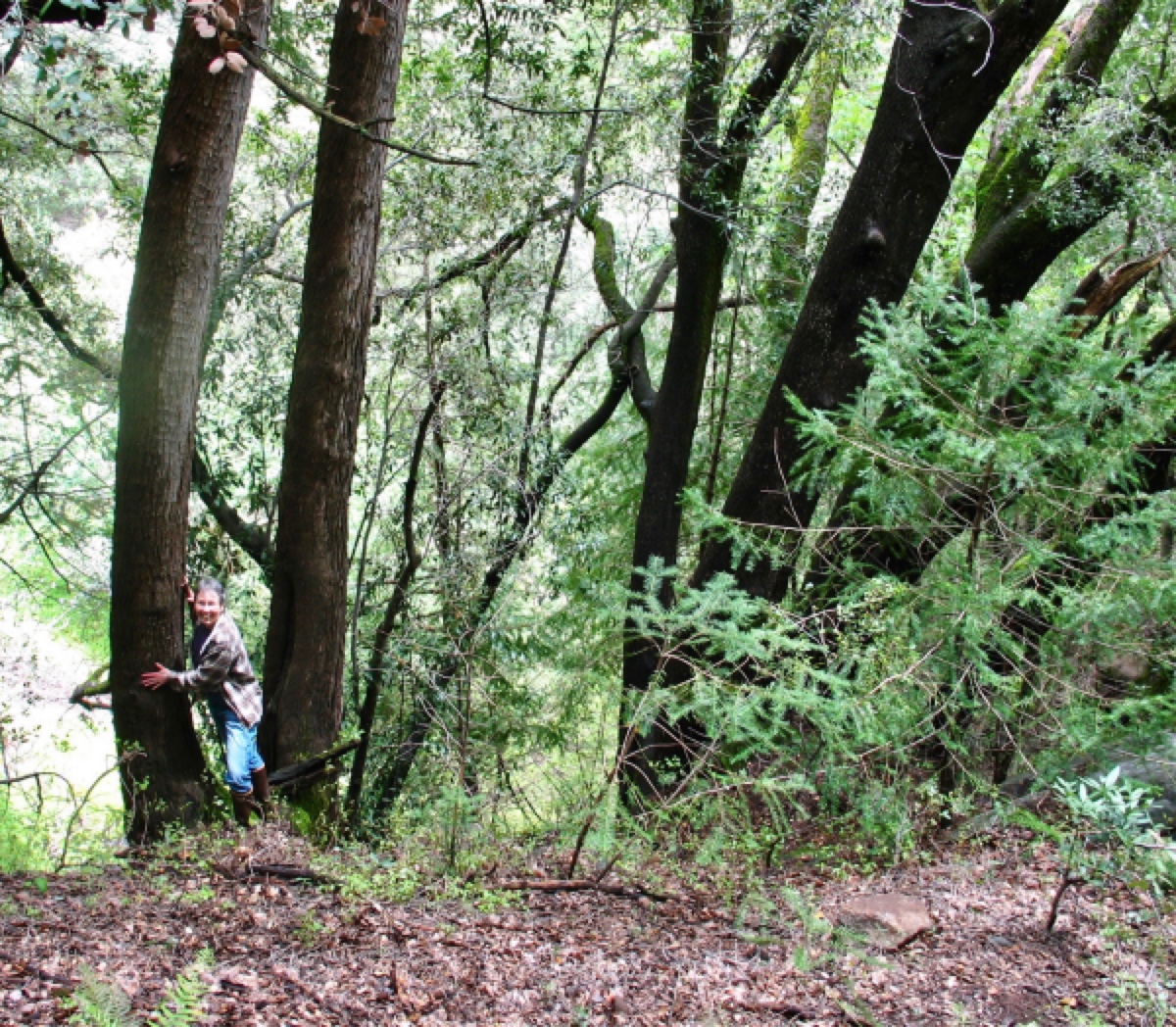
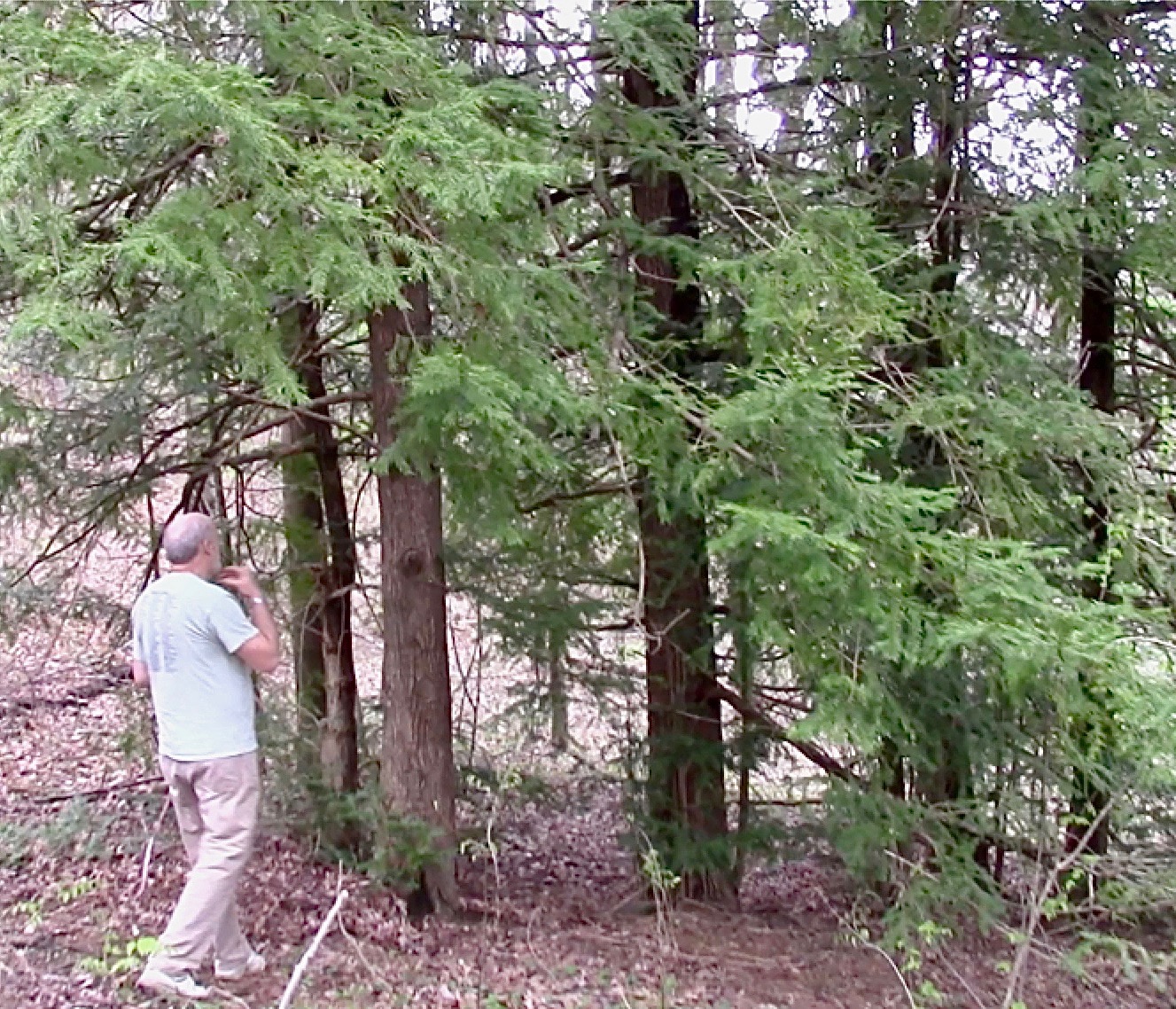
ABOVE LEFT: California Torreya. Connie Barlow stands between two regrowth basals on a very steep slope in Sequoia National Park, 2005. In the foreground are several saplings of this species.
ABOVE RIGHT: Florida Torreya. Jack Johnston (a Torreya Guardian) with a century-old horticultural planting of a grove of torreya at Harbison House in Highlands, North Carolina, April 2015. (Photo by Connie Barlow)
RETURN to TOP
• BASAL SPROUTING of HEALTHY FLORIDA TORREYA
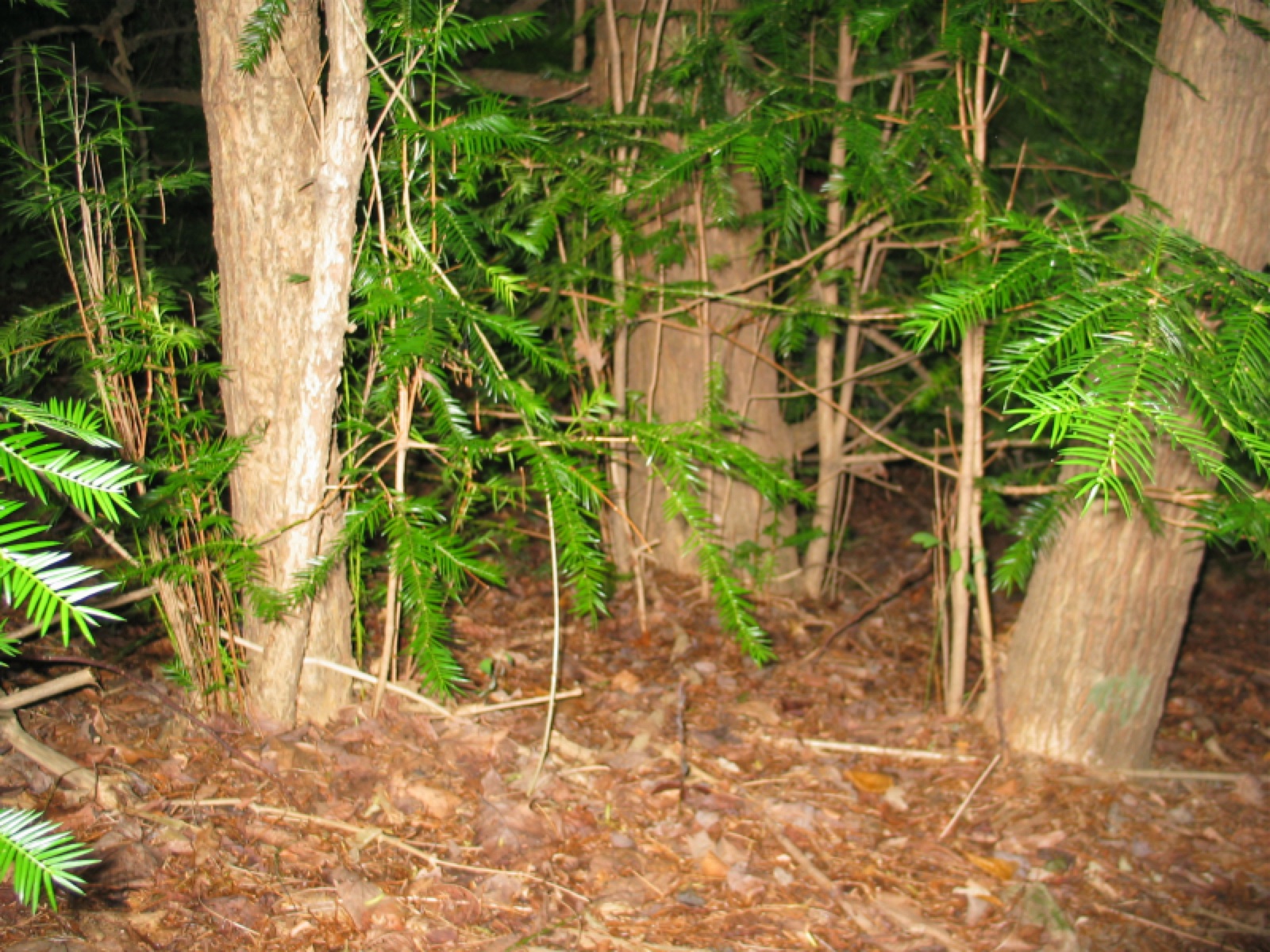
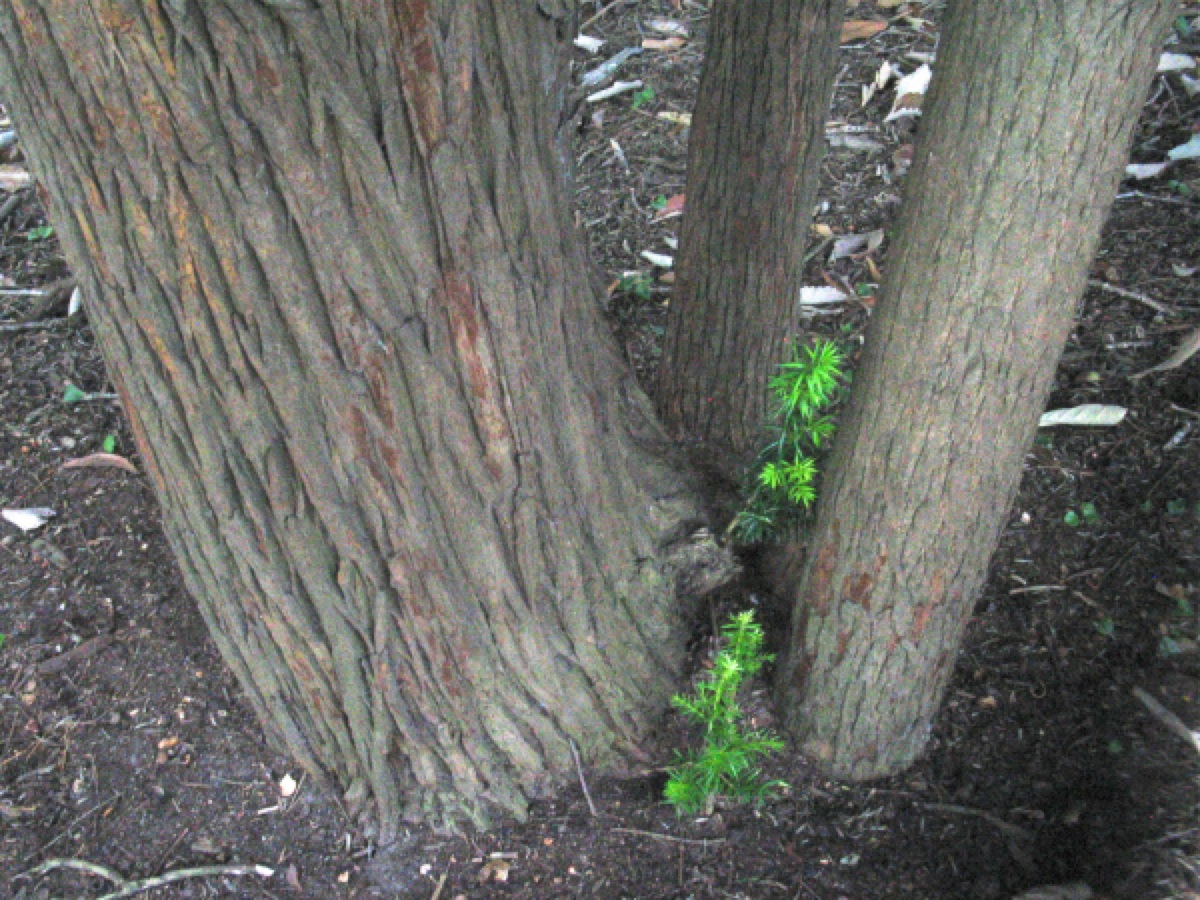
ABOVE LEFT: Basal sprouts on the south side of the Florida Torreya horticultural grove at Harbison House, Highlands NC, 2006. Note: Torreya is usually a subcanopy tree, and in this photo the deciduous canopy that overtops this planted grove is so dense that the camera automatically used a flash on this drizzly afternoon in August.
ABOVE RIGHT: Basal sprouts of various ages emerge from a seed-producing Florida torreya in the front yard of a home in Clinton, North Carolina.
• TOPPED TORREYA TREES ARE RESCUED BY BASAL SPROUTS
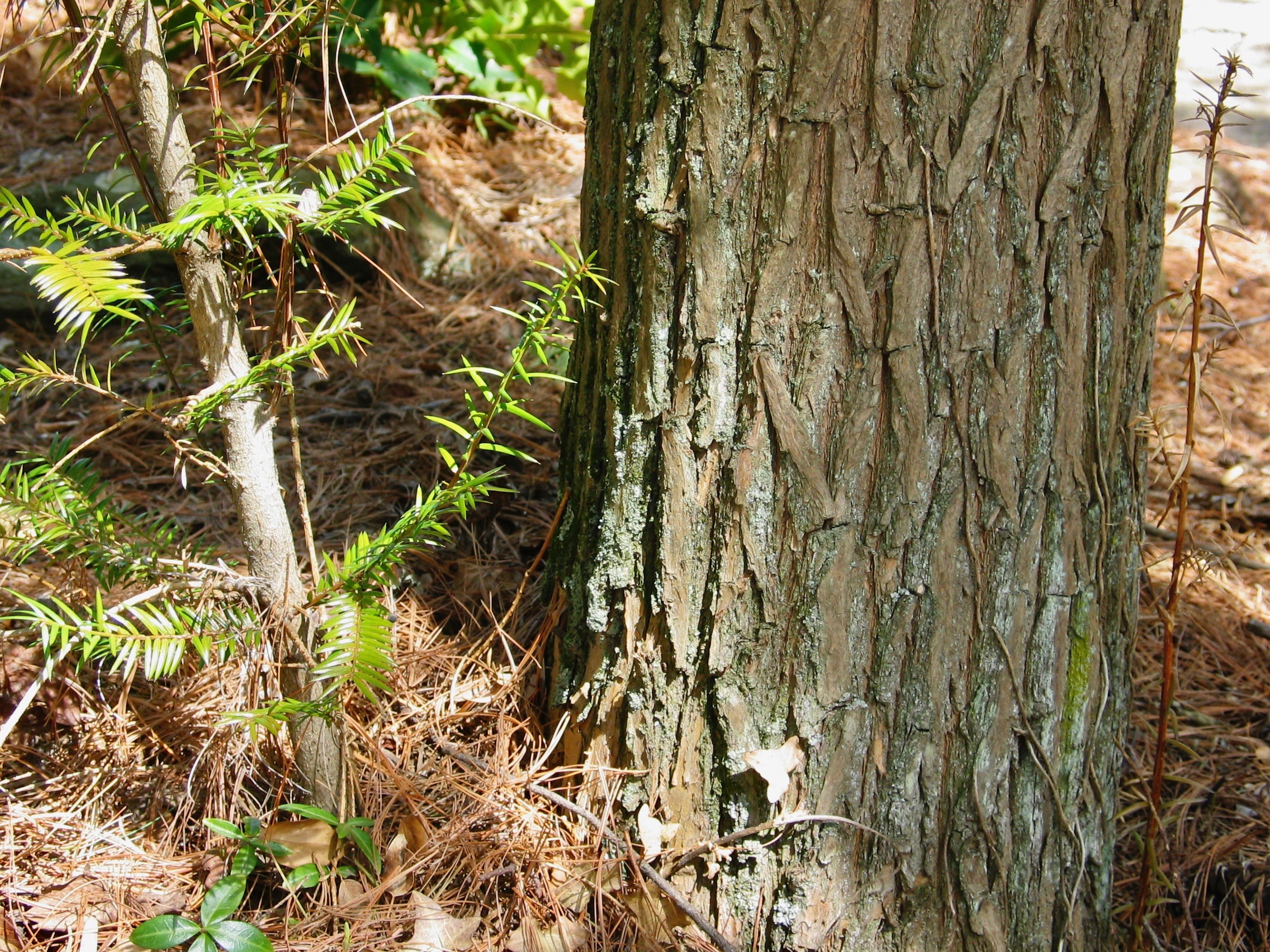
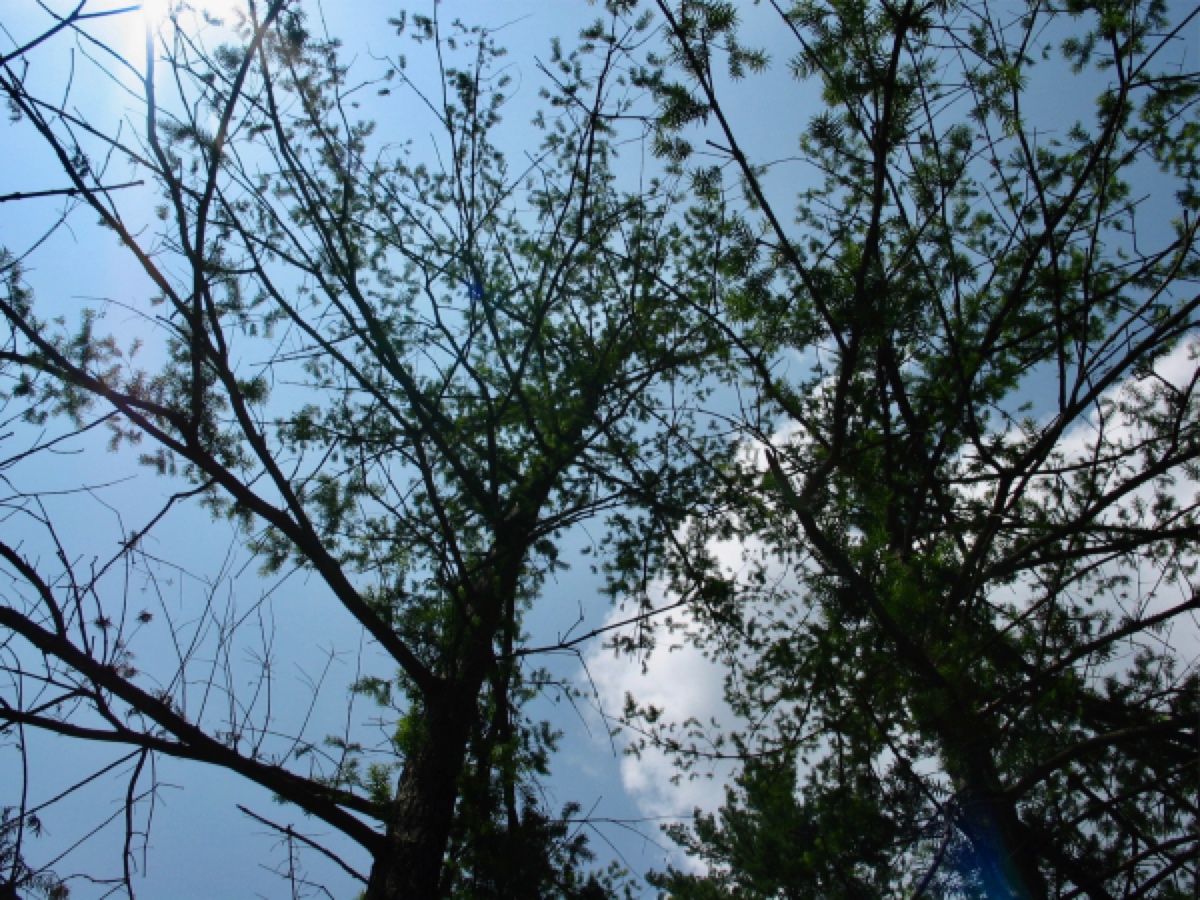
ABOVE LEFT: In May of 2004 Connie Barlow first visited the Florida torreya grove at Biltmore Gardens (NC). All 11 trees from the original 1939 planting were then still alive. Here is one of those trees, sporting a basal sprout.
ABOVE RIGHT: In August 2006, Connie returned to the Biltmore just 2 years after a hurricane had destroyed the white pine overstory and injured several of the original torreyas beyond repair. Staff removed the casualties. Only three of the original 6 torreyas that were on the highest slope level remained — and even these had been top-injured.
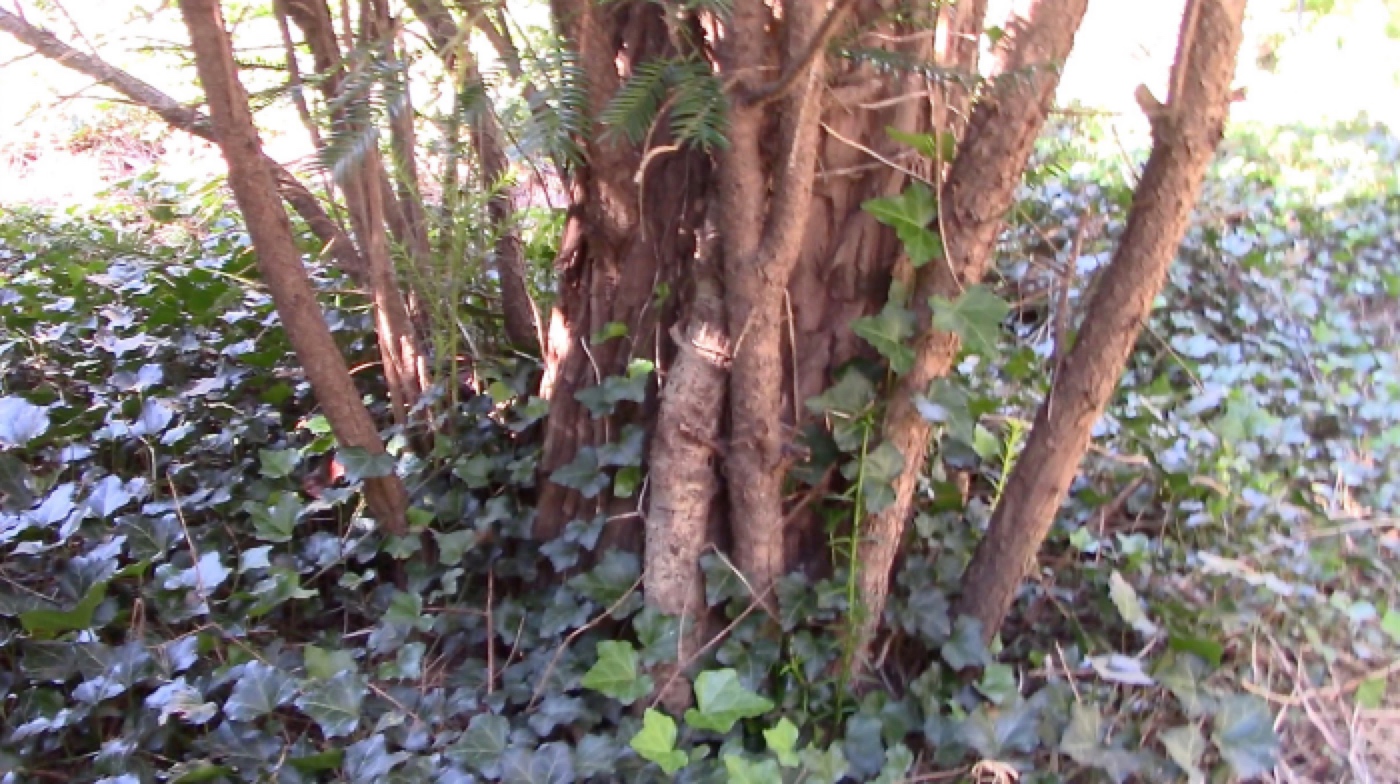
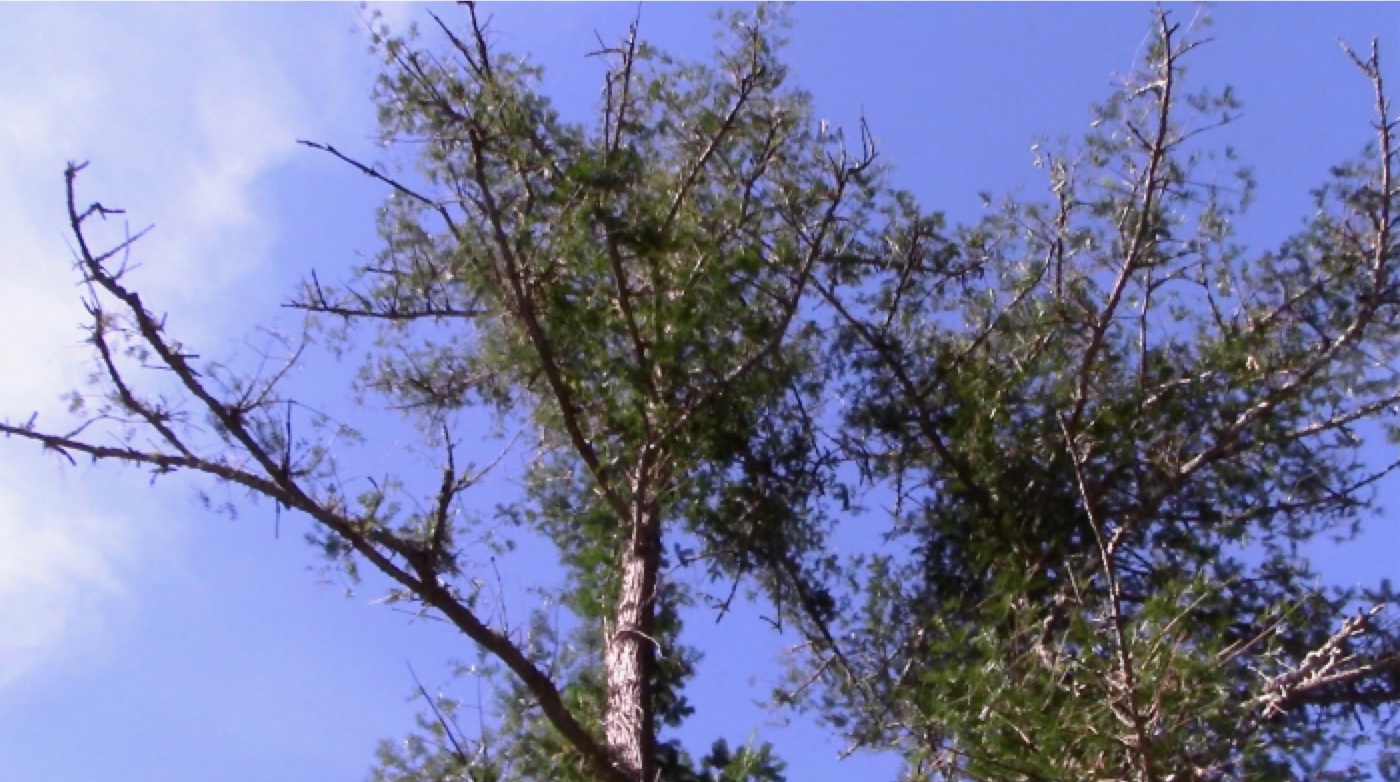
ABOVE LEFT: In 2018, Barlow documented that many of the post-storm basals were still supporting one of the top-pruned trees. There was no reason for the tree itself to senesce all the basals, as significant sunlight was still available near the base.
ABOVE RIGHT: In 2018 the canopy had gained leafiness — but not any height. Past an early age, topping of the main stem of Torreya will not evoke a new leader from the stem itself. Instead, one or more of the basals will continue their upward growth, if unpruned by humans. Torreya species thus lack Coast Redwood's remarkable ability of "trunk reiteration". Nevertheless, similarities in lignotuber development and post-injury basal profusion reveal that both generally will do whatever they can above ground in order to maintain as much of the old growth root systems as possible. Their mantra: Stems come and go, but roots are forever.
Below is a paper that confirms that some conifers will not replace a top-injured main stem with a new leader emerging from anywhere except the base of the tree:
• 2004, "A review on the effects of donor maturation on
rooting and field performance of conifer cuttings", by R.G Mitchell et al., Southern African Forestry Journal
... As donor plants, whether in hedge or tree form, reach ontogenetic maturation, however, cuttings harvested from them produce malformed stems (Roulund, 1975; Peer and Greenwood, 2001). Trees, whilst still in a juvenile state, will continue to produce new leaders that will replace the main leader if it is removed from the tree during its stage of growth. However, once the tree reaches the point of ontogenetic maturation, removal of the main leader will not stimulate its replacement by a branch. The tree will continue to grow without any change in orientation. This effect, observed by the horizontal growth form of the lateral branches, is referred to plagiotropism and cuttings harvested from parent material that have reached an irreversibly mature state may express plagiotropic growth in the field (Roulund, 1975; Dekker-Robertson and Kleinschmit, 1991; Peer and Greenwood, 2001).
In many cases, cuttings harvested from recently matured donors continue to display plagiotropic characteristics during the early stages of field growth but display vertical growth habits, otherwise known as orthotropic growth, after a few years. It is believed that the change in growth habit from plagiotropic to orthotropic could be as a result of the production of compression wood (Frampton et al., 2000). Compression wood is a response to gravity and stress and is known to have a lower cellulose and higher lignin content (Butterfield and Meylan, 1980). It is viewed as a serious defect in timber due to its weaker structure. Cuttings harvested from donors in the advanced stages of ontogenetic maturation, however, do not regain orthotropic growth patterns.
... The factor that has the greatest influence on cutting production is the age at which the donor plant reaches reproductive maturity and is most commonly termed, the point of "ontogenetic maturation". Once a donor plant had attained this state, manipulation of the donor to regain juvenile characteristics once more is very difficult, although through repeated serial propagation, some authors achieved a degree of juvenility. Once this state has been reached, cuttings harvested from ontogenetically mature donors, display plagiotropic (malformed) and reduced growth habits.
Unlike REDWOOD, TORREYA cannot restore a top-injured canopy by trunk reiteration. But TORREYA vastly outperforms REDWOOD in its youthful ability to recover from early herbivory:
RETURN to TOP
• TORREYA SEEDLINGS EASILY RECOVER from HERBIVORY
Young seedlings of Florida torreya readily resprout leaders from their main stem whenever the apical tip is nipped off by a browser. As a slow-growing subcanopy tree that rarely can expect to achieve canopy status, Torreya is likely a more adept re-sprouter from its then-current main stem than Redwood.
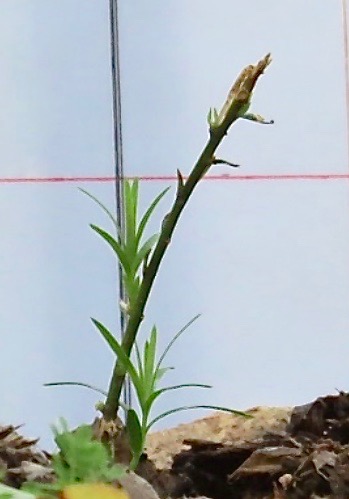
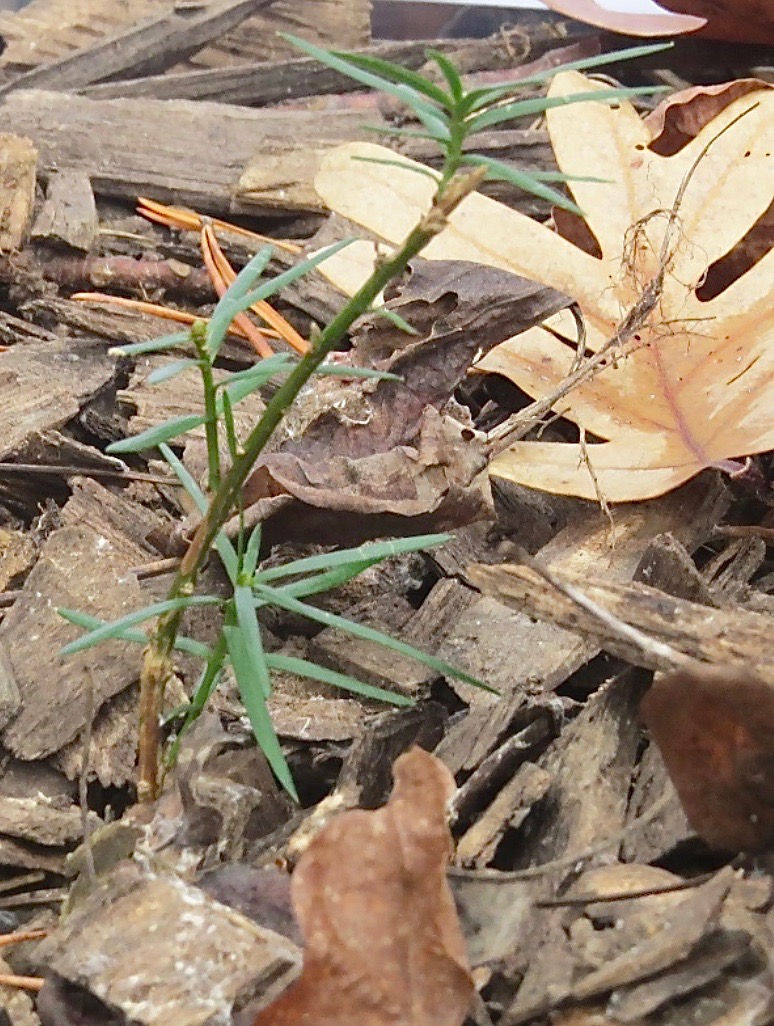
ABOVE: Sometime in 2016 a seedling that had emerged from a seed planted directly into the ground in November 2013 had all its leaves devoured and its top nipped off. By May of 2017 (photo left), recovery was underway. By November 2017 (photo right), two possible new leaders and one basal had flushed. Notice that the mid-height leader had already had its tip nipped off again. Visit the Greensboro NC torreya page for ongoing results.
__________
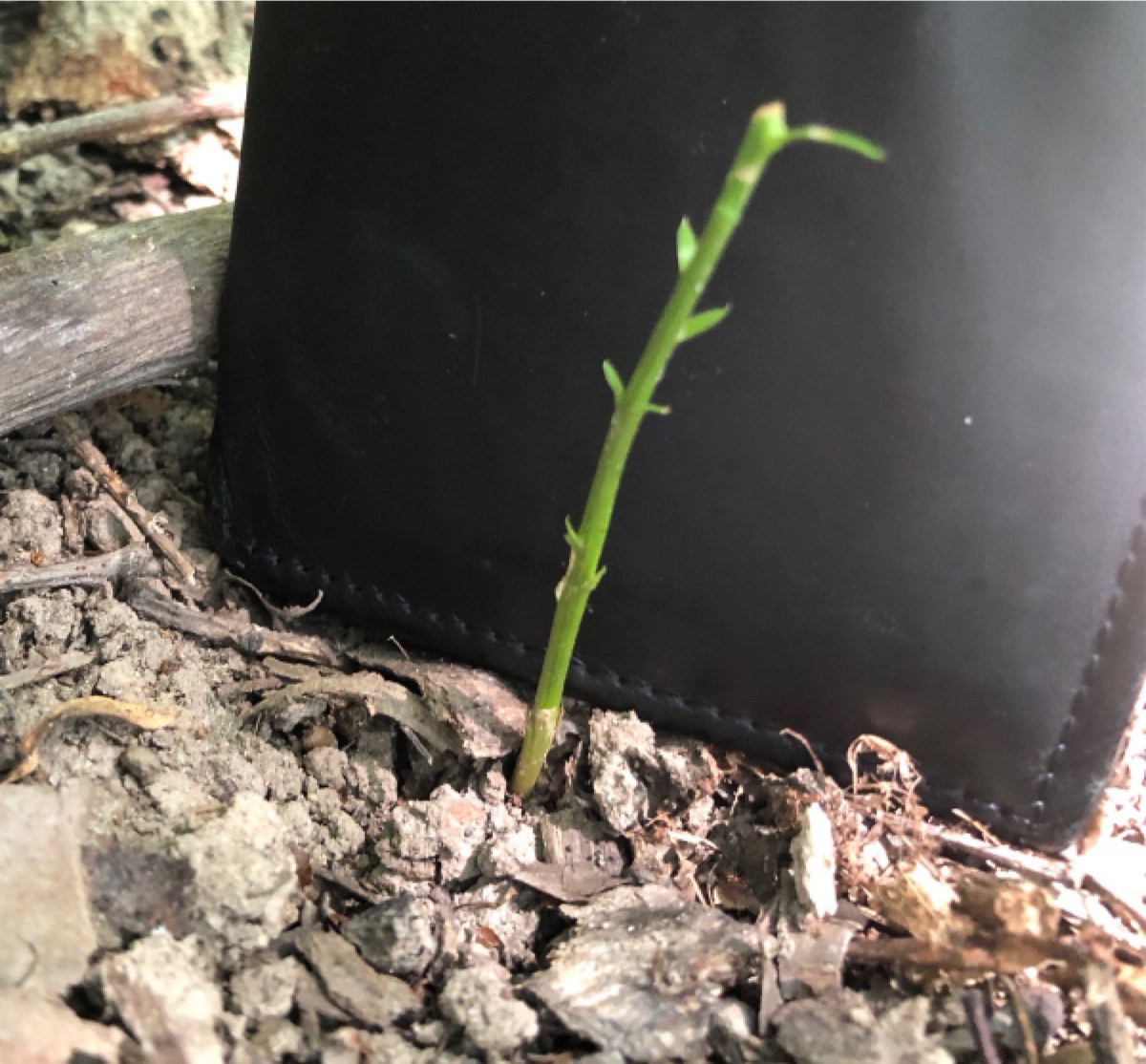
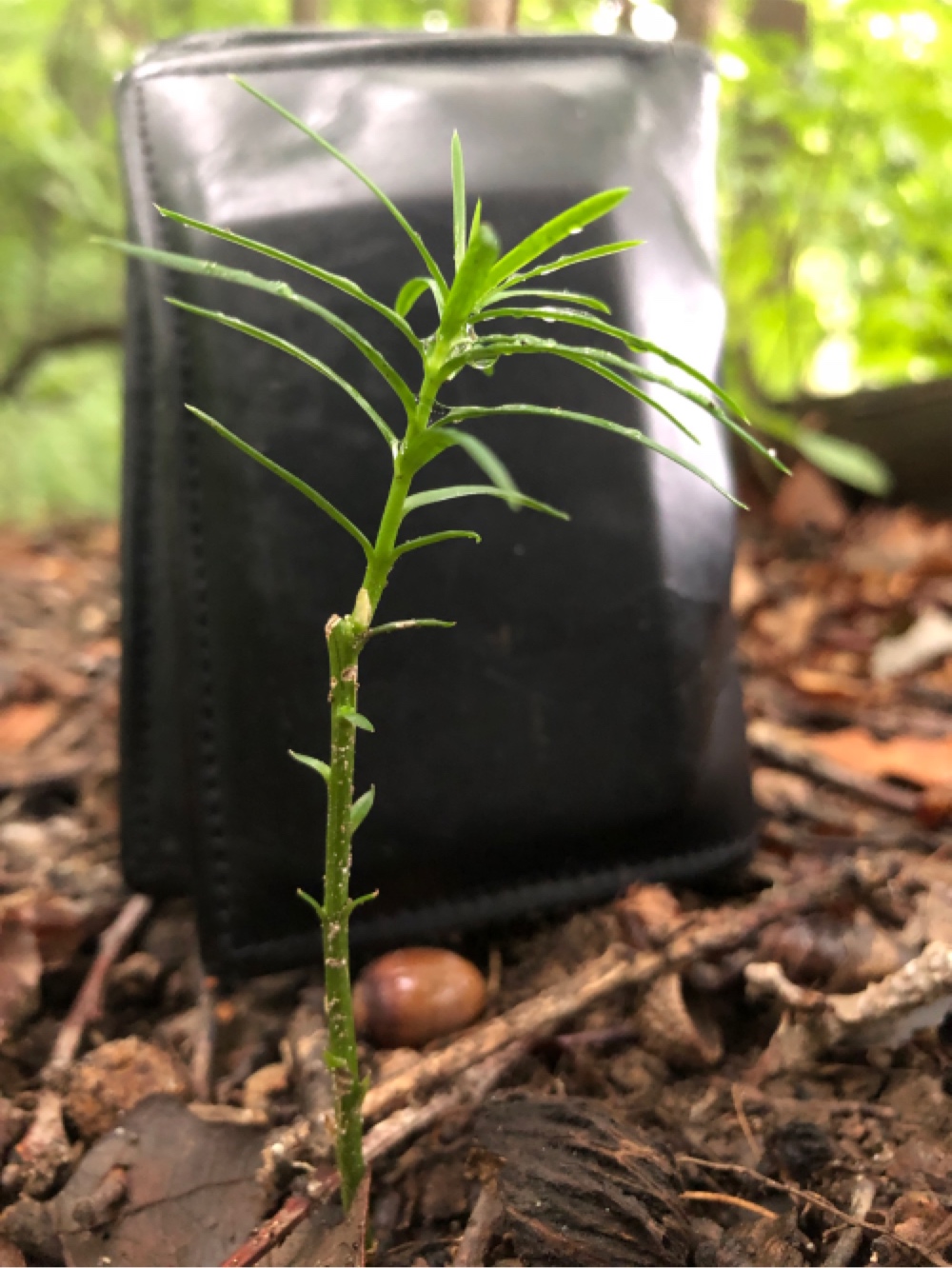
ABOVE LEFT: Summer of 2019, Paul Camire in Capac, Michigan discovered that a number of the seeds he had planted directly into his forest during the spring of 2016 had established seedlings. However, this one's apex and leaves had already been browsed off when he noticed it in July 2019.
ABOVE LEFT: Seven weeks later, that same seedling had remarkably recovered, adding substantial height in new, radially symmetrical leader growth.
RETURN to TOP
• REDWOOD SEEDS are TOO SMALL to MATCH TORREYA'S SEEDLING RECOVERY CAPACITIES
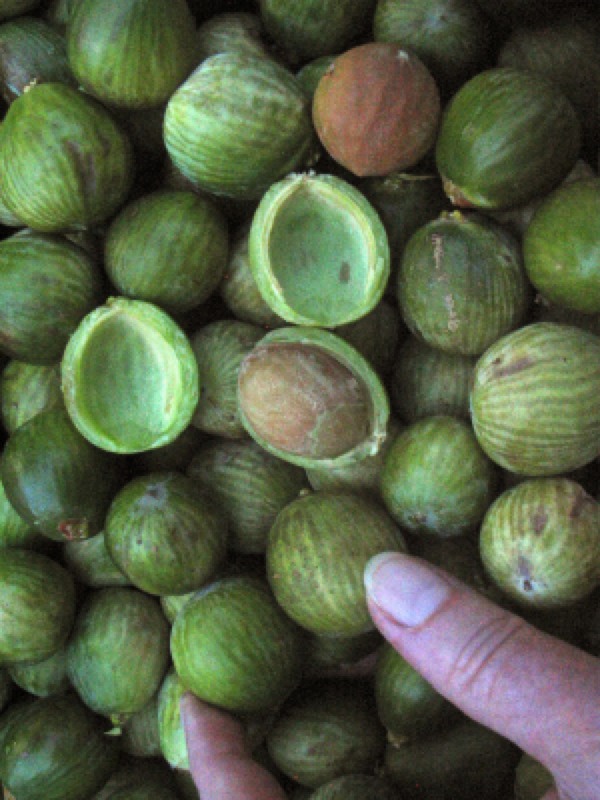
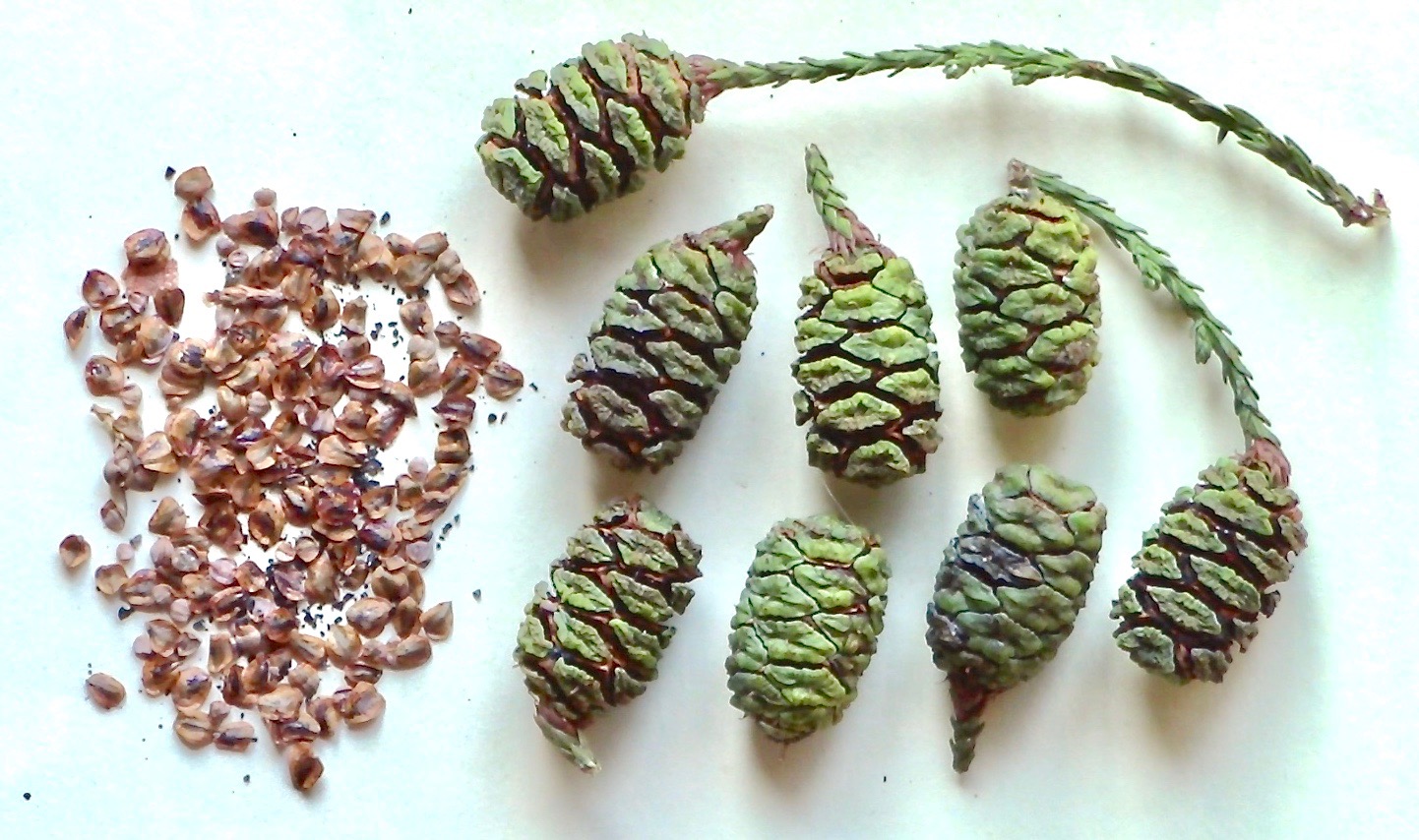
ABOVE: A comparison of Torreya v. Redwood seed sizes suggests that Redwood likely cannot recover from apical herbivory when a very young seedling. Therefore, the experience of Torreya Guardians in observing young seedling recovery likely has little application to redwood propagation from seed. However, recovery from early herbivory of rooted cuttings is likely equally bad for both.
• TORREYAS CAN LEAN; REDWOODS CANNOT
A clue that torreyas are strong contenders at a young age in subcanopy shade is the number of tall trees that are leaning — including the current national champion (as of 2014) and the slowly dying champion that I (Connie Barlow) visited in 2005.
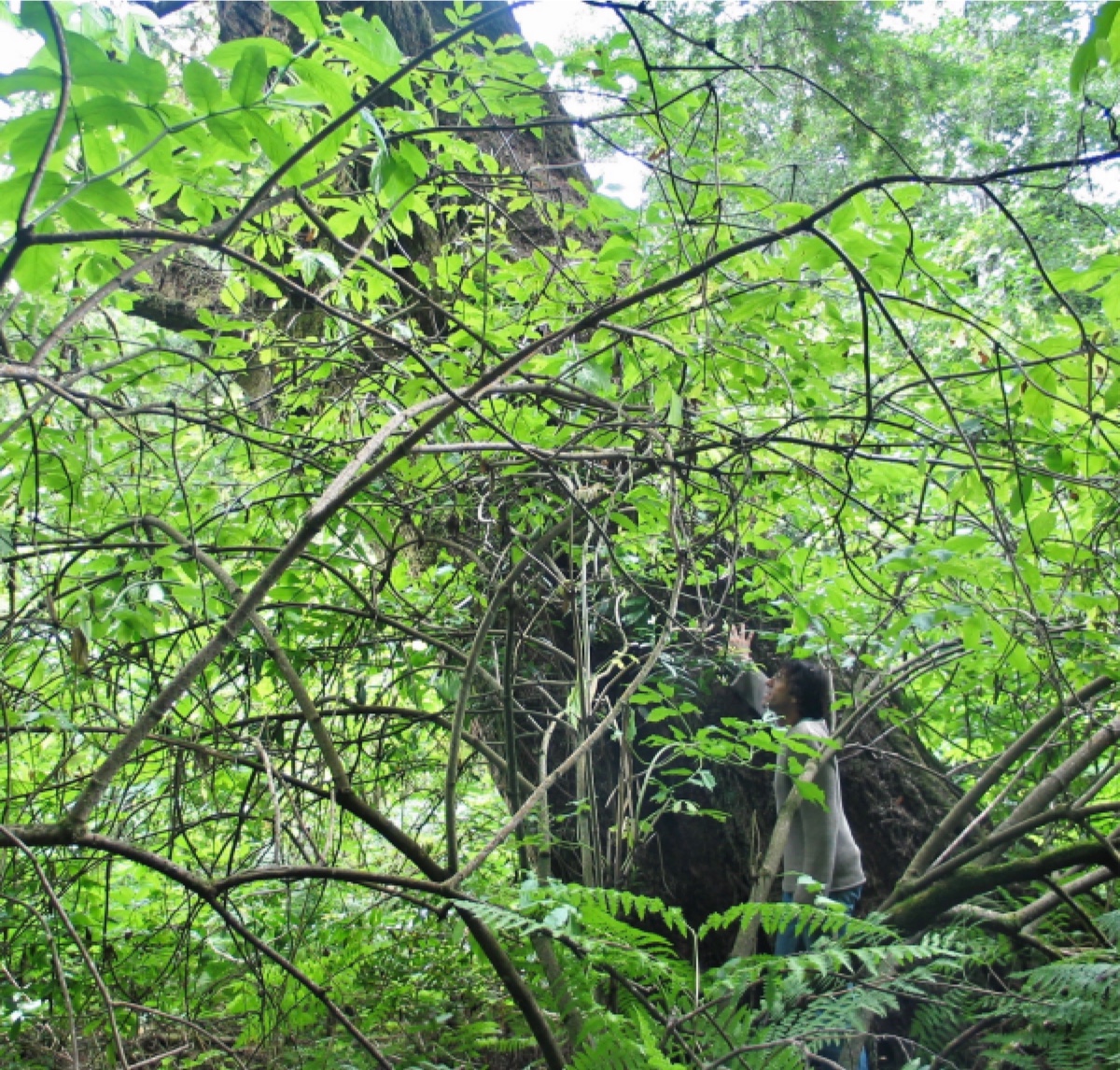
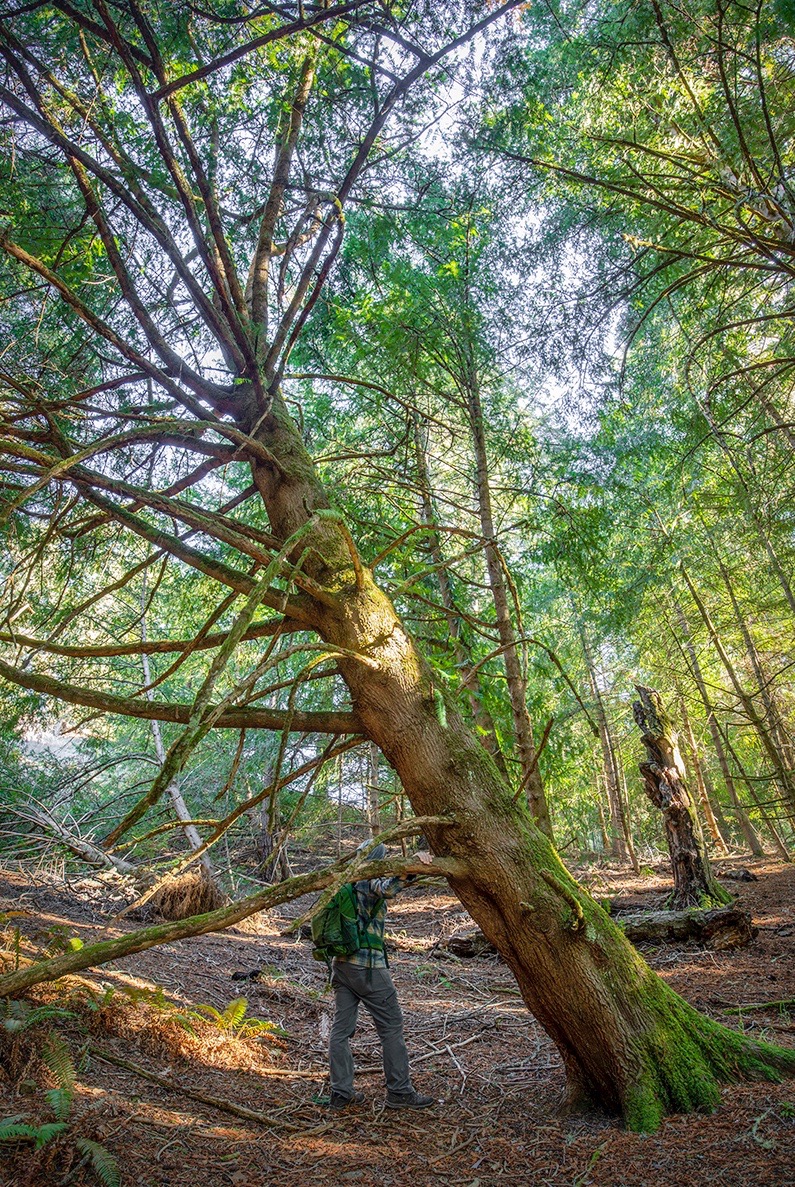
ABOVE LEFT: Seen from particular camera positions, the late-champion north of Santa Cruz (along Scotts Creek) reveals that it began its life journey for many years leaning outward from Coast Redwood canopy shading, which was logged out for building materials soon after the great San Francisco fire of 1906. (Photo by Connie Barlow, 2005)
ABOVE RIGHT: In 2022, Eric Hongisto photographed this leaning Torreya within the San Andreas Fault, east of the creek at Fort Ross State Historic Park. On both sides of the fault are old growth redwoods.
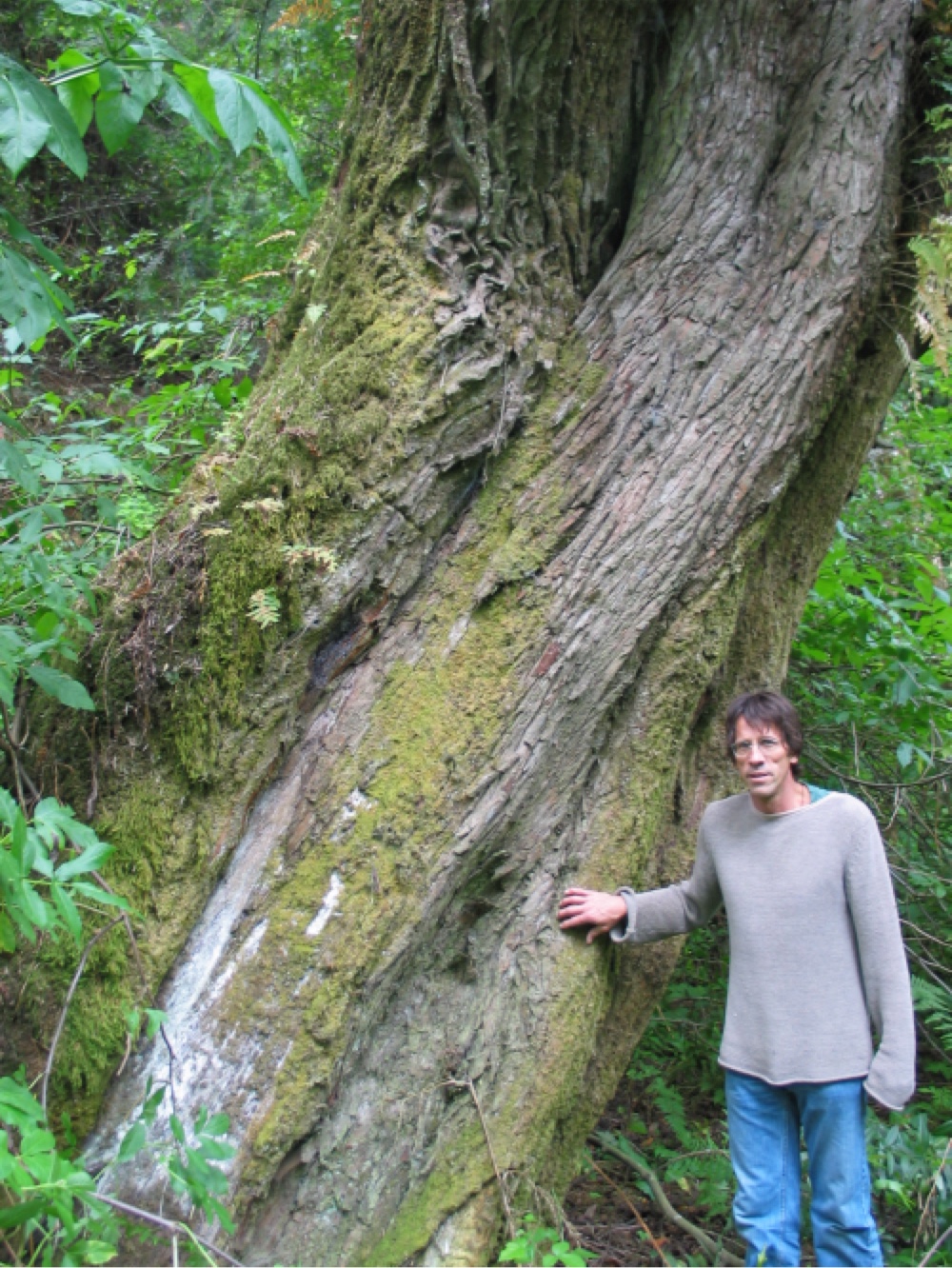
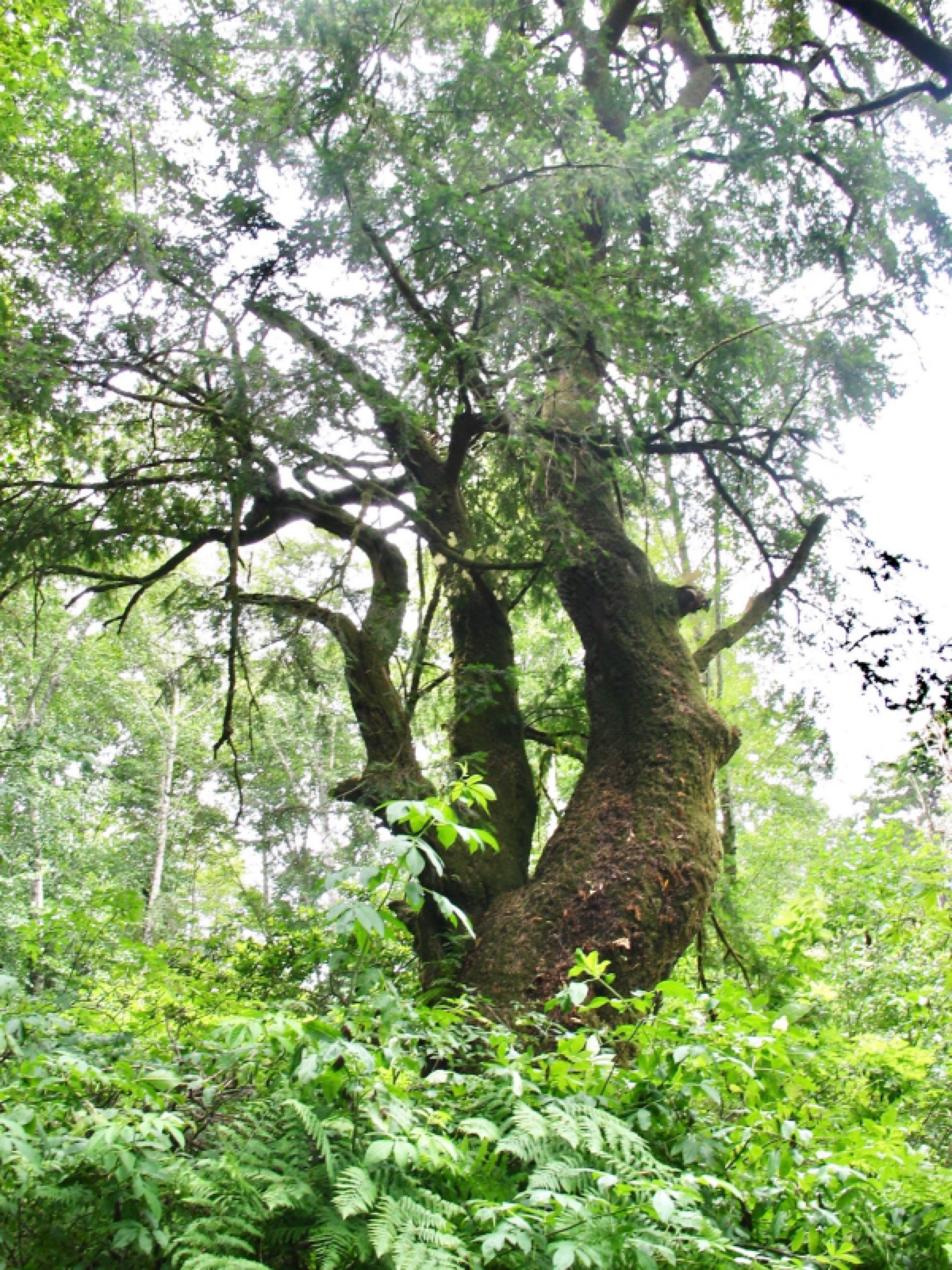
ABOVE LEFT: Another view of the same late-champion Torreya in the Santa Cruz Mountains, as portrayed in the photo in the row above it. In 2005 Connie Barlow took this photo of Lee Klinger, founder of Sudden Oak Life in California.
ABOVE RIGHT: The mid-section of the late champion branched into 3 main stems. Take another look at the top of the above left photo: Do you see signs of multiple stems beginning there — and perhaps all the way to the base? And does this suggest that the tree may actually be the result of several merged basal regrowths?
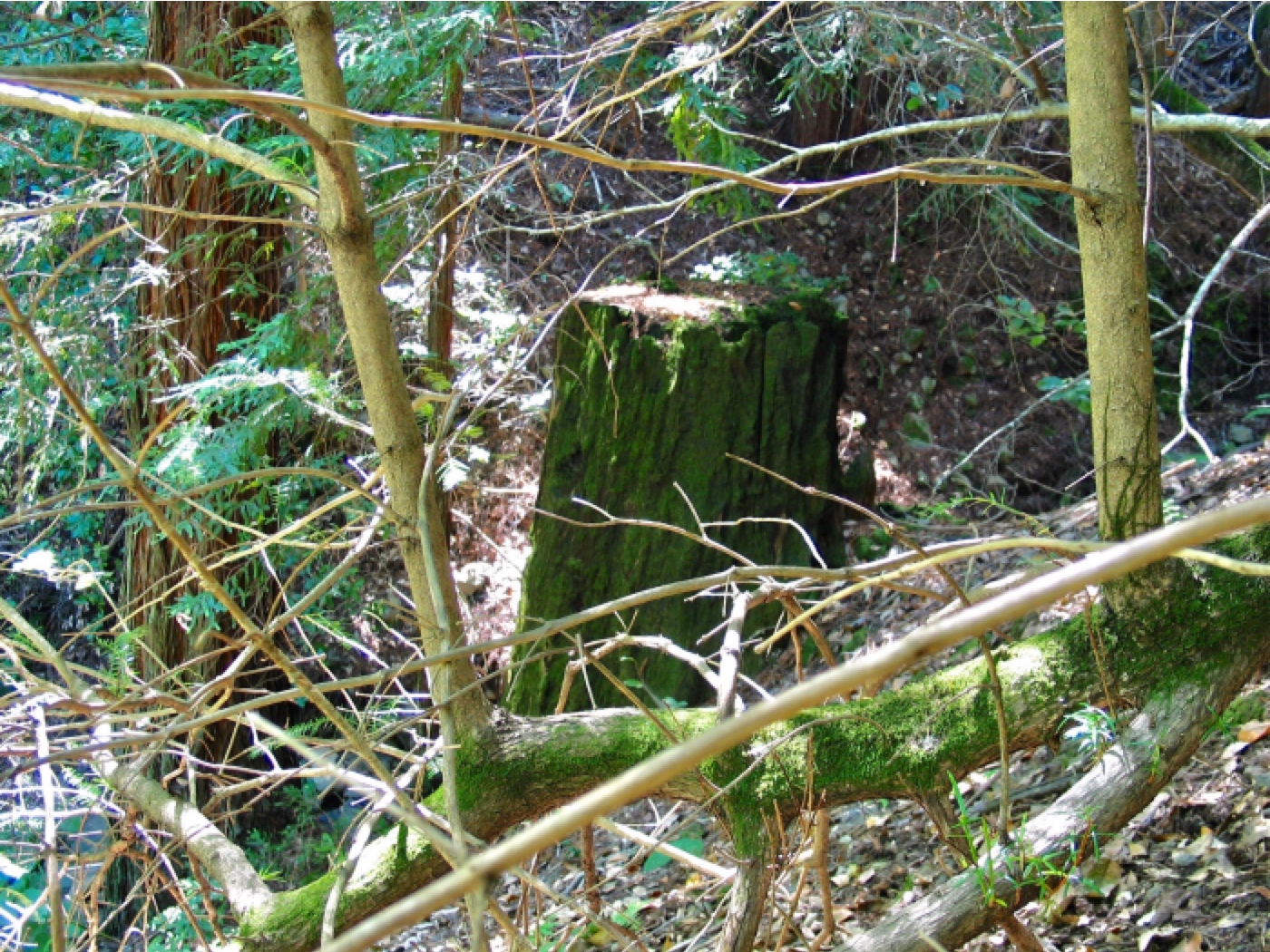
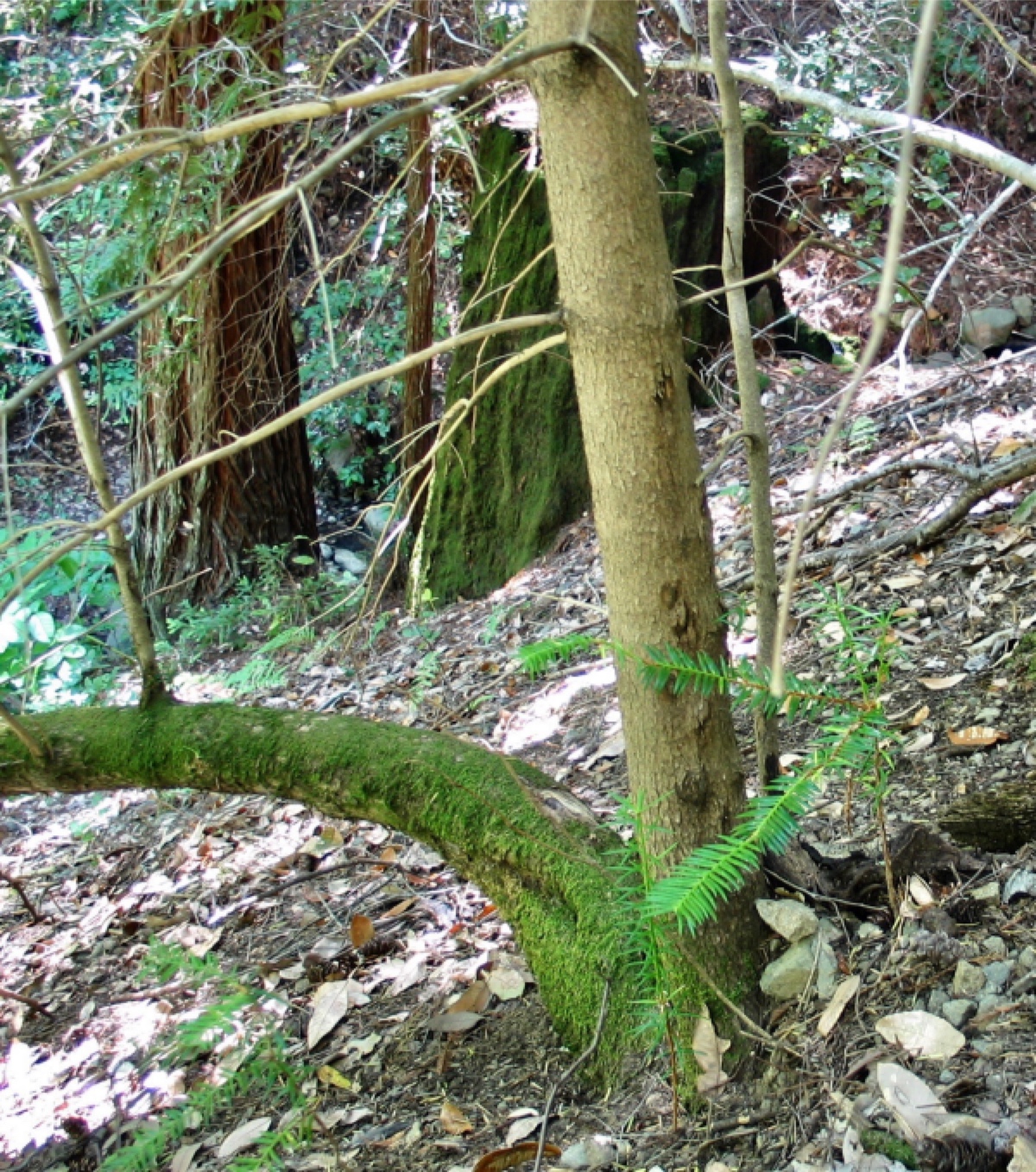
ABOVE: This California Torreya in the Coast Range northwest of Napa Valley evidences extreme capabilities to (a) lean, (b) produce upright stems from the horizontally oriented main stem, and (c) launch a fast-growing upright basal sprout, while the horizontal older stem grows so slowly it is covered in moss. (Notice in the background of both photos the same upright and stump redwoods.)
RETURN to TOP
• TREE-FORM v. SHRUBBY GROWTH of FLORIDA TORREYA in CLEVELAND, OHIO
A good way to begin the TORREYA example of tree-form seedlings v. cuttings from lateral branchlets that, after rooted, will turn only into shrubs is to visit one of the principal volunteers in Torreya Guardians: FRED BESS of Cleveland, Ohio.
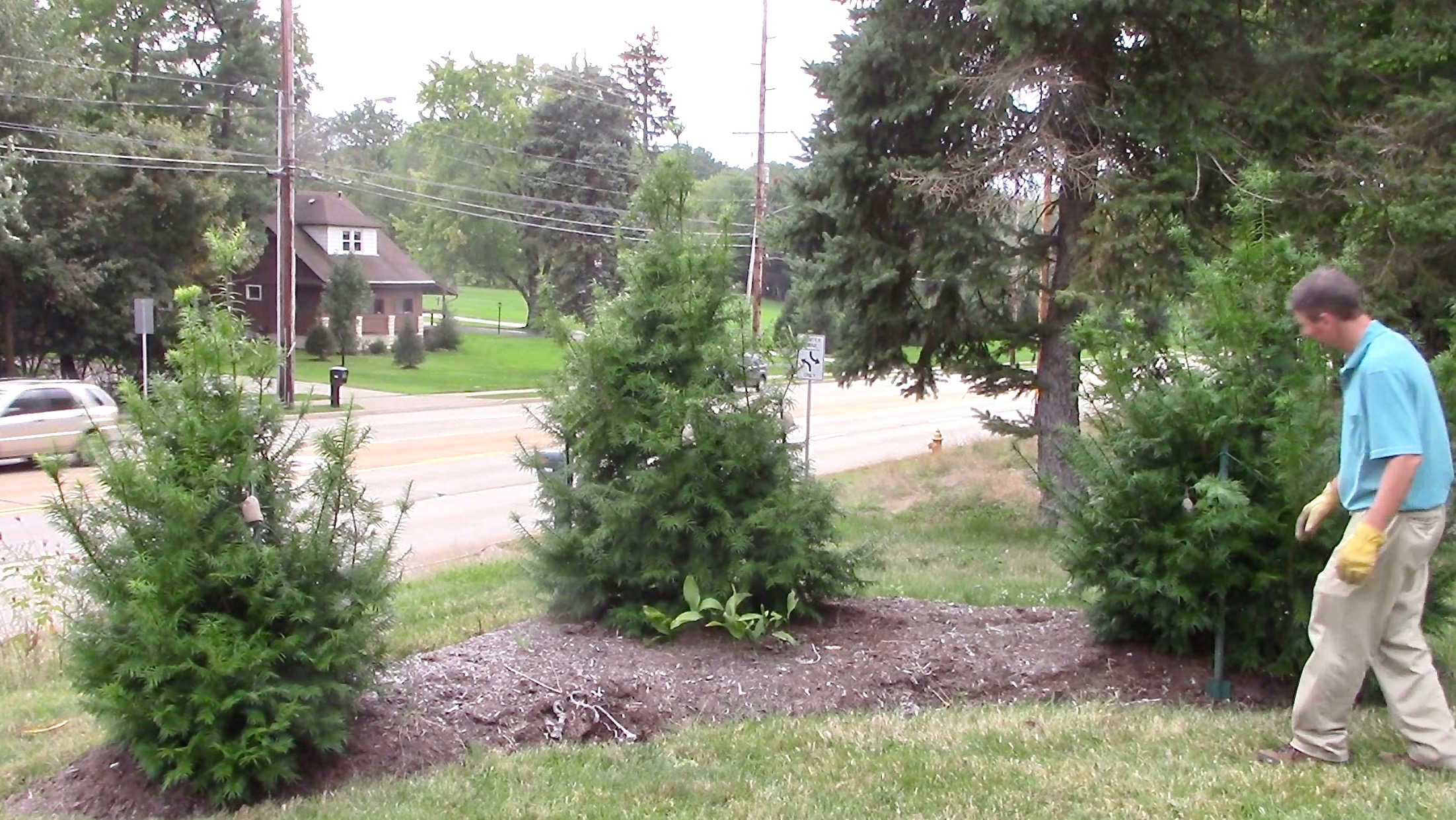
ABOVE: Fred has 3 Florida Torreya trees planted in his front yard. All are getting pretty much full sun — and fierce winter cold. The two on the left are males. The one on the right is female, which began producing seeds in 2018. All began as seeds, not rooted cuttings.
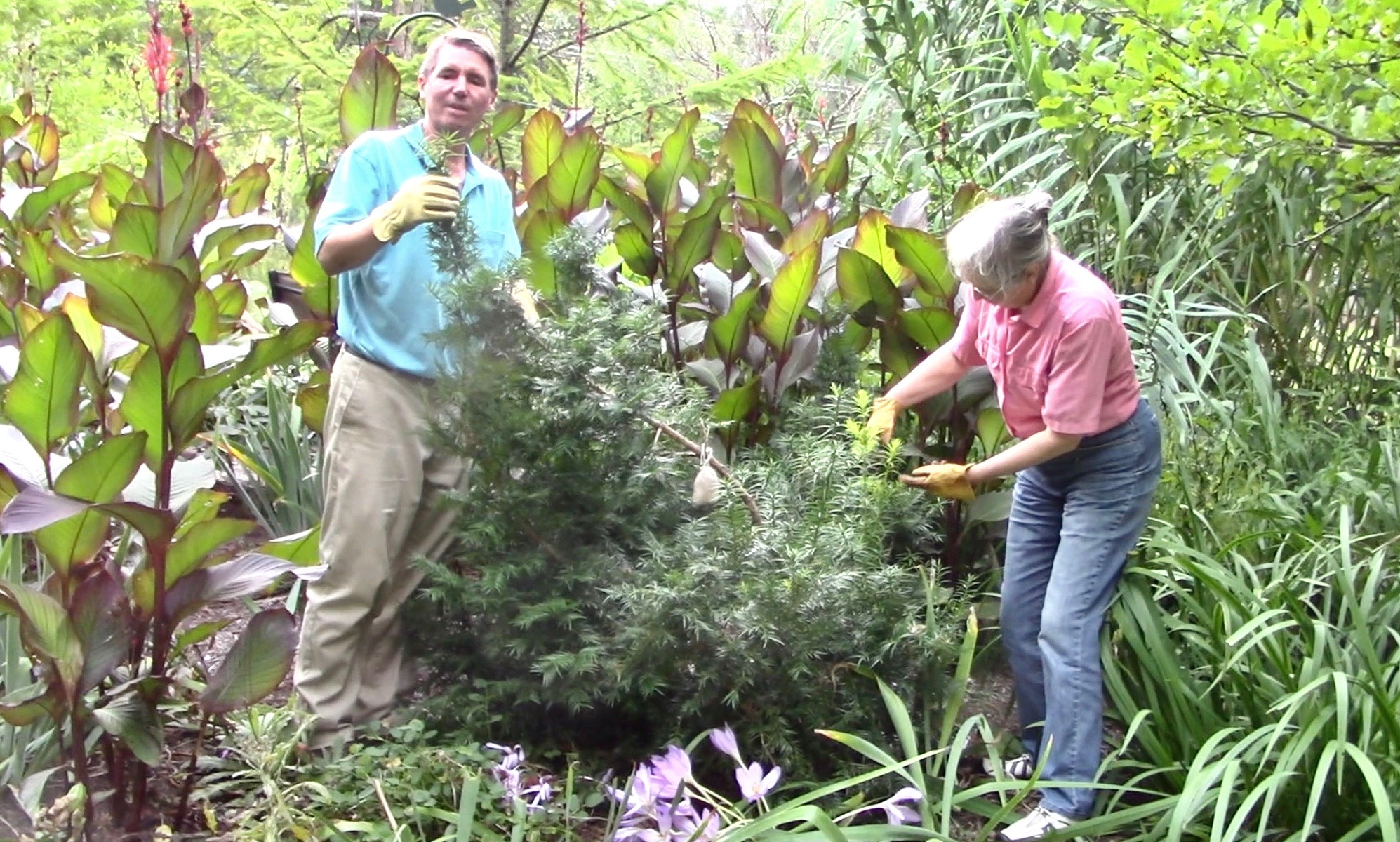
ABOVE: Fred has one Florida Torreya grown from a rooted branchlet, which he planted in his backyard. Although it is shrubby, it is a very valuable female and now also produces seeds. (Connie Barlow is in the picture, as she visited Fred October 2018 just before he harvested the seeds.)
WATCH THE 16-MINUTE VIDEO Connie posted of her visit: "Seeds of Florida Torreya Produced in Ohio.
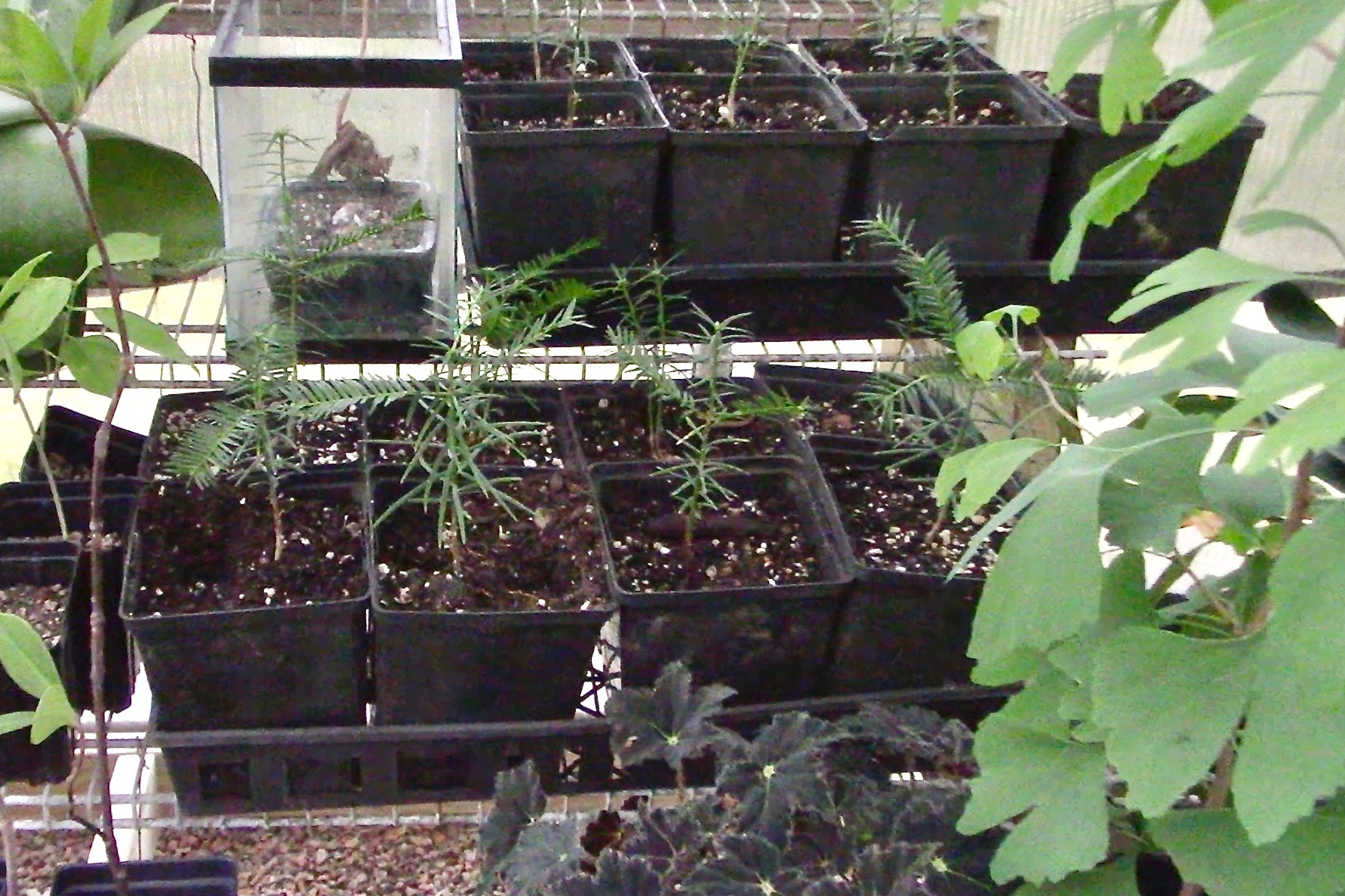
ABOVE: Fred has a lot of experiments ongoing in his greenhouse. Here are several very young torreya seedlings, nurtured from seeds. (Ginkgo leaves on the right.)

ABOVE: After 1.5 years in his greenhouse, Torreya Guardian Fred Bess (Cleveland, OH) achieved successful rooting of 3 of 5 branchlet cuttings he had collected from the shrubby Florida Torreya in Spring Grove Cemetery, Cincinnati during his visit there in December 2019. (See photos from that visit directly below.)
Fred has learned that rooting branchlet cuttings of Florida Torreya will not automatically grow into trees. One advantage, however, is that successful rootings of such cuttings will produce male and female cones several years earlier than will trees grown from seed.
| |
LESSON: For certainty in establishing trees from cuttings, the upright BASAL SPROUTS should be the cutting source — not cuttings from branches on the tree, nor from any of the small lateral branches that may have emerged on basal sprouts. Only vertical stem material of the basal sprouts should be used.
|
|
RETURN to TOP
• TORREYAS GROWN FROM LATERAL BRANCH CUTTINGS FORM MASSIVE SHRUBS
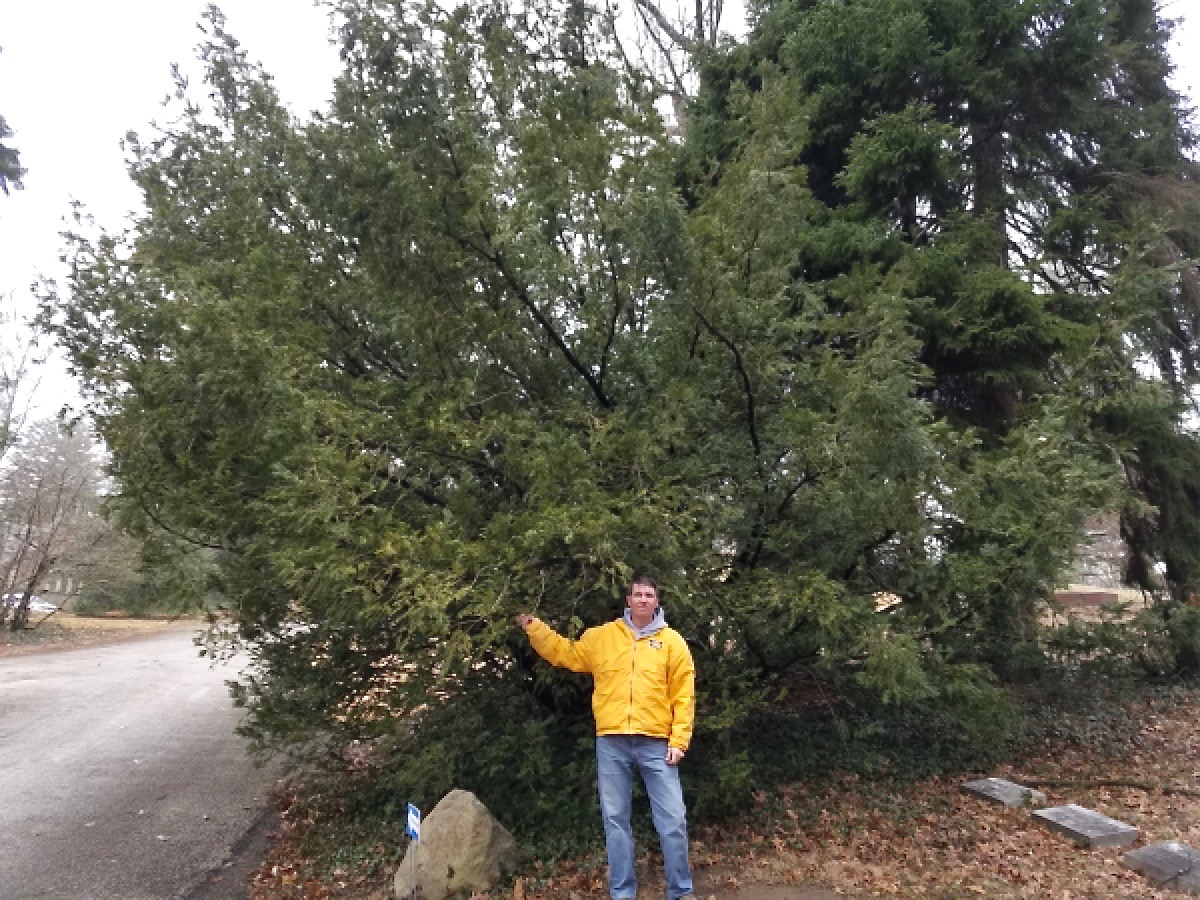
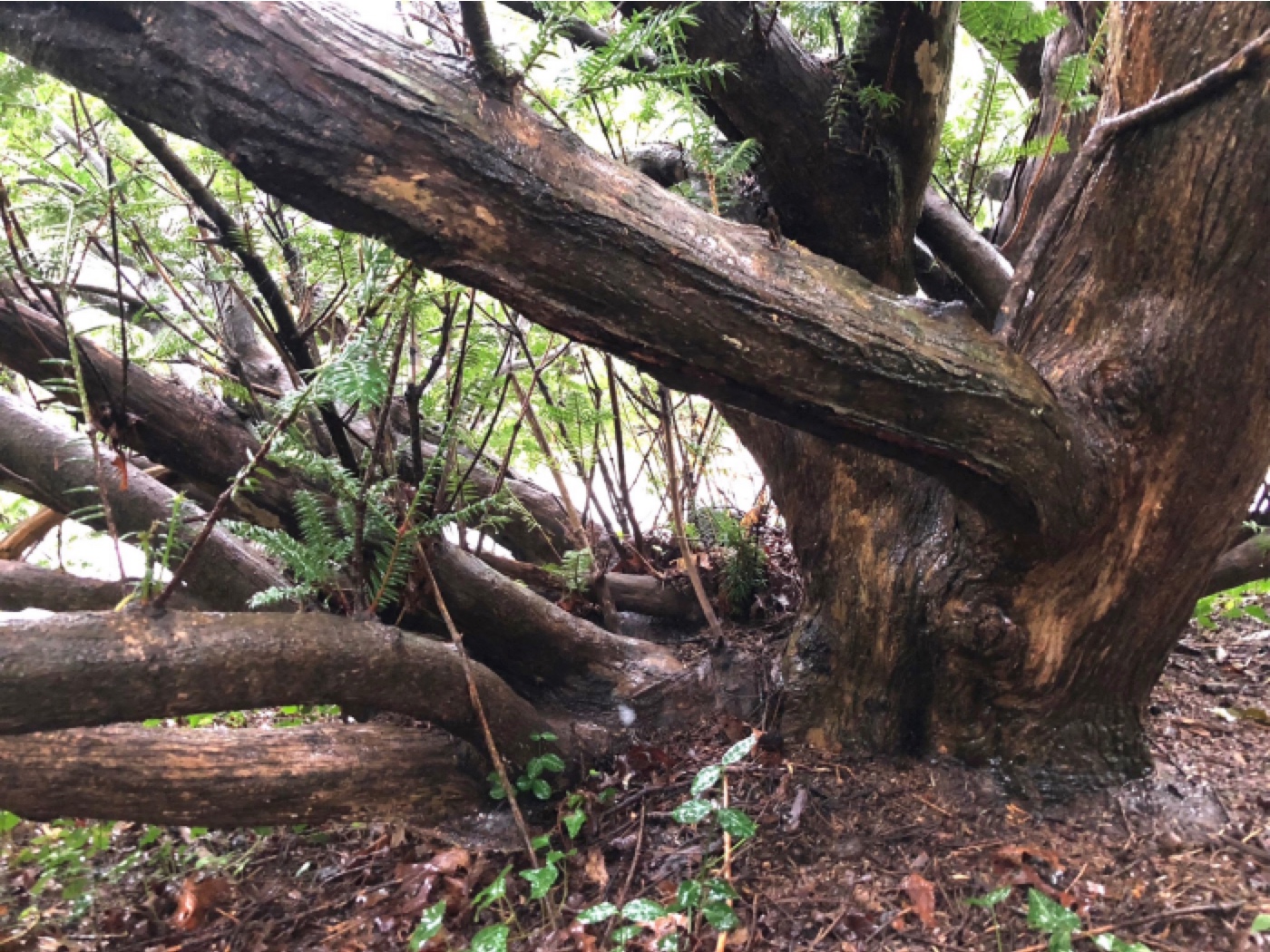
ABOVE: Torreya Guardian Fred Bess (Cleveland, OH) with a shrub form of Florida Torreya at Spring Grove Cemetery (Cincinnati).
BELOW: A 30-year-old shrubby form of Florida torreya at a horticultural planting in Medford, Oregon.
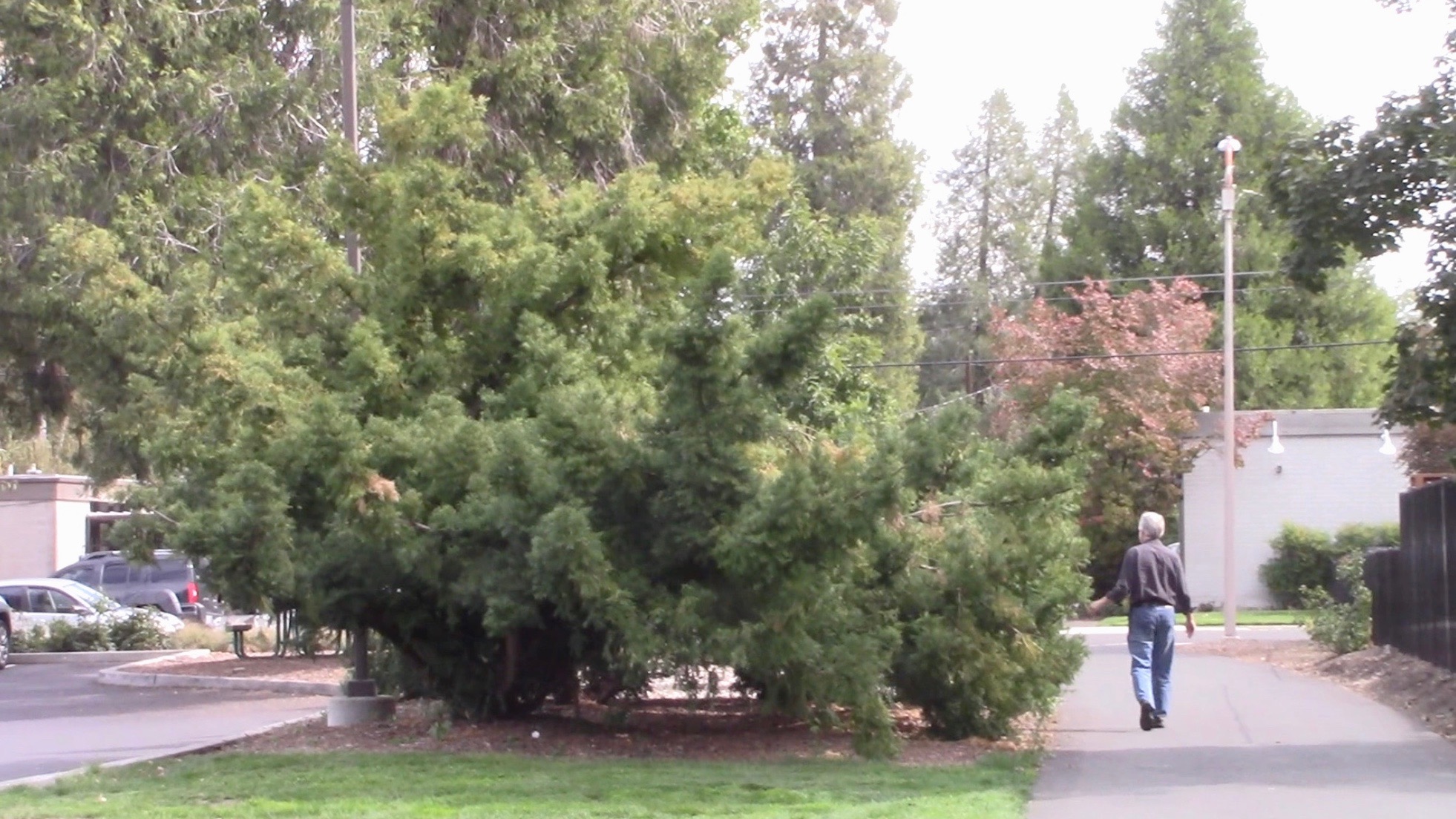
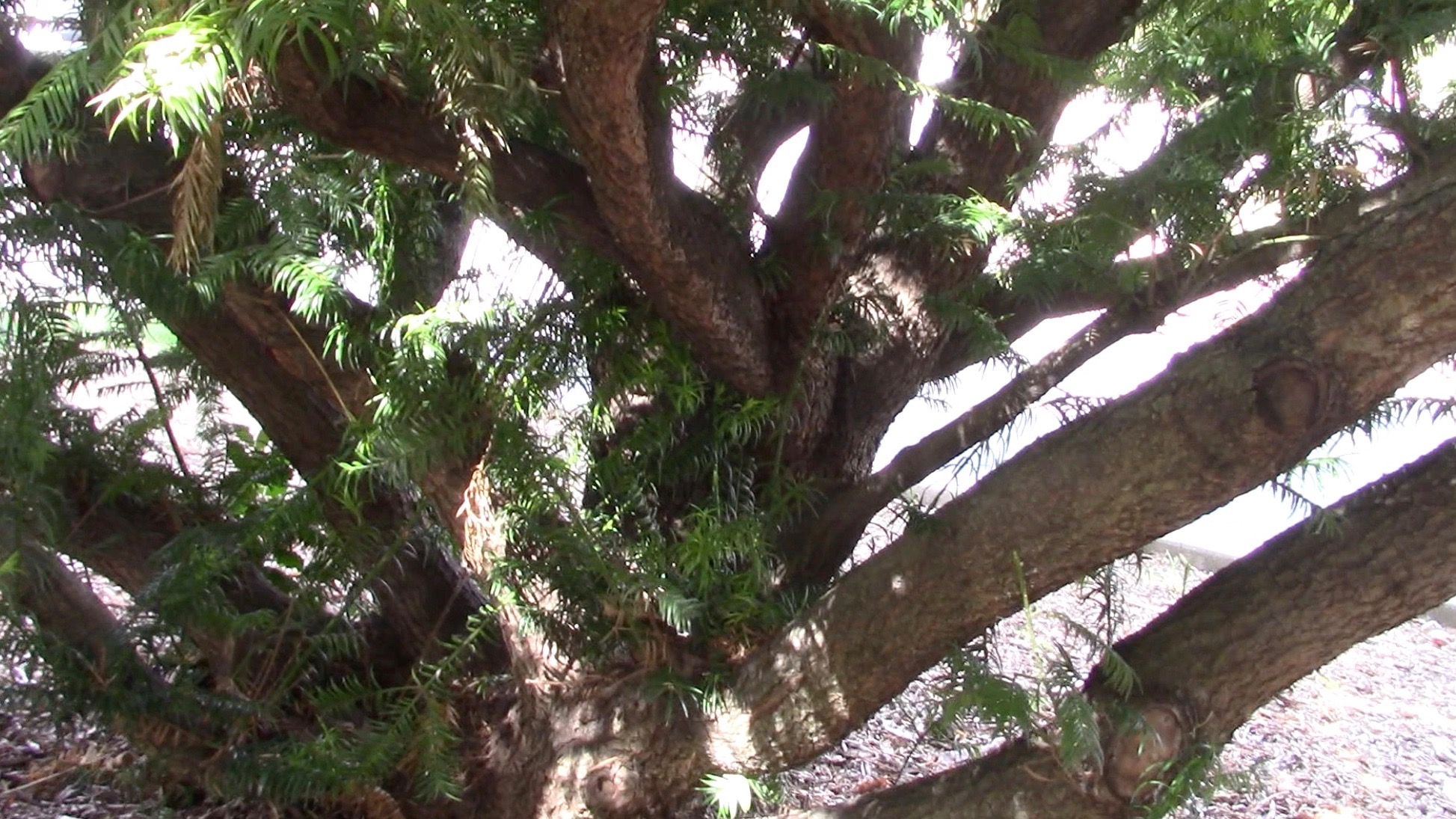
| |
QUESTIONS re the above shrubby torreyas:
1. Why have none of the thin sprouts emerging from the thick, lowest stems surged upward vertically? (Are they not authentic "basal sprouts"?)
2. Does this confirm the inability of a rooted lateral cutting to ever reorient on its own into a tree form?
3. Are rooted lateral cuttings unable to develop a lignotuber and to sprout true basals?
4. Could early staking of an off-kilter stem growth have corrected the problem and thus eventually yielded a tree?
5. Or is it impossible for genus Torreya to achieve a tree-form from a lateral cutting at a late age — and perhaps even soon after rooting?
|
|
RETURN to TOP
• CUTTINGS FROM BASAL SPROUTS readily grow into a TREE FORM
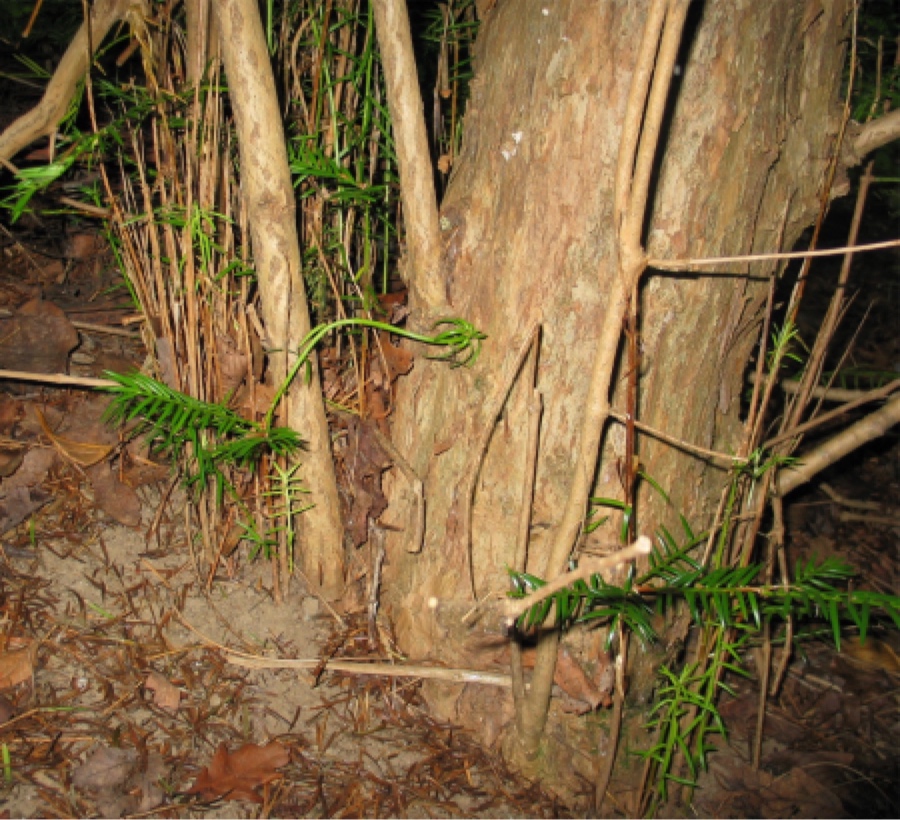
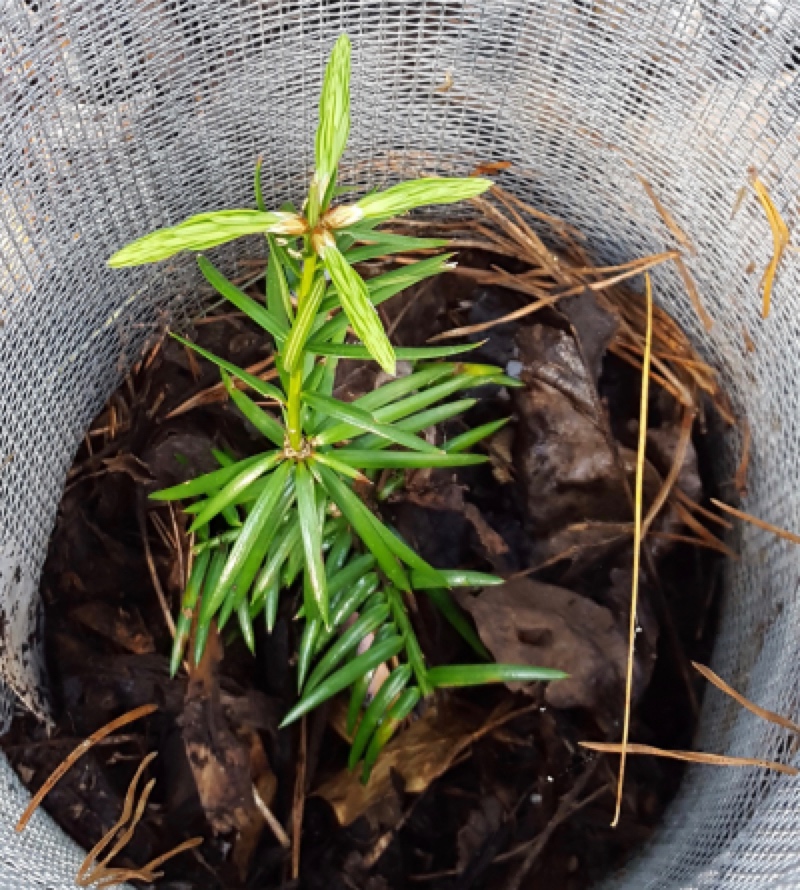
ABOVE LEFT: October 2017 Torreya Guardian Clint Bancroft (near Chattanooga TN) collected cuttings from the profusion of basal sprouts in the grove of Florida Torreya trees at Harbison House in Highlands NC.
ABOVE RIGHT: 2.5 years later (April 2019) Clint documented that this basal tip cutting had rooted and achieved budburst of a classic radial structure. This was a sign that the tree form would likely be maintained on its own, and with no less vigor than what a seed achieves naturally.
BELOW: One year later (March 2020), Clint was ready to plant this successful rooting of a basal tip cutting. He photographed the plant just out of its pot, and was thrilled to see the richness of its root development.
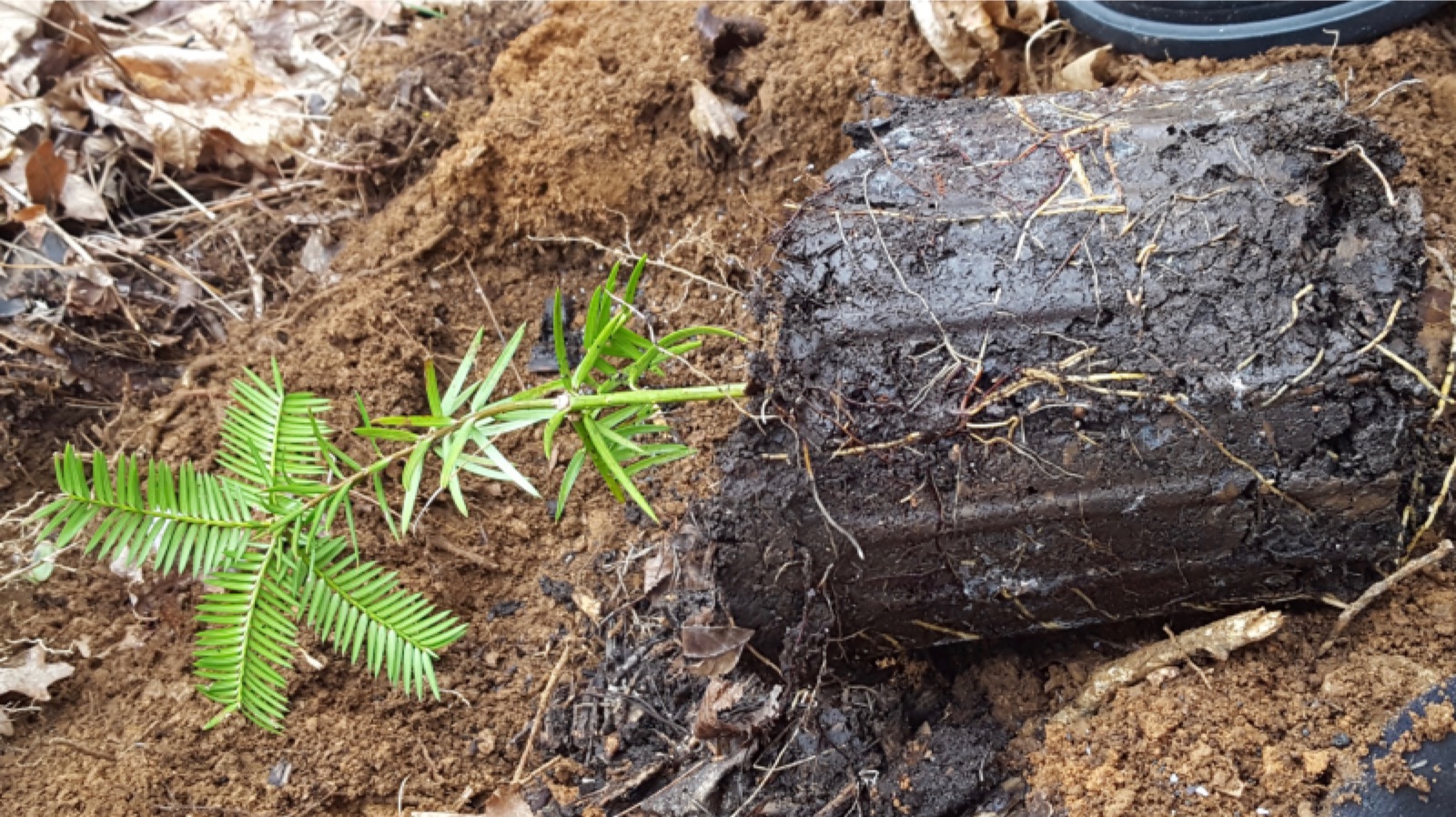
• BASAL SPROUTS that have adequately ROOTED can recover from HERBIVORY
Also in April 2019, another of the basal tips that Clint Bancroft had cut in 2017 at Harbison House (Highlands, NC) had rooted, but then herbivory struck! He wrote:
"I had an apical cutting of a basal from Highlands NC, about 6 inches tall, that had rooted. This year it put up its first fresh vertical (another 6 inches, but no lateral growth yet). It looked beautiful! I left it sitting on top of the cage, 4 feet off the ground, and damned if something did not eat ALL of the new vertical and also about 2 inches off the top of the original cutting. I suspect it will survive, but I have lost a whole year's growth. It will be interesting to see if a chopped off, rooted, apical cutting will establish a new leader."
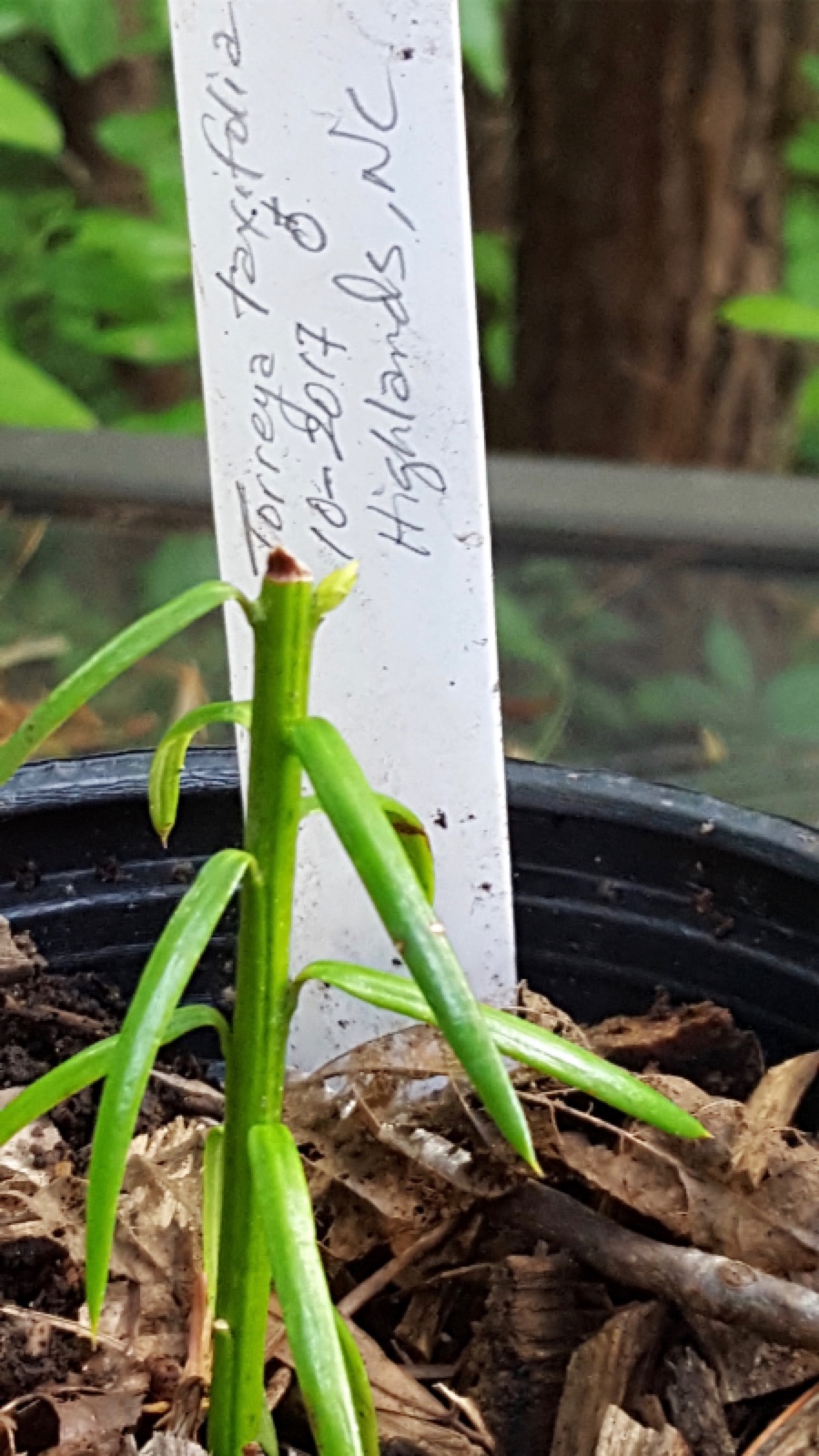
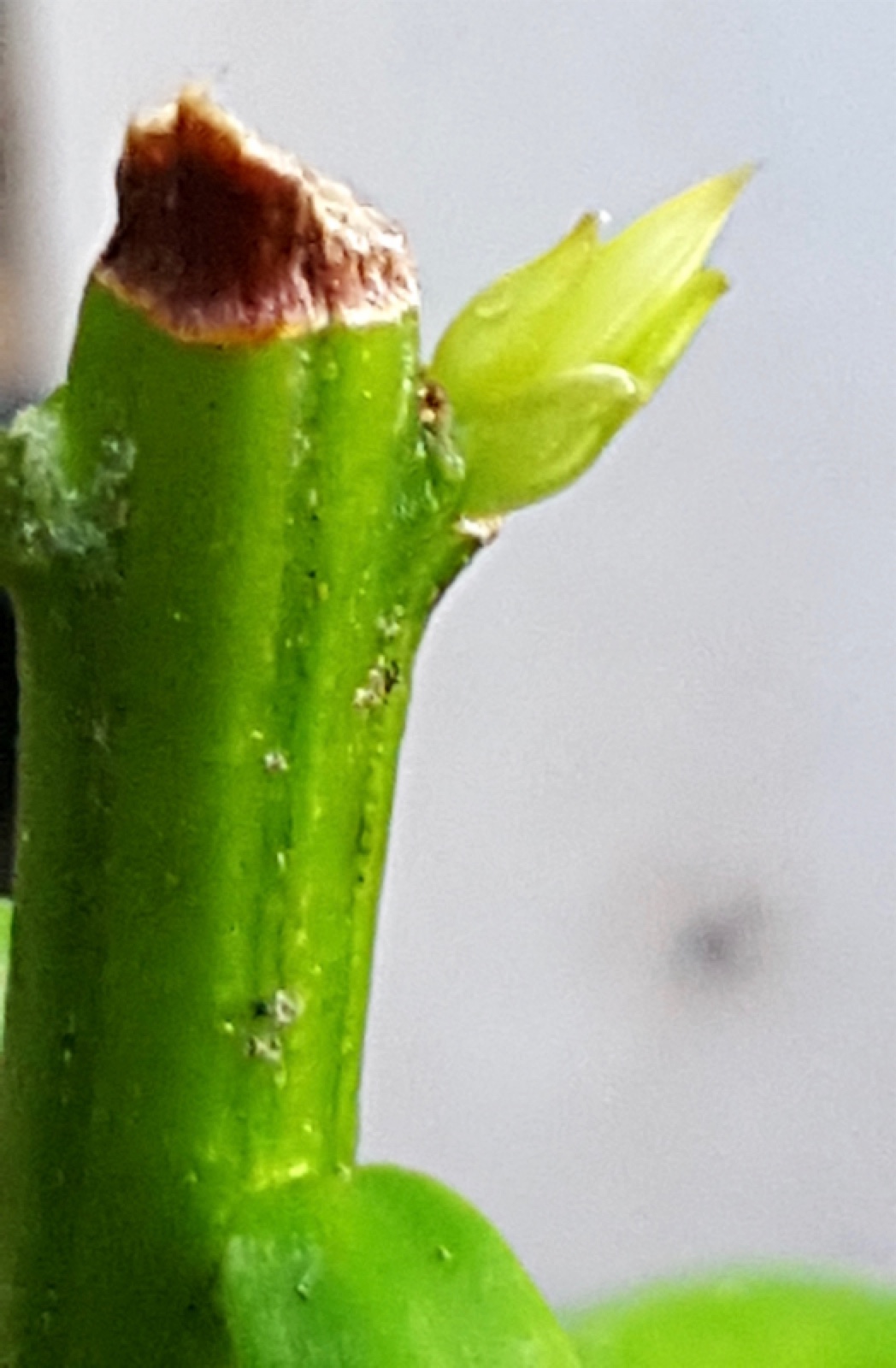
ABOVE: June 2019 Clint Bancroft sent the above two photos with this note:
"Regarding my accidental experiment in which a rooted apical cutting had put up a new 6 inch vertical and then all but a few inches of the whole plant was eaten down. Well, in just 2 months, the eaten-down stump is putting up what appears to be a new vertical leader."
CONNIE BARLOW replied to Clint Bancroft, August 2019:
"I am reading about Coast Redwood basal growth and propagation now. Genus Sequoia and Torreya have both probably survived this long thanks to their ability to produce new stems from basal growth if the original stem fails (or is logged). The term for what we see in the close-up photo you sent (above) is an axillary bud. That bud is doing what it evolved to do: produce a new vertical leader.
Apparently, all single leaves produced on the vertical main stem of a basal each carry on their upper side a suppressed axillary bud. For redwoods, each of those buds can become either a vertical leader or a root, depending on whether it senses air or soil when hormones direct it to wake up.
Torreya, we now see, can do the same. We should be able to obtain more than one vertical clone from each basal sprout we cut from. It is possible that not only rooting but also new leader growth may be even easier to induce in segments of the stem BELOW the uppermost top that you have used in your first experiments."
CLINT BANCROFT collected more basal apicals at Harbison House in Highlands October 2019. He wrote:
"The Highlands Torreyas all look to be healthy. I took about 20 apical cuttings [of the prolific basal sprouts]. Jack took a bunch of laterals. I am about through with laterals, since they have been failing to put out new growth in spite of having rooted some years ago. So maybe this latest group will do well. Hated to appear greedy, but the property is for sale and I never know if this will be our last access to this grove.
UPDATE on previous seed/cuttings collecting at Highlands: I have one seedling that grew from a Highlands seed and several Highlands cuttings (apical) that are coming along well.
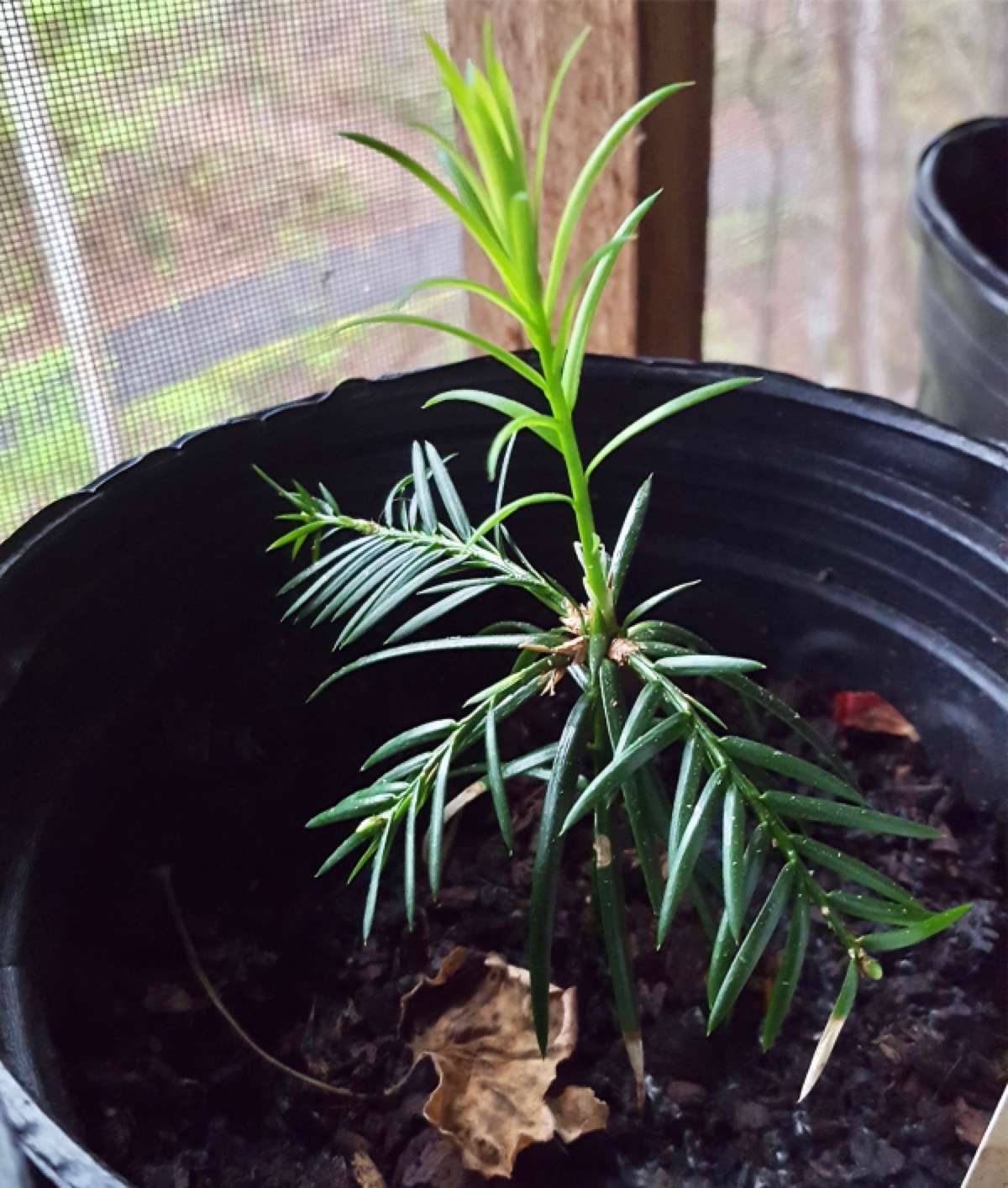
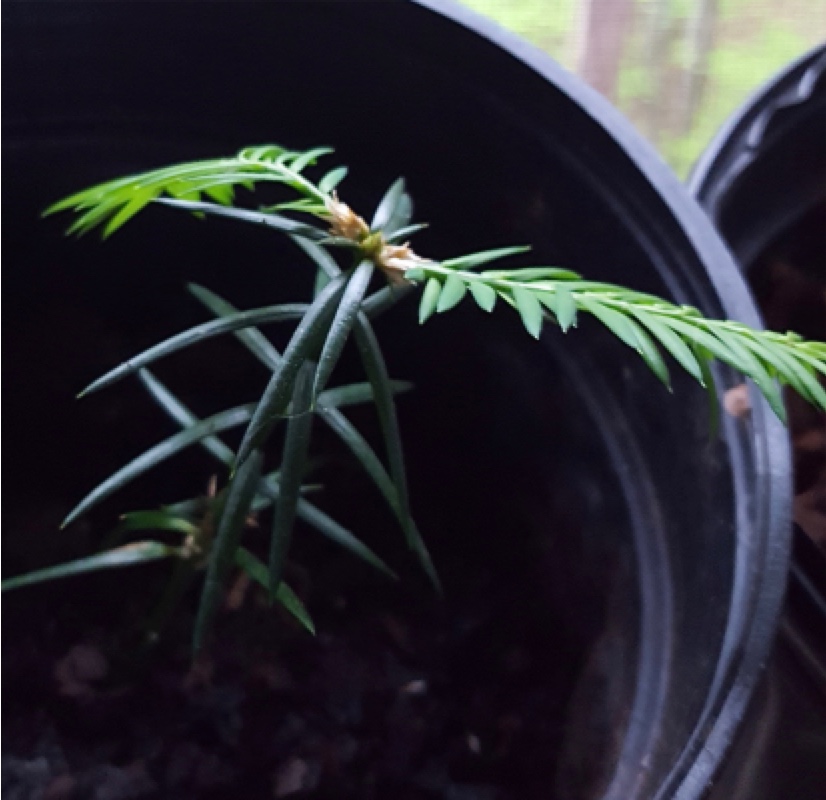
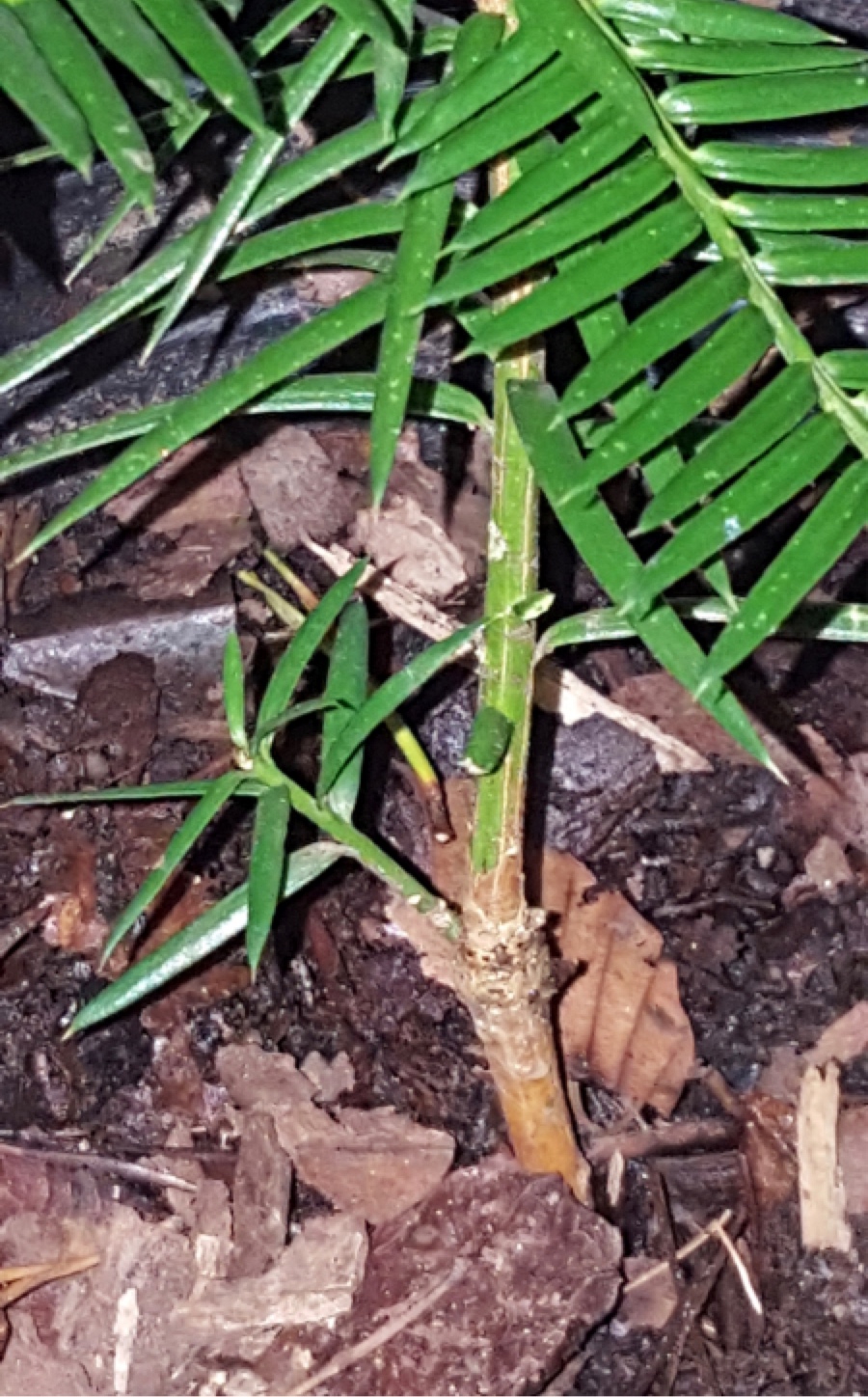 |
|
MORE PHOTOS by Clint Bancroft of his success in propagating tree forms from the apical tips of basal sprouts of FLORIDA TORREYA.
ABOVE: JUNE 2020, Clint reported that 7 more of the basal tips he had collected OCTOBER 2017 from Highlands, NC had put forth a first flush of new growth. Two of the seven documentation photos are above.
LEFT: September 2022:, a basal sprout has formed on the lower stem of a rooted apical cutting of a previous basal stem that had been harvested October 2017 at Harbison House in Highlands, NC.
|
| |
RECOMMENDATION (in 2023): The (redwood timber company) literature recommends cutting basal sprouts into segments that each contain no less than 3 leaves or visibly unopened buds. This way, at least one axillary node will be above the ground surface and one below. The upper will become a new leader and the lower will develop the roots.
Equally important is that the longer a stem segment is, the more difficulty it likely will have in rooting and budding. This is because a greater length of stem must be kept alive while the initial root is forming. So cutting up a long basal into segments of no more than 3 or 4 nodes may produce the best results. Torreya Guardians are now testing "non-tip sections of basal sprouts." (See the Clinton NC photo-section below.).
|
|
RETURN to TOP
• TESTING NON-TIP VERTICAL SEGMENTS OF BASAL SPROUTS CUTTINGS
November 2019, in Clinton, North Carolina, Clint Bancroft collected cuttings from basal sprouts at the large, seed-producing Florida Torreya tree in the front yard, along with several of its older offspring in the backyard.
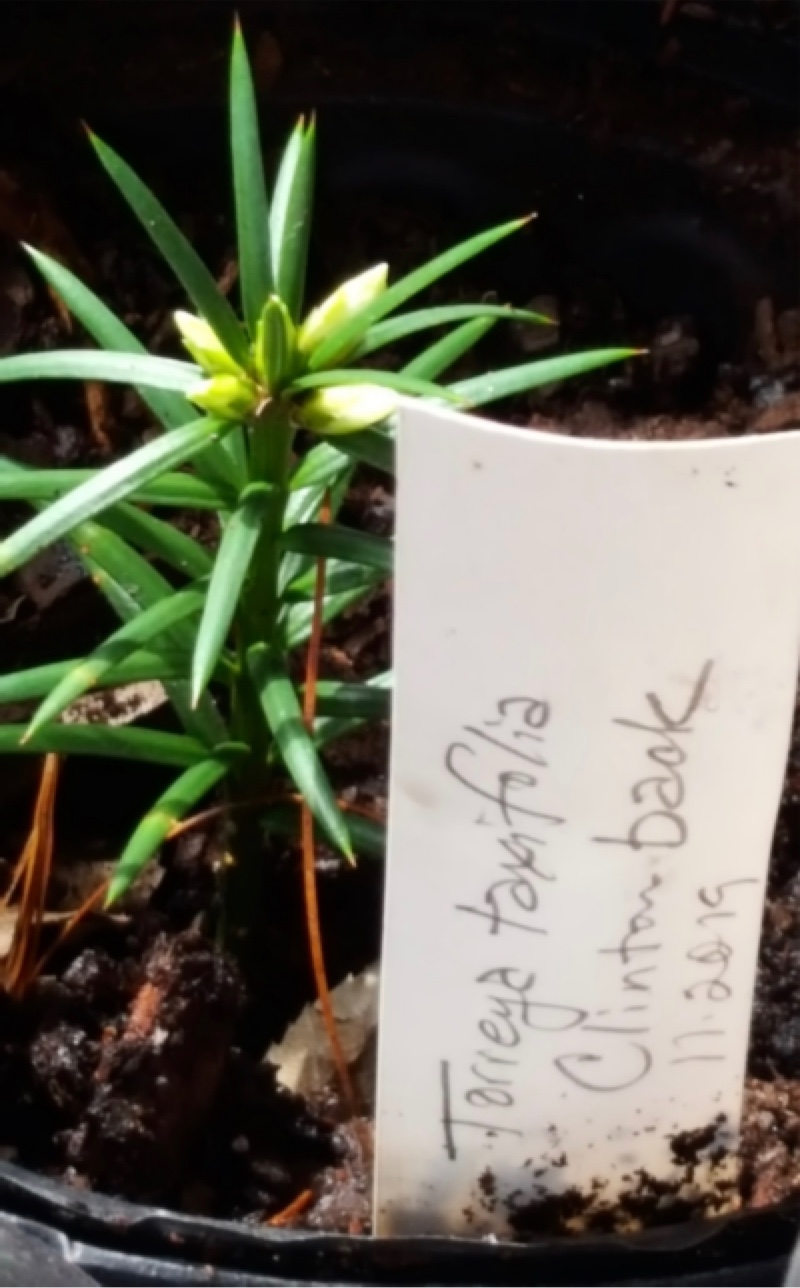
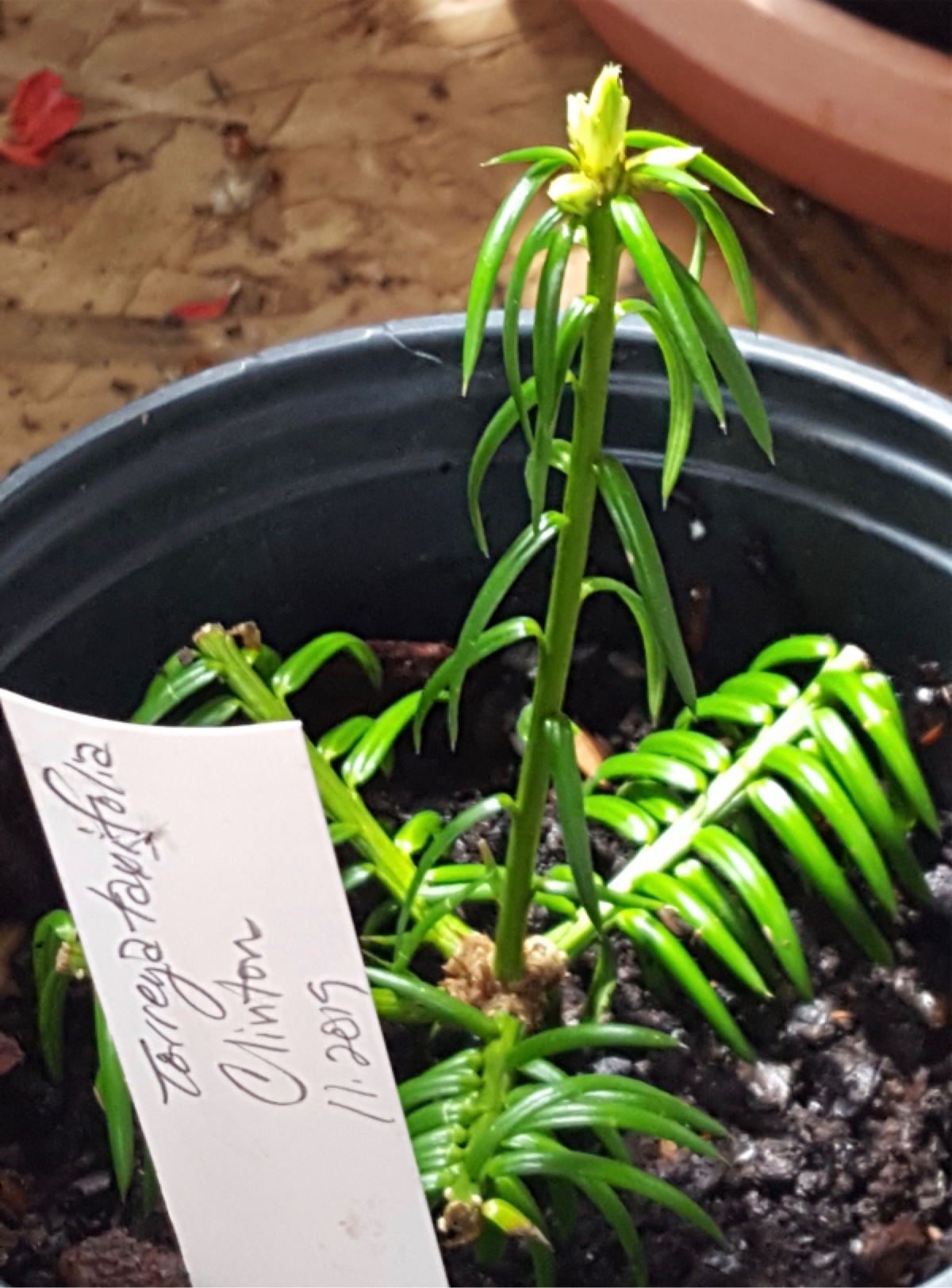
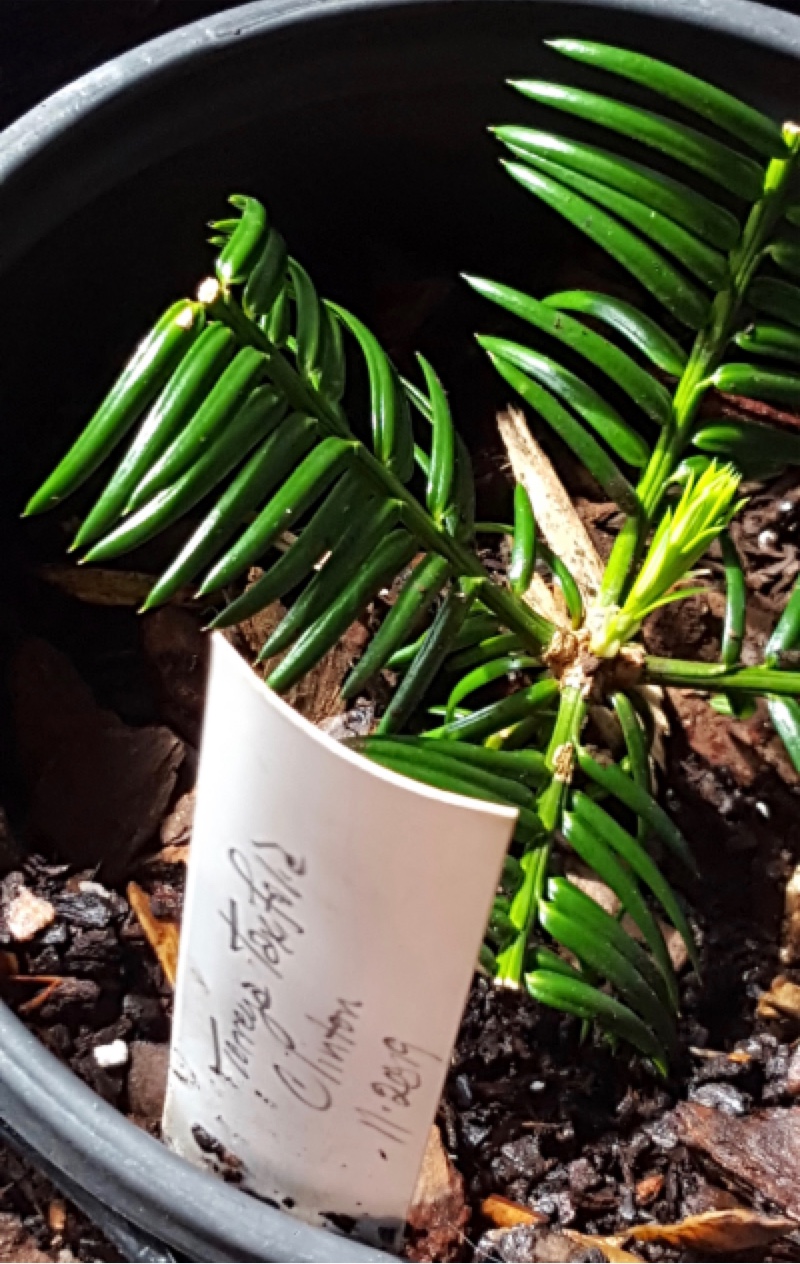
ABOVE: Remarkably, the apical tips of BASAL SPROUTS began to show fresh budding of leaves in March 2020 — just 4 months after they were harvested.
Additionally, lower segments of the long basals are also in pots for rooting and being tested for possible leader growth. As of March 2020, the non-tip segments had not died — but they hadn't shown any above-ground evidence of new growth yet. Clint wrote:
"The tip cuttings all had buds ready to go, so it is not surprising that they took off. I think the non-tip sections of basals will put up verticals later, but are putting all their energy into establishing roots first.
The stems probably benefited from having their lateral growth trimmed, but that was coincidental. The reason for the trimming was to make the cutting fit under the cloche!"
EDITOR'S NOTE: The possibility that the non-tip vertical segments also rooted and began flushing new leafy growth is significant. Also is the possibility that trimming buds off some of the lateral growth may be beneficial, too. Therefore, an UPDATE ON THE PROJECT will be sought, and posted.
RETURN to TOP
• TESTING UPWARD, RADIAL TIPS OF NON-BASAL STRUCTURES FOR ROOTING
QUESTION: Can the upright, radially leafing tips of Torreya branches in full sun be cut and rooted into tree-forms?
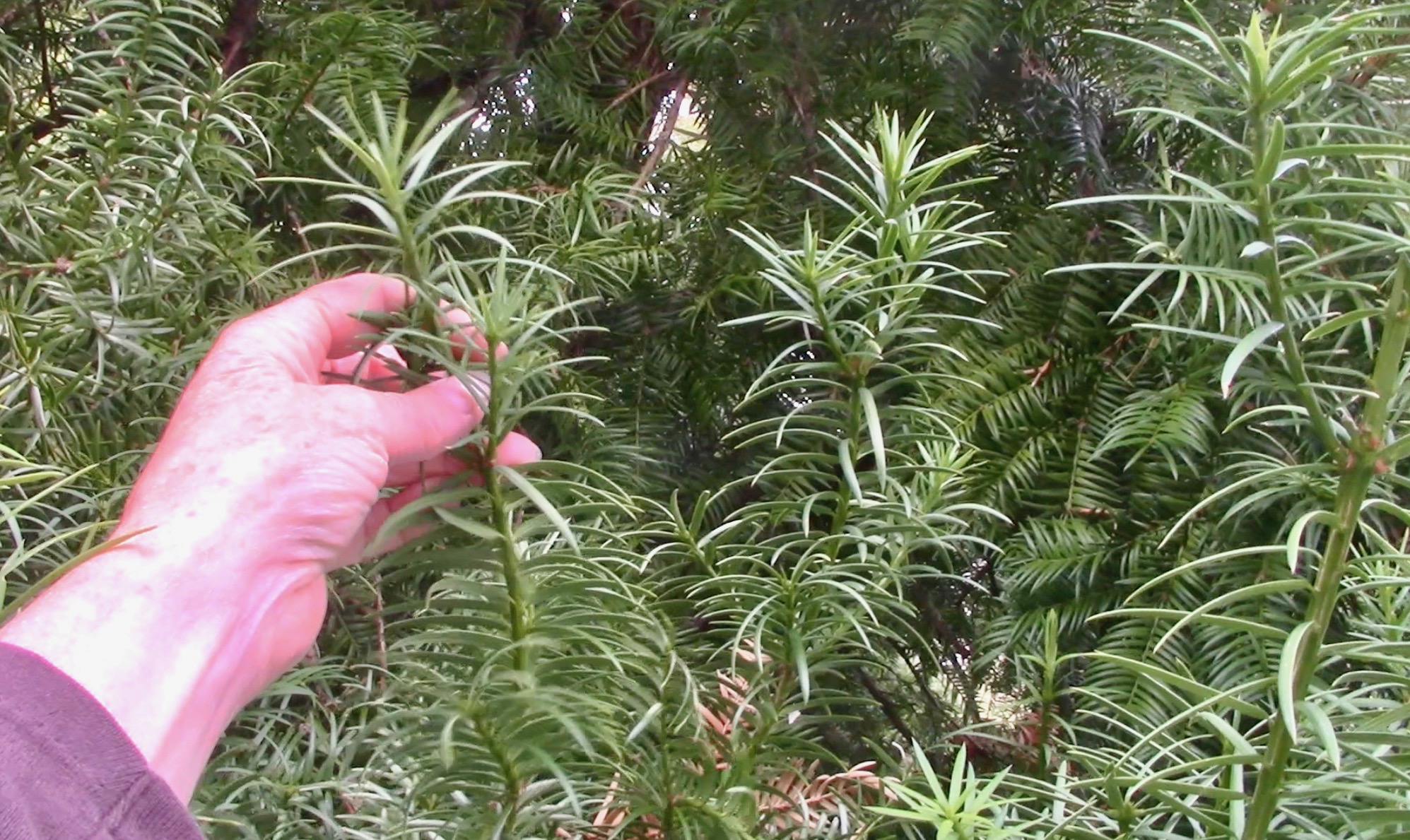
ABOVE and BELOW: A pair of 30-year-old FLORIDA TORREYA seedlings that grew into trees are in full sun at a private home in Medford, Oregon (where it is essential that they be watered during summer droughts). Especially along the sidewalk where lower branches have been pruned, the regrowth trends toward upright tips with radially patterned leafing structure (photo above). Because of the full sun, even the lower-most branches of both trees are still intact and leafy, and therefore contributing photosynthates (photo below).
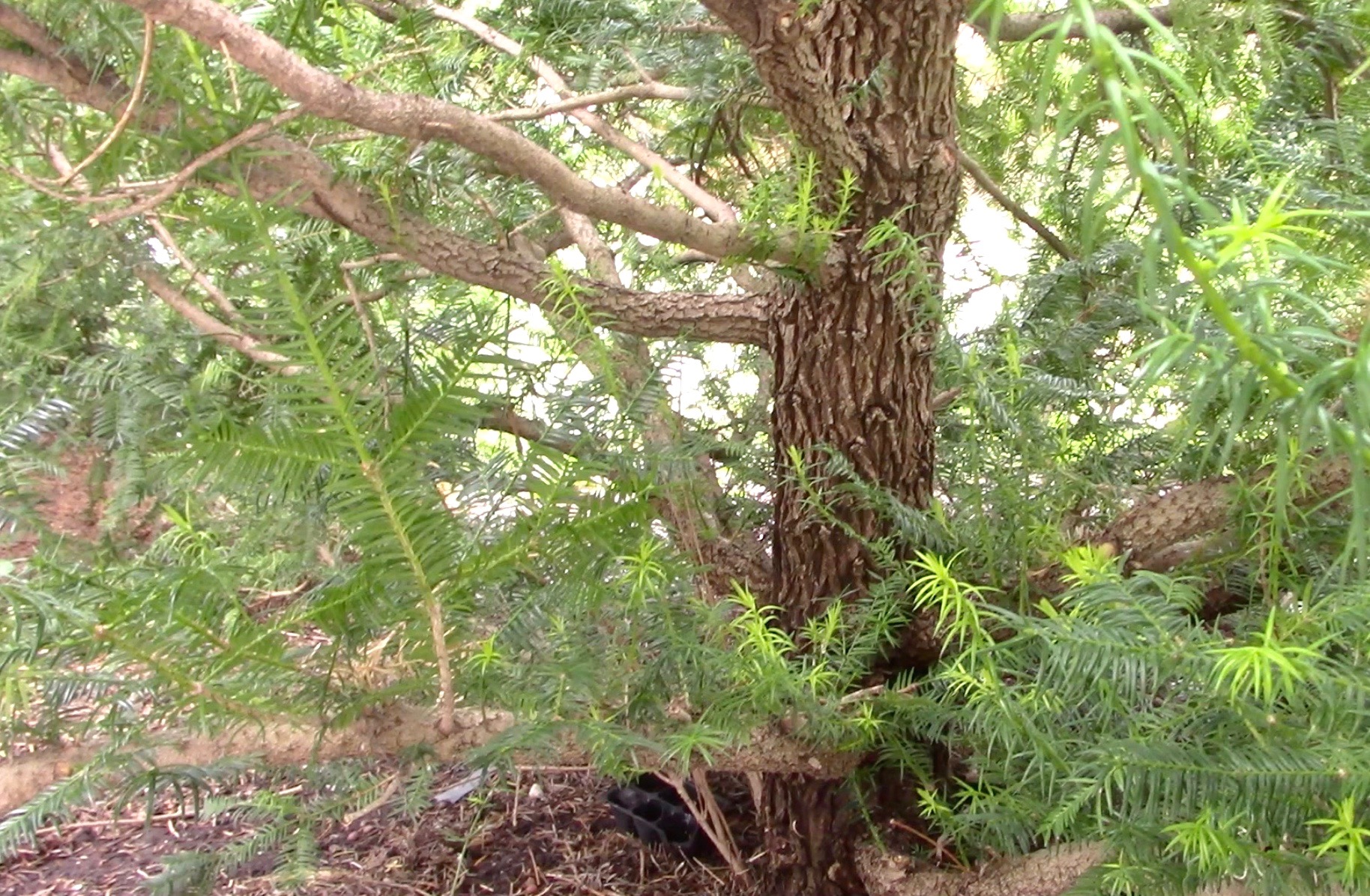
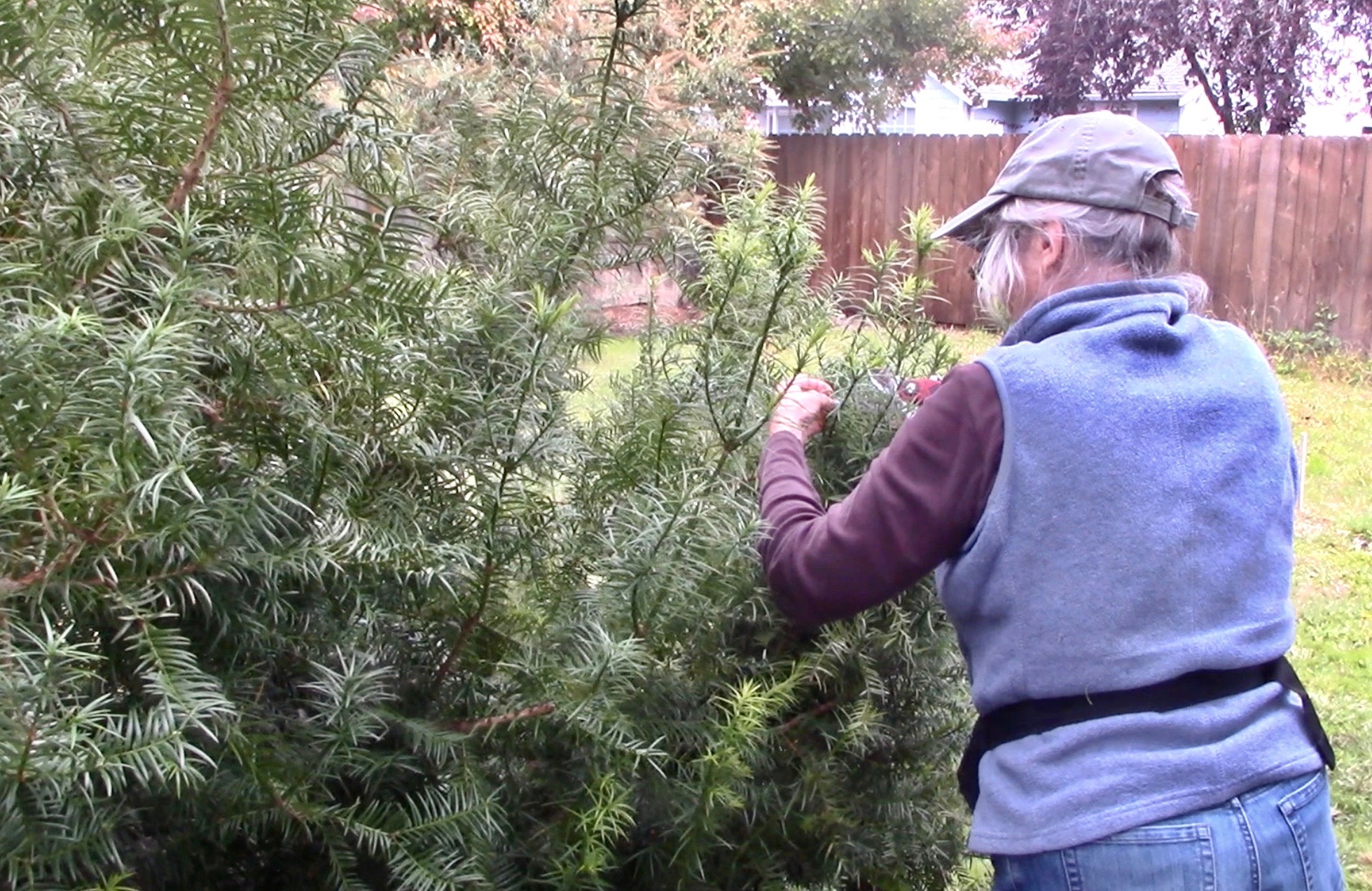
ABOVE: October 2019 Connie Barlow visited Frank Callahan, who had planted these torreyas. She received permission to cut some of the branch tips for rooting tests.
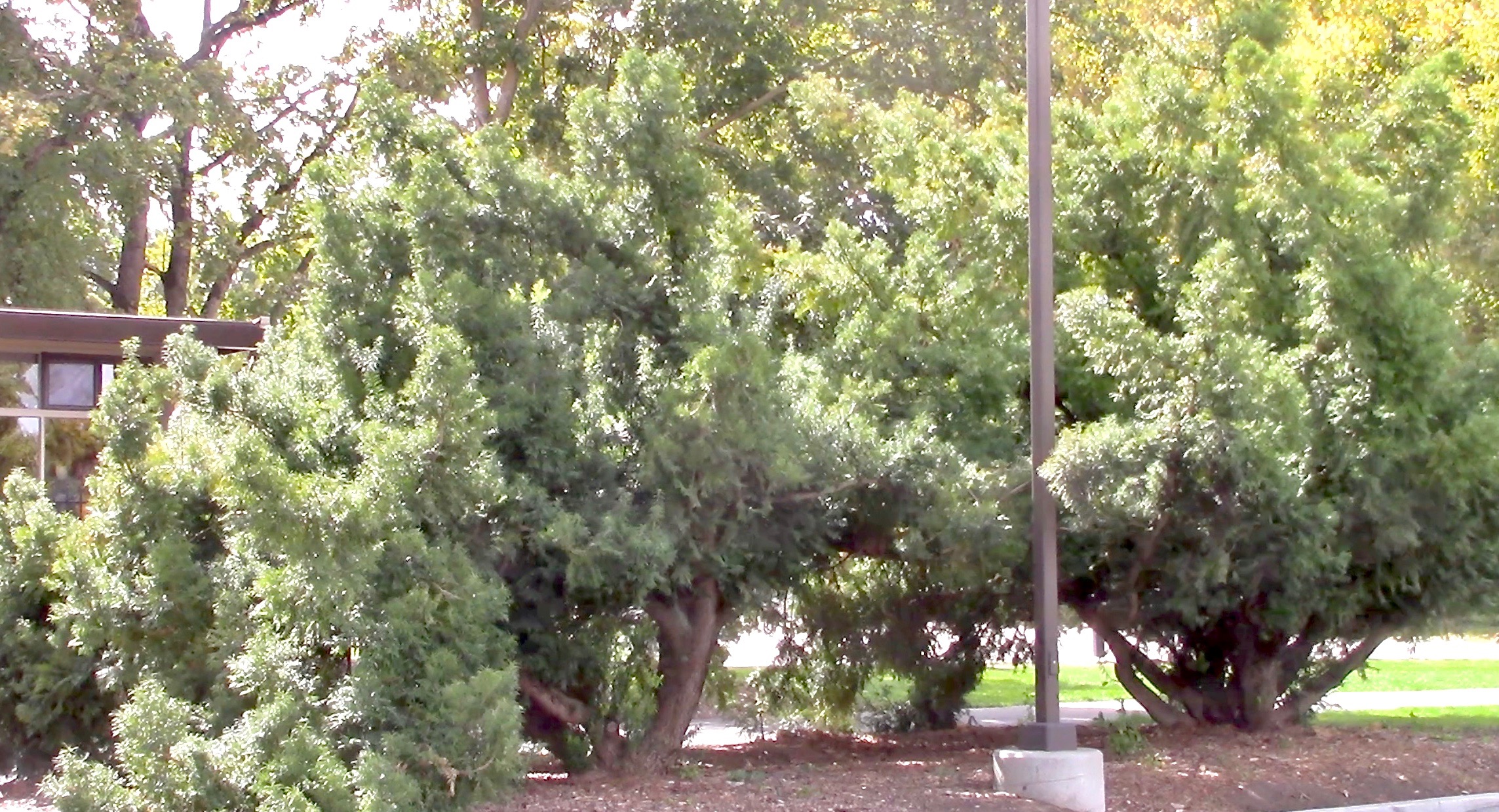
ABOVE: Equally old are two shrubby Florida Torreyas that Frank Callahan donated to Medford's Hawthorne Park. Originating from rooted branchlets, this pair is still growing in a multi-stemmed, angular ("plagiotropic") pattern.
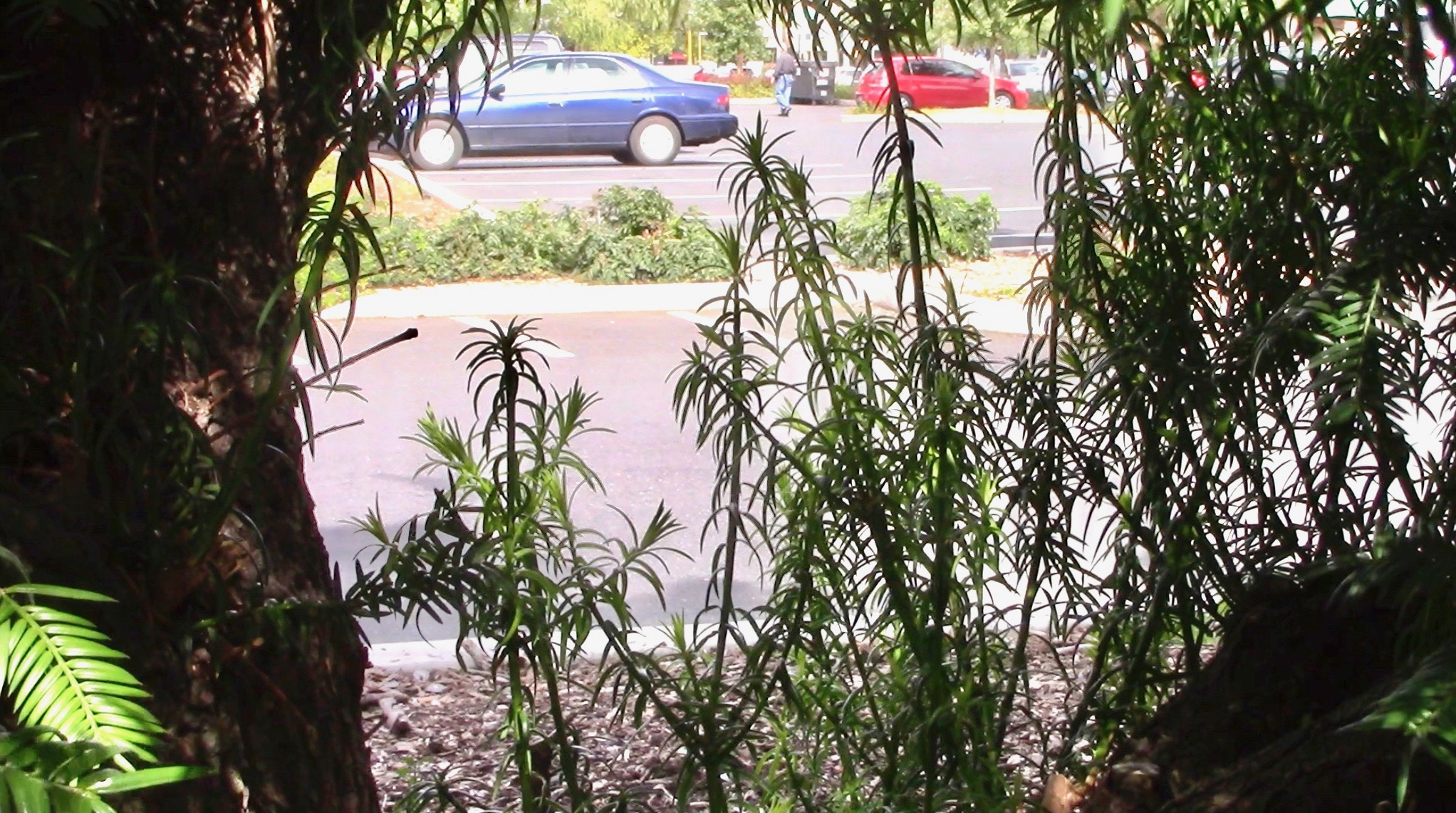
ABOVE and BELOW: Connie Barlow took cuttings from both of the shrubby torreyas. She selected the most vertical, radially tipped upward stems growing near the base, similar to true basal sprouts (photo above) and also on the outer branches (photo below).
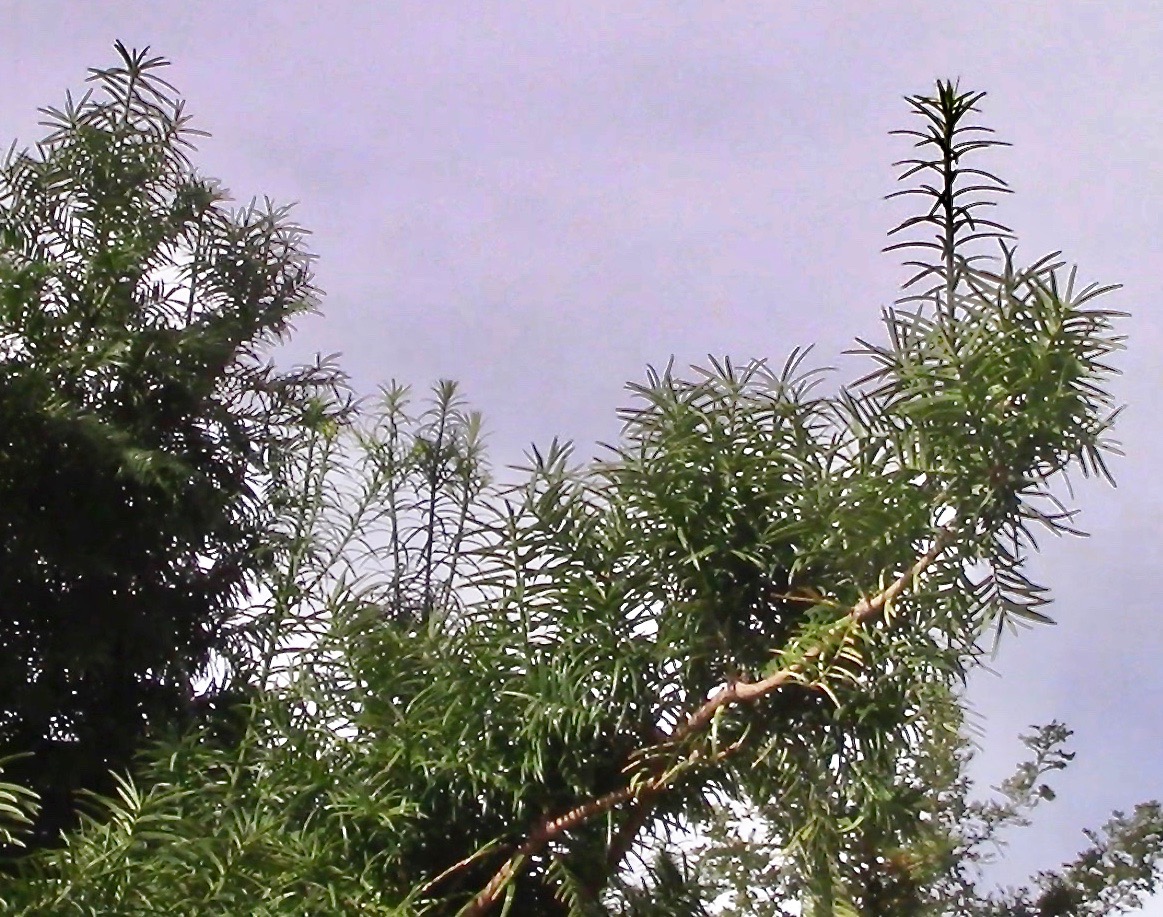
DESTINATION OF CUTTINGS: Connie sent half the cuttings to Jack Johnston in n. Georgia and to Clint Bancroft in sw Tennessee. Clint reported 5 months later (March 2020):
"Here's an update on the Medford OR cuttings that Connie sent me October 2019: The Medford cuttings were kind of stressed looking when they arrived and I thought their prognosis was guarded. As with any group of freshly collected cuttings, some perished rather quickly. It appears some of the rest have rooted. I have not tugged on them. They still look as good as when they first arrived. But that alone is not proof of root formation. I have had cuttings that still looked fresh after a couple of years under the cloche but which never rooted. They just keep their color for a long time. That explains why Mrs. Kennedy (Clinton, NC) prizes them for Christmas decor!"
Visit Clint's Torreya page to see these photos and many more of his progress reports.
RETURN to TOP
• CUTTINGS FROM TIPS AND BRANCHES OF BASAL SPROUTS OF THE COLUMBUS, GA TORREYA

ABOVE: The profusion of bright green growth are the lush branches of the tall basal sprouts of the last remaining century-plus Florida torreya in Columbus, GA. Two other torreyas of the same age had recently been cut down on this same block. The street is right along the Chattahoochee River.
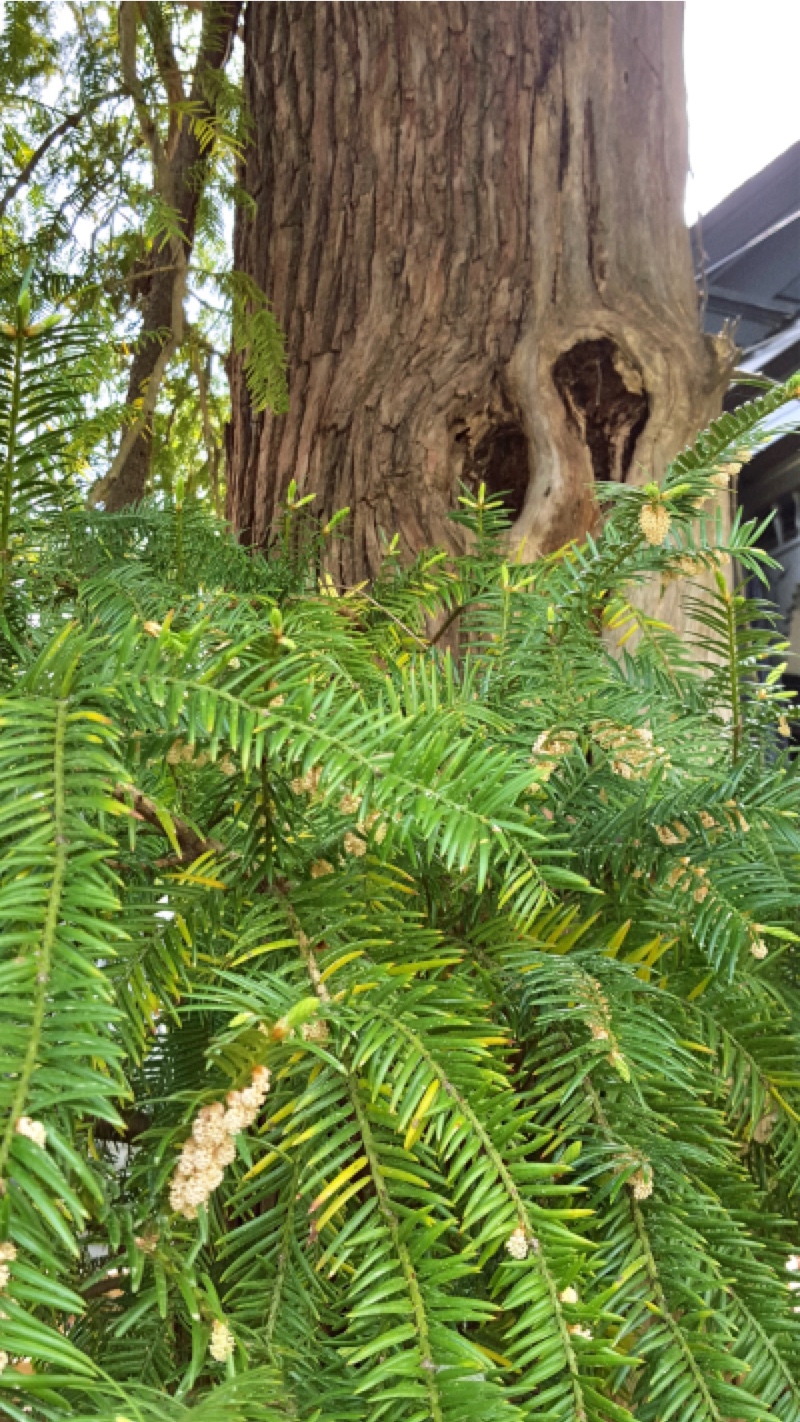 |
|
FEBRUARY 2015: Connie Barlow was the first Torreya Guardian to collect cuttings from the profusion of basal sprouts. At the time, she wasn't aware of the importance of basal stems, so she simply cut 3 leafy tips off the horizontal branches of the basals. Thus, if rooting were successful, plagiotropic rather than treelike growth would naturally follow.
Connie sent the cuttings to Jeff Morris in Spencer, NC for propagation. (Photo below.)
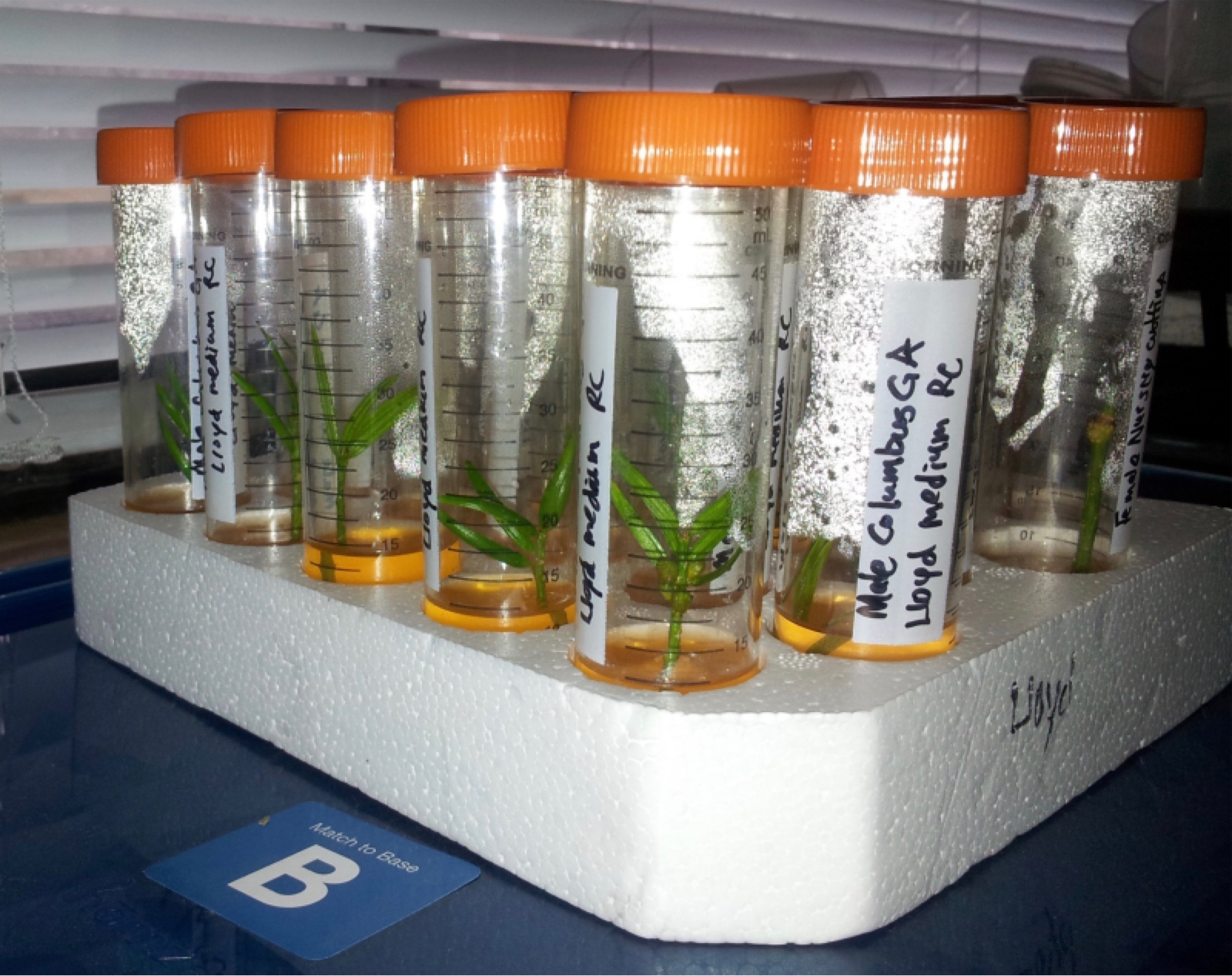
|
JEFF MORRIS wrote:
"I spent a large portion of yesterday afternoon preparing about 20 cuttings off the male branches you had sent to me, for micropropagation. I'm hoping the fungicide/biocide I used will prevent them from dampening off (molding). I should know within 3 weeks if this experimental method of reproducing Torreya taxifolia is going to be productive. It would be great to have a potentially new strain of genetic diversity to introduce to the species!
The micropropagation method we're using is designed to root the terminal shoots of the cuttings, as opposed to creating thousands of plants from a single needle. By using only the 'terminal' shoots, we should be able to propagate individual seedlings that grow upright.
Note: We need to learn the results of Jeff's experiment. This is especially the case because, at the time when he sent us the above photo of his rooting system, Jeff Morris may well have had the most success thus far in producing vertical growth from cut lateral branchlets. He wrote:
"The method we use in the greenhouse that has worked for me is to stake it with a metal tree stake for the season, and when there is no doubt as to the health of the root system, I carefully transplant it into a new pot. Two seasons of this, and I achieved an upright growth for two Torreya taxifolias. A third tree was not predisposed to this type of transplanting due to advanced growth of the root system that would have resulted in damage. But if it's less than 4 years since rooted, you'll probably have some success."
U.S. FOREST SERVICE colleagues concurred with Jeff, in part:
"In our collective view, if taken care of properly (tie the tops up, trim laterals) and conscientiously, they should forget that they're branches in 4-5 yrs and grow 'right'. So, just relax and go along with the flow. (But really, our collective view is to tell them to get seedlings!)"
NOVEMBER 2016: Jack Johnston and Clint Bancroft collected branchlets from the basal sprouts. Clint wrote:
"Jack Johnston and I made a pilgrimage to Columbus where we collected 6 gallon-size bags of cuttings from the old Torreya. These have been distributed among four different propagators, so we hope for the best. I have probably a hundred cuttings myself, so if we have even modest success we will have succeeded in saving the genes of this venerable tree.
"Jack and I were able to measure the living tree's circumference. At four feet from the ground it measures an impressive 80 inches!"
"All the cuttings we took from the Columbus tree are upper portions of the basal sprouts. I told the owner to never let anyone remove them completely from the base of the tree. The basal sprouts were 3 to 4 feet tall."
UPDATE 28 SEPT 2017: Clint Bancroft reports that of 3 propagators of the branchlets cut in 2016, only his have rooted and stayed alive. He grew his "under domes":
"It appears I have had success with the Columbus, Georgia cuttings. Not 100% survived but it appears many did. Jack Johnston lost all of his portion, as did Nearly Native Nursery in Fayetteville, GA. I don't know what technique was tried in Fayetteville, but Jack tried rooting his in plastic bags. I grew mine under domes, and kept some outdoors and some indoors the first Winter. I did try a few in a sealed container (not unlike a plastic bag) and lost ALL of that bunch after they had survived the Winter (these were kept indoors in an unheated room) and had even put on new growth in Spring, but then all turned brown within days of each other and suffered what we (in Anesthesia) used to call "severe death". So maybe trying to root them in sealed containers is not a good option. It appears so."
UPDATE 11 OCTOBER 2017: Clint Bancroft reports:
"I previously wrote you about Jack Johnston's having lost all of his cuttings from the Torreya in Columbus, GA. Jack had put his cuttings in pots sealed in zip lock bags. I, on the other hand, appear to have had success with all the Columbus tree cuttings that I kept under domes (cloches). I lost all of the ones I put into pots, using the same medium as the ones under domes, and putting the pots into a sealed plastic storage box (essentially like a zip lock bag).
"I told you that Jim, at Nearly Native Nursery in Fayetteville, GA, had also received Columbus cuttings from us. I knew from Jack Johnston that all Jim's cuttings had died, but at the time I wrote you I did not know how Jim had handled his cuttings. Today I saw him for the first time since we gave him the cuttings last November. I asked him how he had handled his Columbus cuttings and he said, "I followed Jack's lead and put them in zip lock bags!" Of course this proves nothing (or does it?) but it seems that rooting cuttings in sealed bags (or sealed plastic storage boxes in my case) yields negative results. My guess is that while the cutting itself needs continual high humidity, the soil needs exposure to fresh air. Using the dome technique the soil around the dome is exposed to ambient air whereas with the sealed techniques the soil is not exposed to fresh air or movement of air. I tried rooting a bunch of round leaf birch cuttings this summer and used zip lock bags since I was out of domes. I lost every single cutting."
20 FEBRUARY 2018: CLINT BANCROFT reports:
"The original Columbus cuttings are rooted and Jack Johnston said "they look fabulous". I have made 2 more trips through Columbus and took more cuttings in Dec. 2017 and Feb. 2018. The big tree there still looks healthy in spite of its many scars."
26 SEPTEMBER 2019: Clint Bancroft reports:
"The first Columbus cuttings Jack and I collected in October several years ago have not done well at all. Jack and Jim (Mail Order Natives) lost all of theirs. I had them to root and look good until spring whereupon most died. I still have maybe 3 of that batch left. Not a one has put on any new growth in, I believe, 3 years. Maybe October is not an optimal time but that was only an isolated instance."
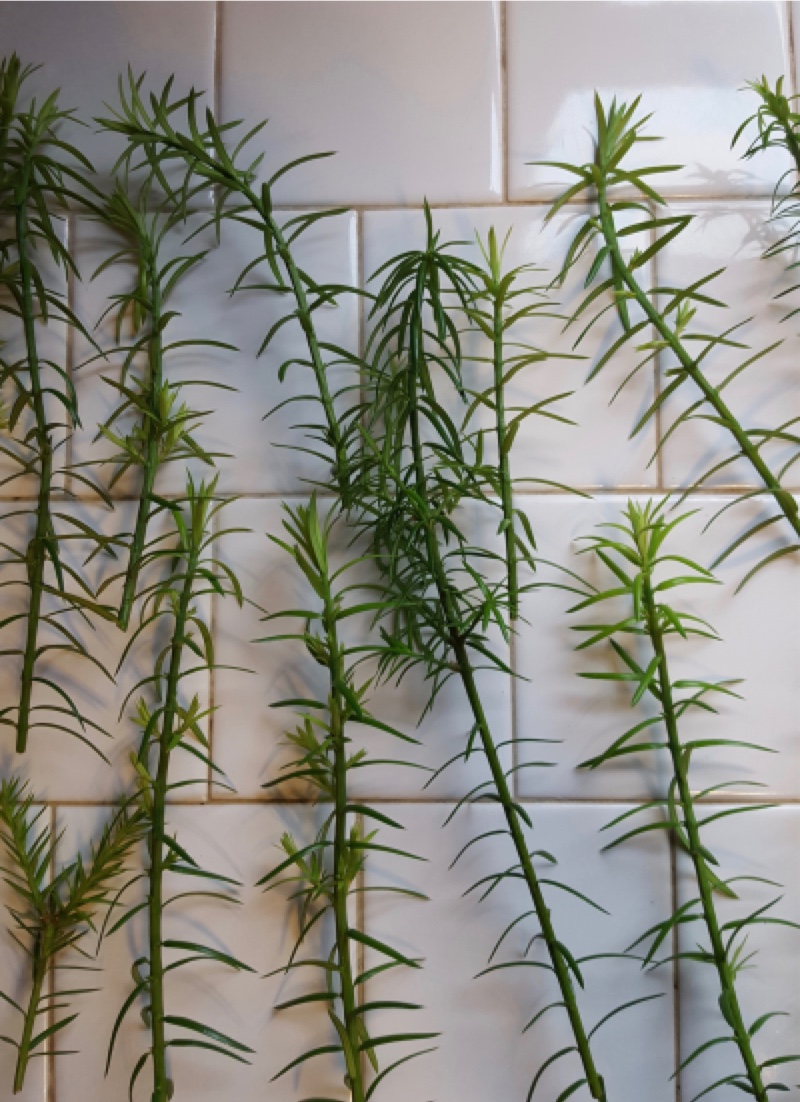 |
|
PHOTO LEFT: 16 SEPTEMBER 2019
Clint Bancroft reports:
"The 16 apicals I got from my last Columbus trip seem to be doing very well. And as we learned from the Highlands apical cutttings, they continue to grow with radial symmetry!
"... The Columbus cuttings in the picture were carried home in no particular position in a zip lock bag, refrigerated overnight, and by the next morning each one was under a cloche. They were not kept in an upright position during transport but were vertical within 24 hours. The way they look in the photo (left) was how they looked when cut."
|
4 OCTOBER 2019 UPDATE: Clint writes:
"One, and only one, of the last cuttings I got from Columbus wilted at the tip after it was stuck. I kept all the cuttings indoors. They are still indoors. I moved the wilted one into deeper shade (indoors) and it slowly perked up and eventually rooted."
RETURN to TOP
6. Bark beetle evidence on fallen branch of
old Coast Redwood
at Prairie Creek State Park
September 2019
photo-essay by Connie Barlow
|
The photos below document the ability of bark beetles to penetrate the thin bark of high branches of Coast Redwood. A common misunderstanding is that bark beetles cannot hurt this species because its bark is too thick and stringy for a beetle to penetrate. That is true, however, only of the vertical trunk itself. High up in the branches, the beetles may be active — and would have coevolved in a commensal relationship with the tree. Here is how:
Coast Redwood self-prunes as it grows taller. This is especially true on any side of the trunk that is shaded by another tree. When self-pruning, the tree shuts down sap delivery to the branch. That enables beetles to burrow through the thin bark without being pushed out by a gush of flowing sap once the cambium layers are penetrated.
Under drought conditions, a tree might greatly reduce photosynthesis and transpiration, along with a corresponding reduction in sap flowing through its canopy. During drought, bark beetles can enter and lay eggs in the living tissue — even though the tree's behavior has nothing to do with self-pruning. Thus far, bark beetle entry into branch cambium in ways that can result in tree death has been documented only in Giant Sequoia groves of the Sierras — not yet in coastal redwood groves.
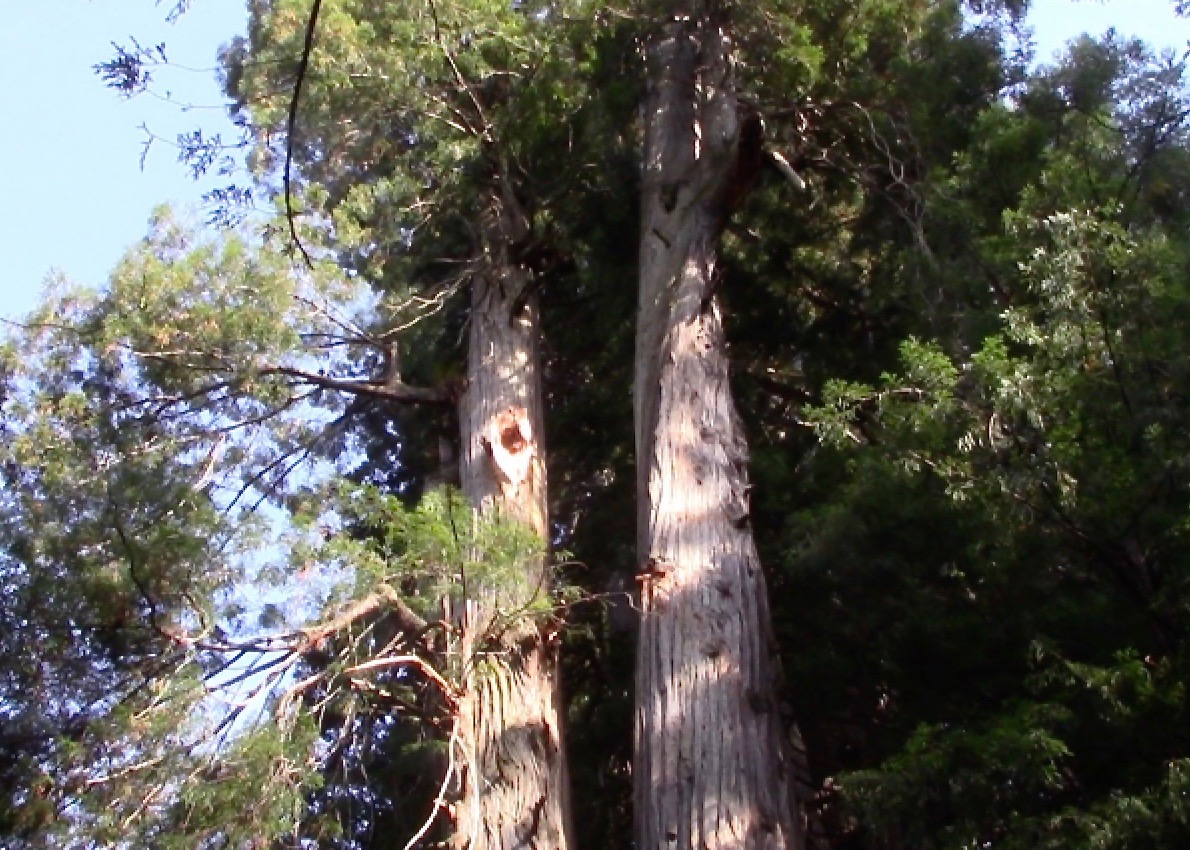
ABOVE and BELOW: Wound of fallen branch on a large double-stemmed redwood at forest edge, sunny side at 9:00 a.m. September 30, 2019. The small visitor center alongside Elk Creek Campground is directly behind photographer Connie Barlow. Staff told Barlow that the branch fell off about a week before. Notice the greenery of another elbow branch directly below the large wound, and a smaller horizontal branch directly above the wound and stretching toward the left but with a vertical stem emerging from it near the main trunk.
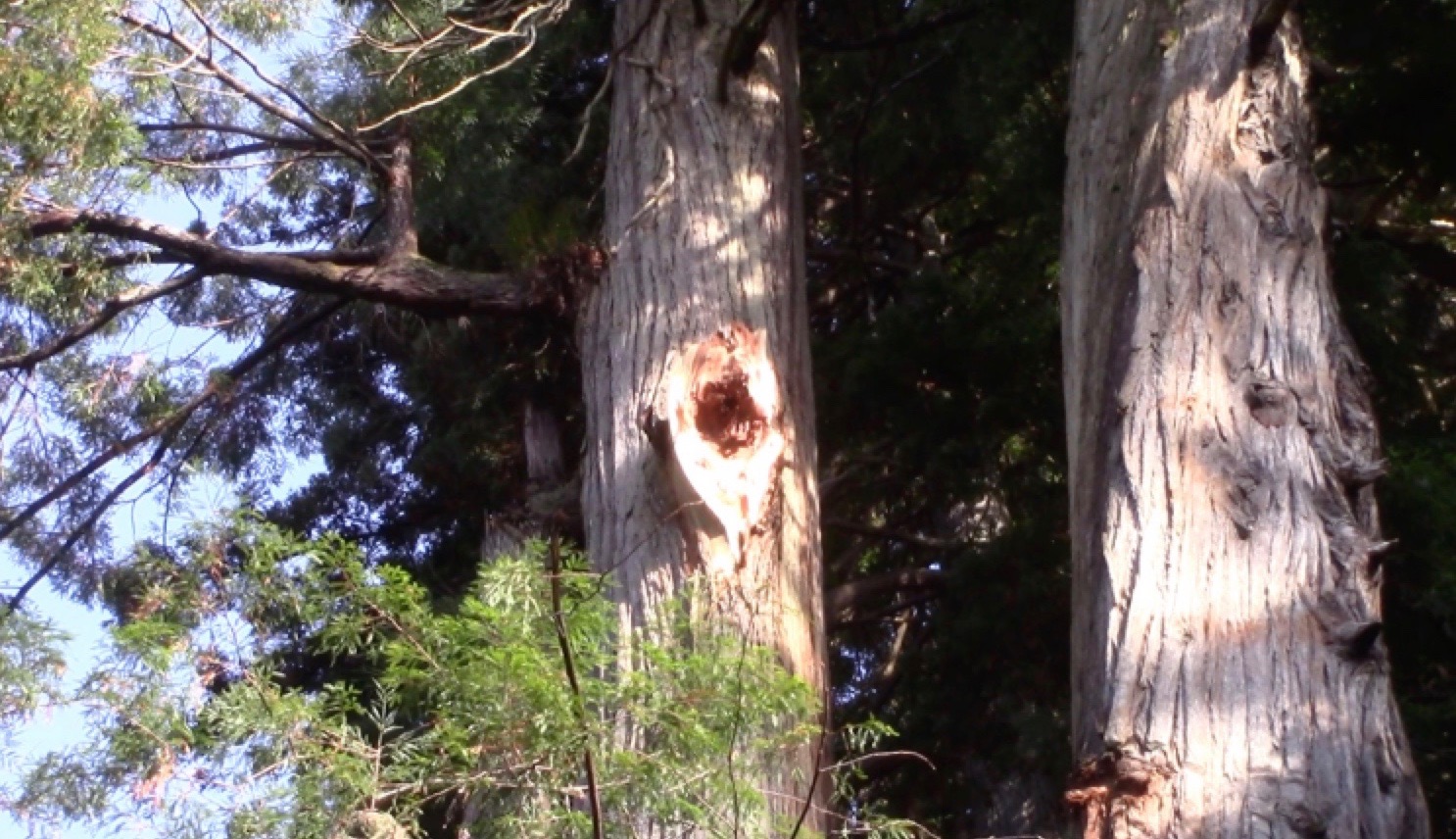
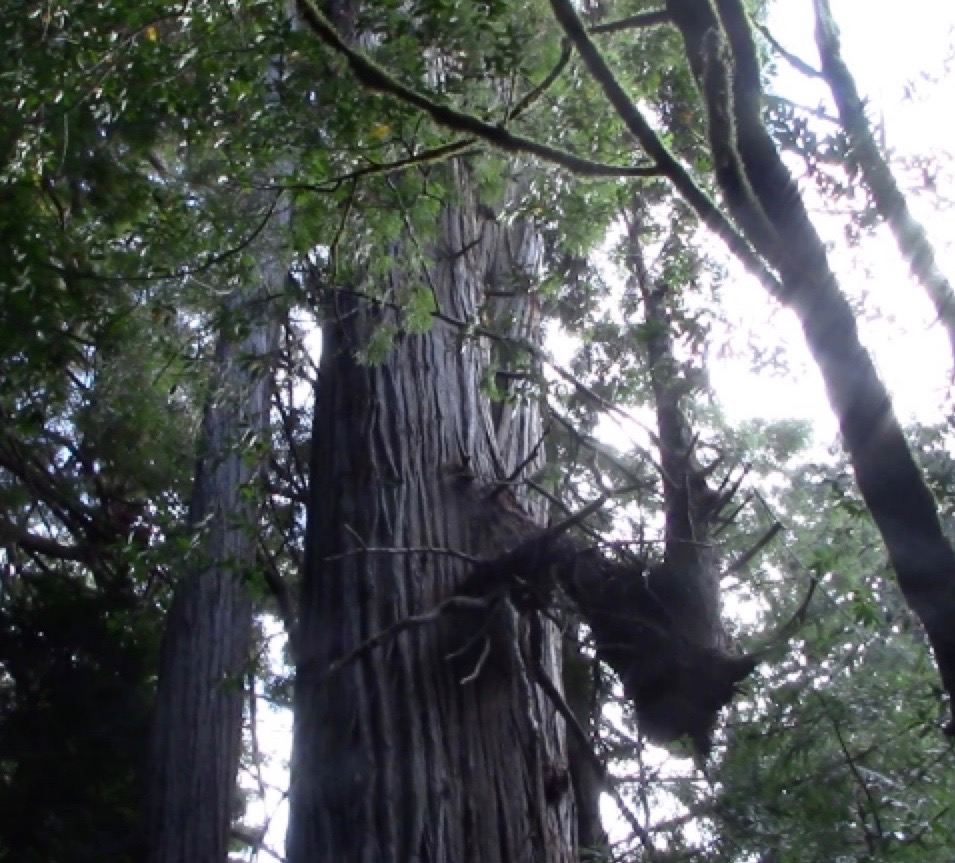
ABOVE: Side view of the elbow branch still living whose top green portion is visible at the bottom of the first two photos above. So the elbow branch that fell was above this still green and healthy one, though possibly part of the upright trunk on this lower elbow was broken off too.
BELOW: Barlow has only (and rarely) seen this fern species on low or fallen branches of redwoods. Here it emerges directly from the underside of the elbow section of the fallen big branch. Notice healthy reproductive (male?) buds at far left of photo.
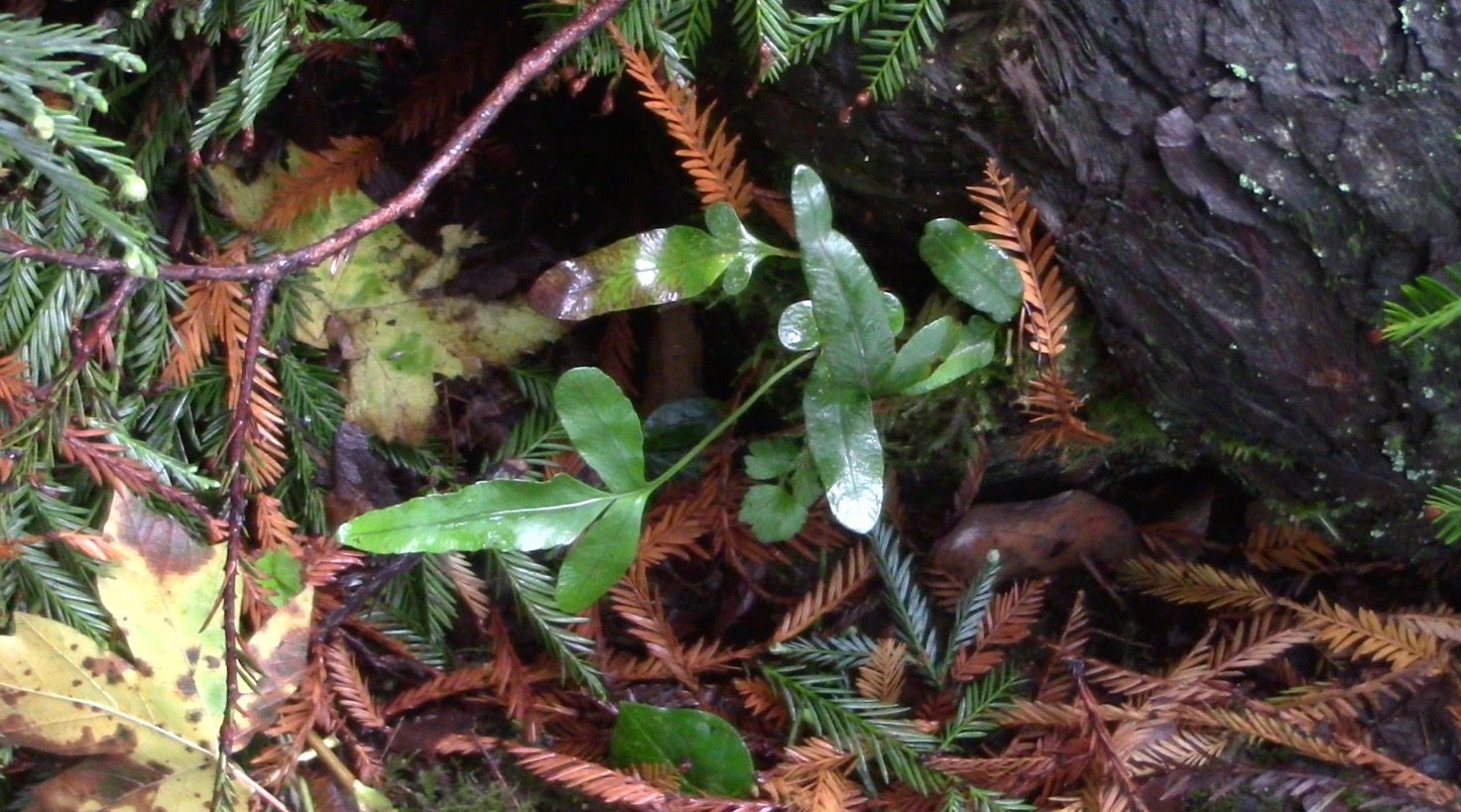
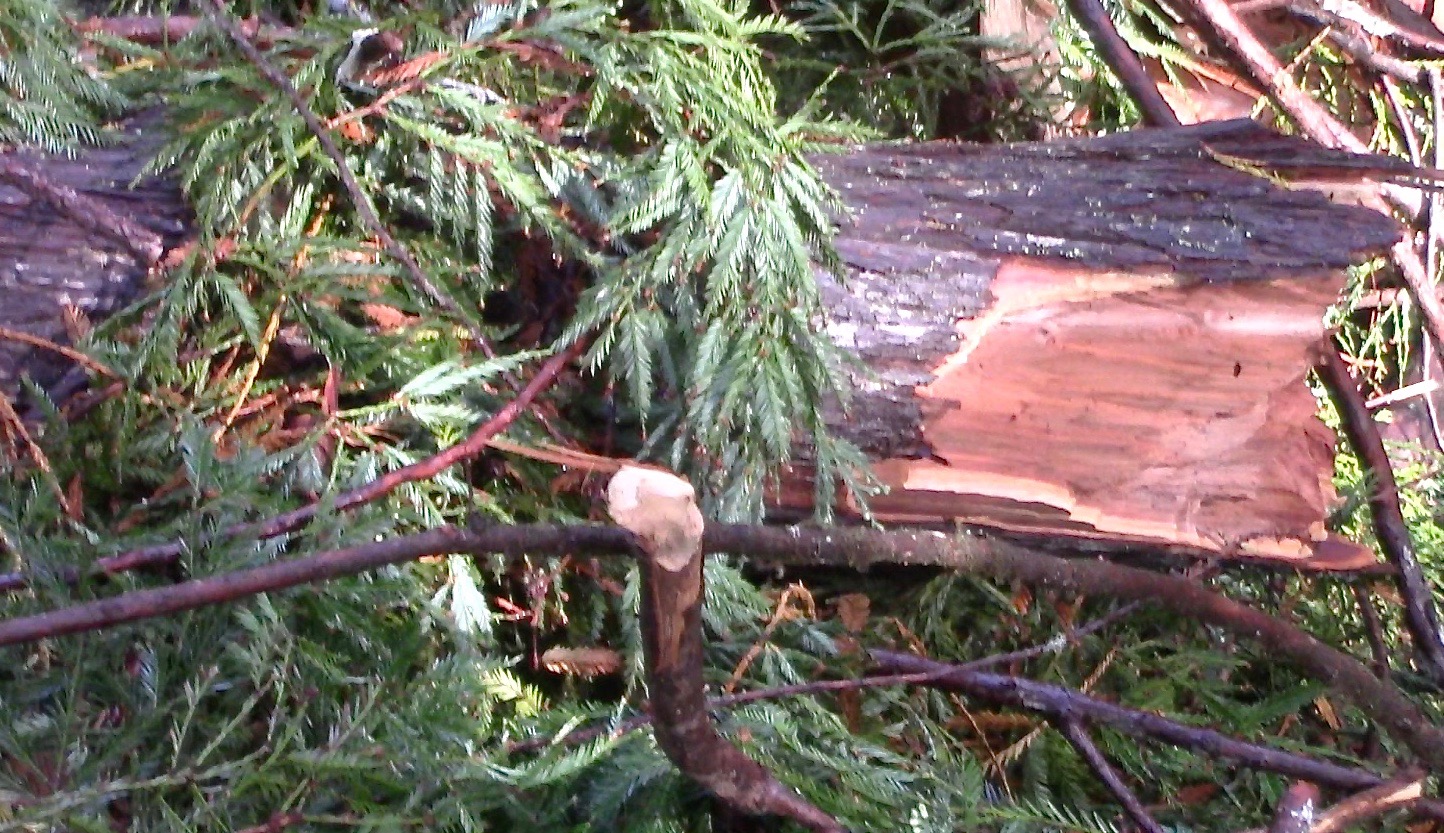
ABOVE: The ground area was a jumble of broken branch and lots of lush green leafy little branches. Here you can see how thin the purplish branch bark is. A group of perhaps 20 green full-size cones attached to healthy green branchlets were easily visible in one section of fallen greenery, without Connie having to dig through the jumble.
BELOW: While staff was watching, Barlow pointed out a section of purple bark that had bark beetle holes in it. Barlow then peeled away bark with her fingers, revealing tunnels created by the beetle larvae. Tunnels are evident both on the wood itself and on the inner side of the easy-to-remove bark, a section of which is shown below. Notice the 2 black holes on the left side of the inner bark; more are clearly visible on the outer side of the same bark piece. The inner bark side reveals the "gallery tunnel" structure.
Barlow donated this bark sample to staff at the visitor center, then posted photos on this new webpage. She alerted National Park Service staff to this photo-essay and thereby to the possibility that, as with Giant Sequoias in the Sierra parks, beetle damage could become severe in stressed Coast Redwood — and at a height not visible from the ground.
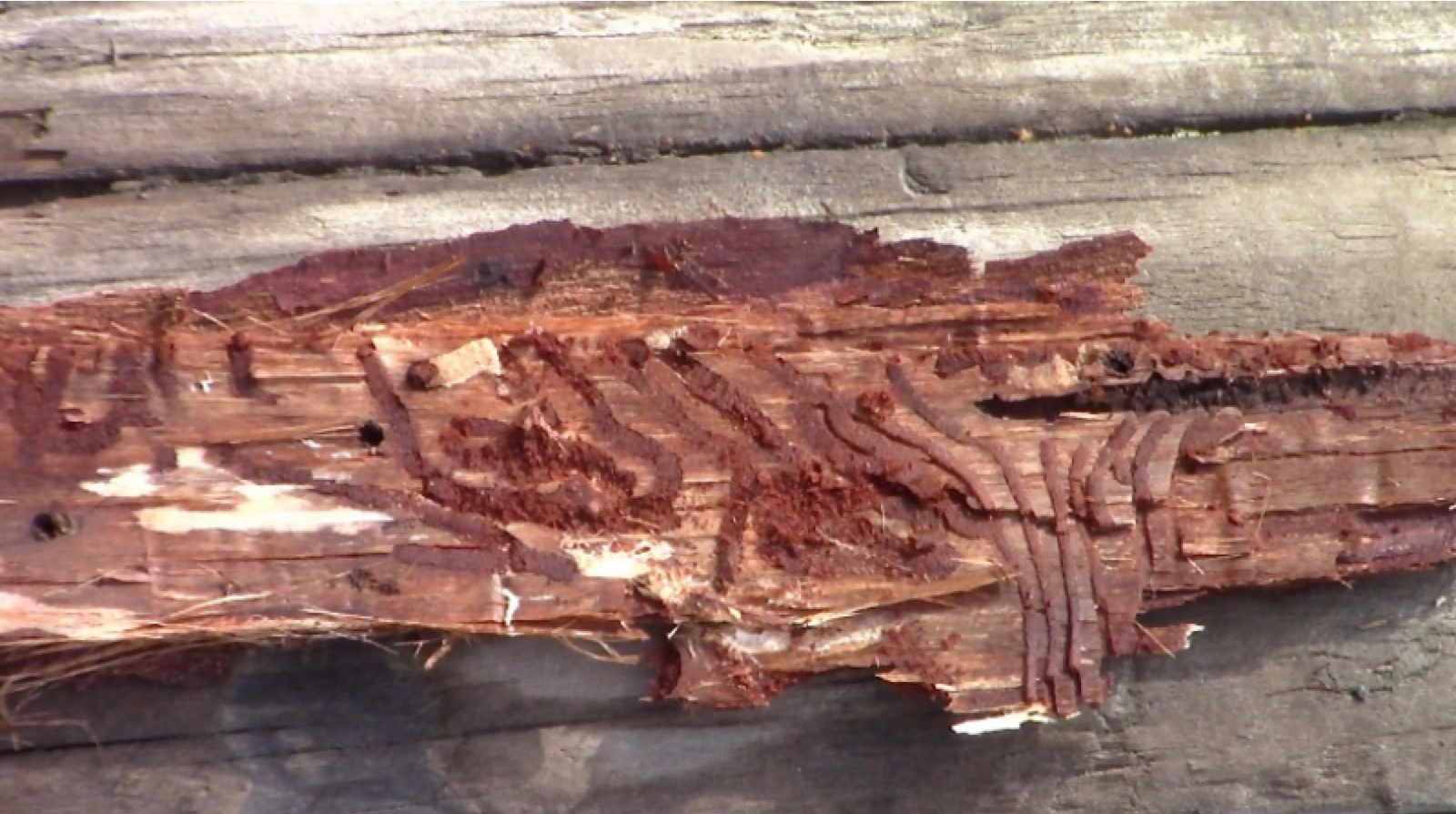
RETURN to TOP
|
|
Contact Connie Barlow OR
Contact Fred Bess
Return to HOME PAGE
Annotated List of Papers/Reports Online re Assisted Migration